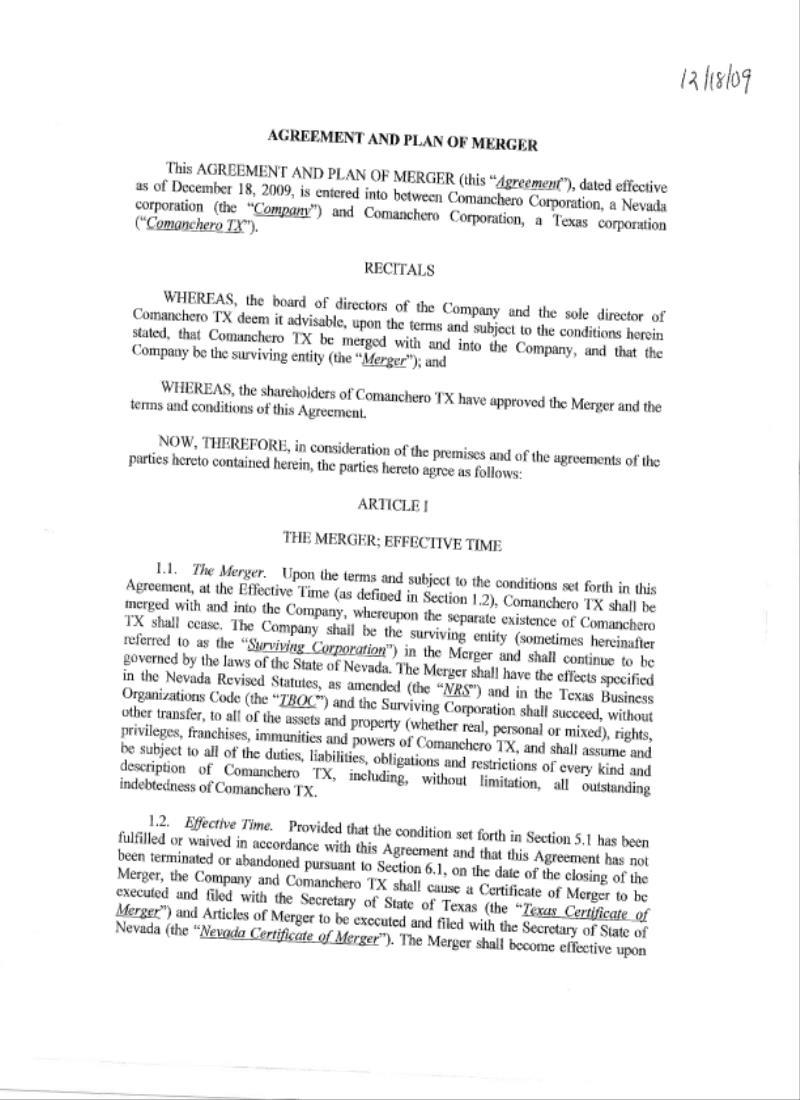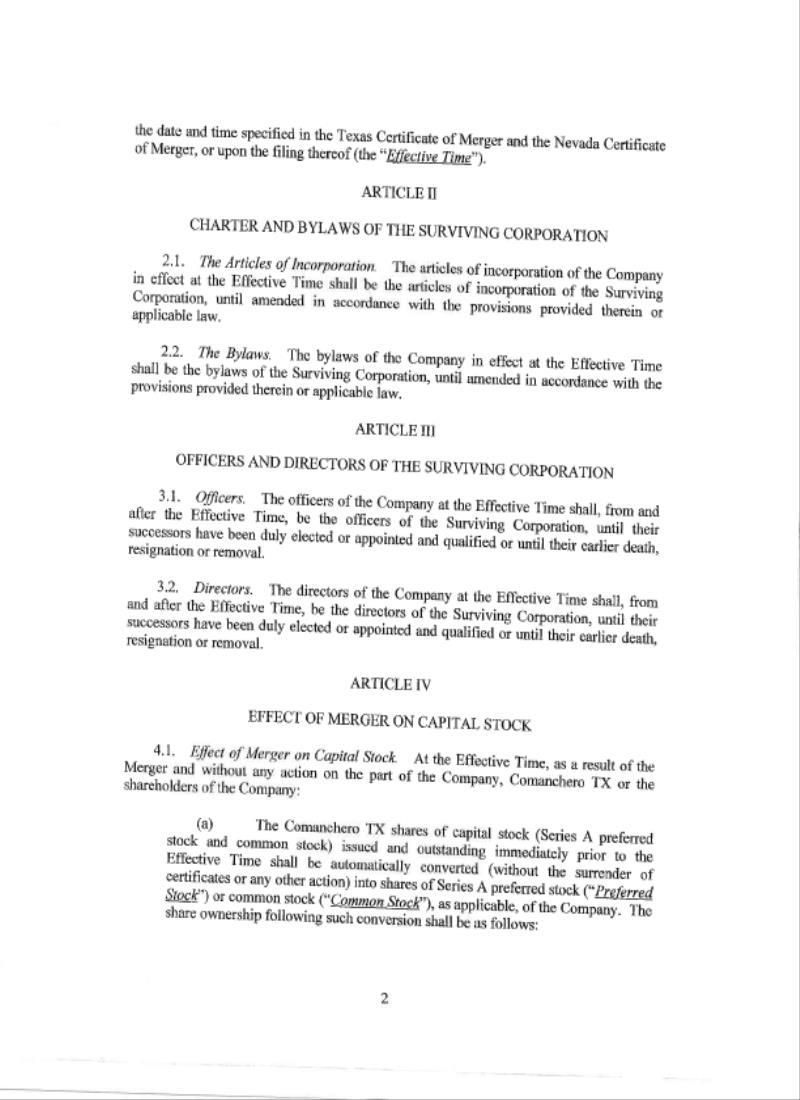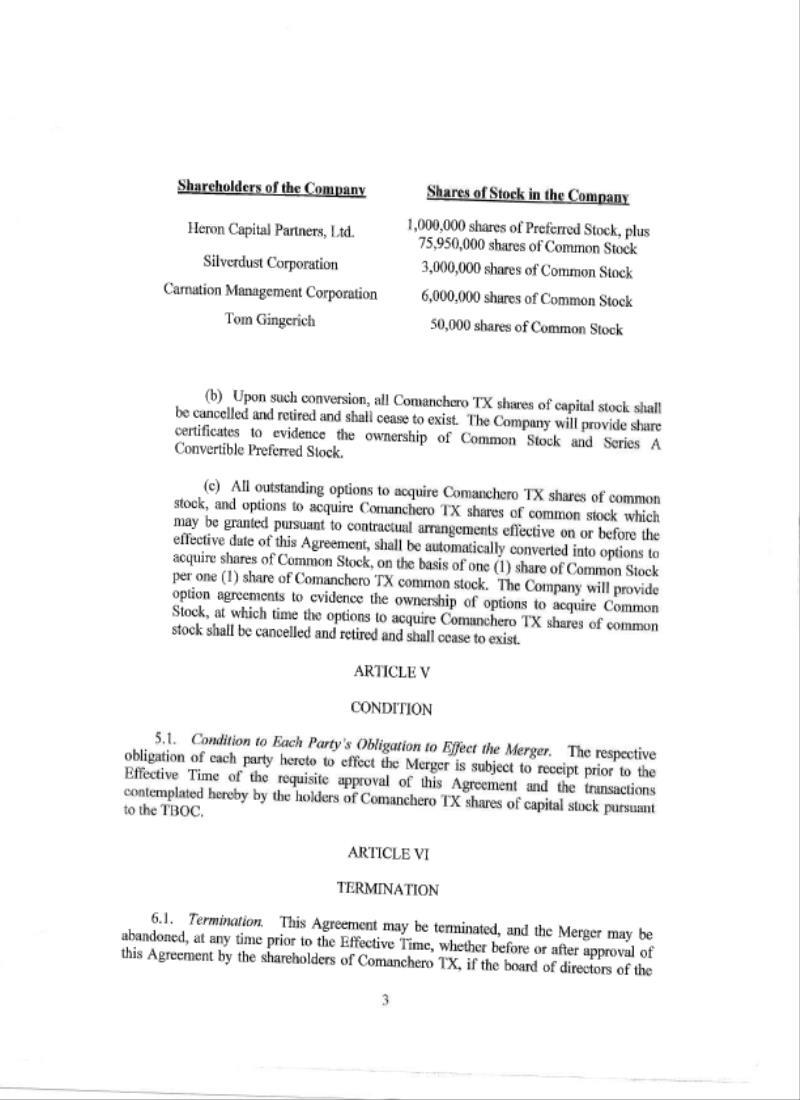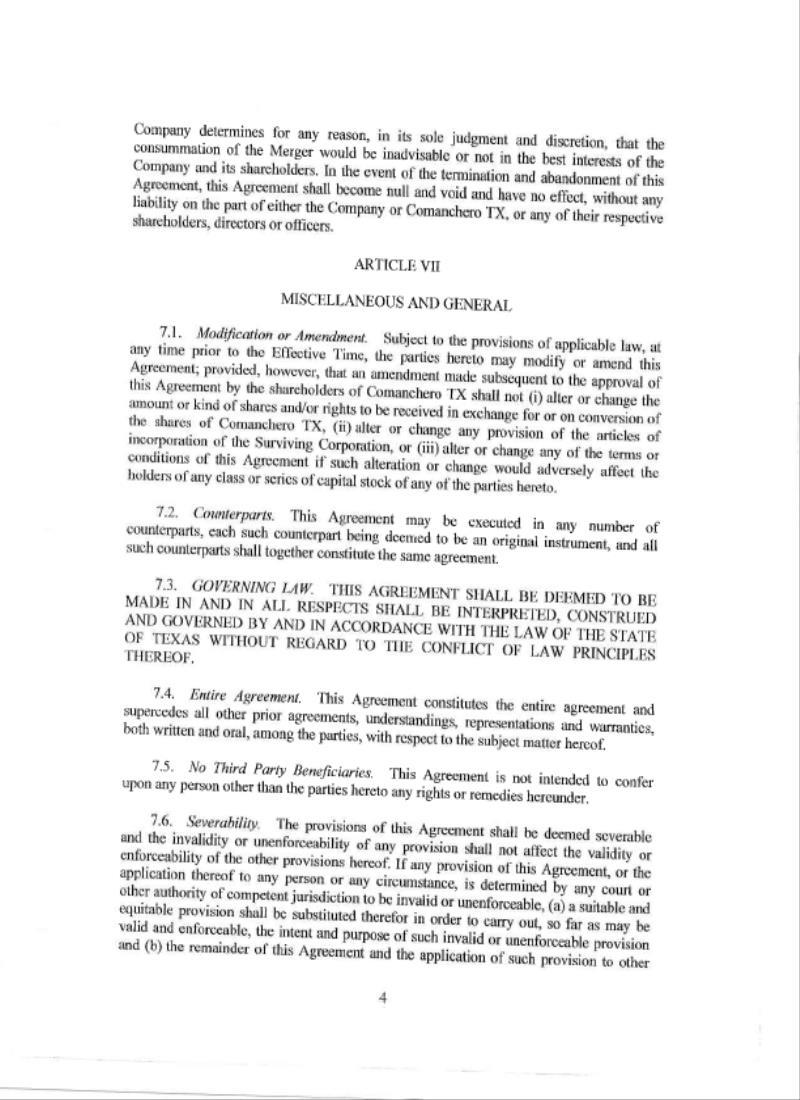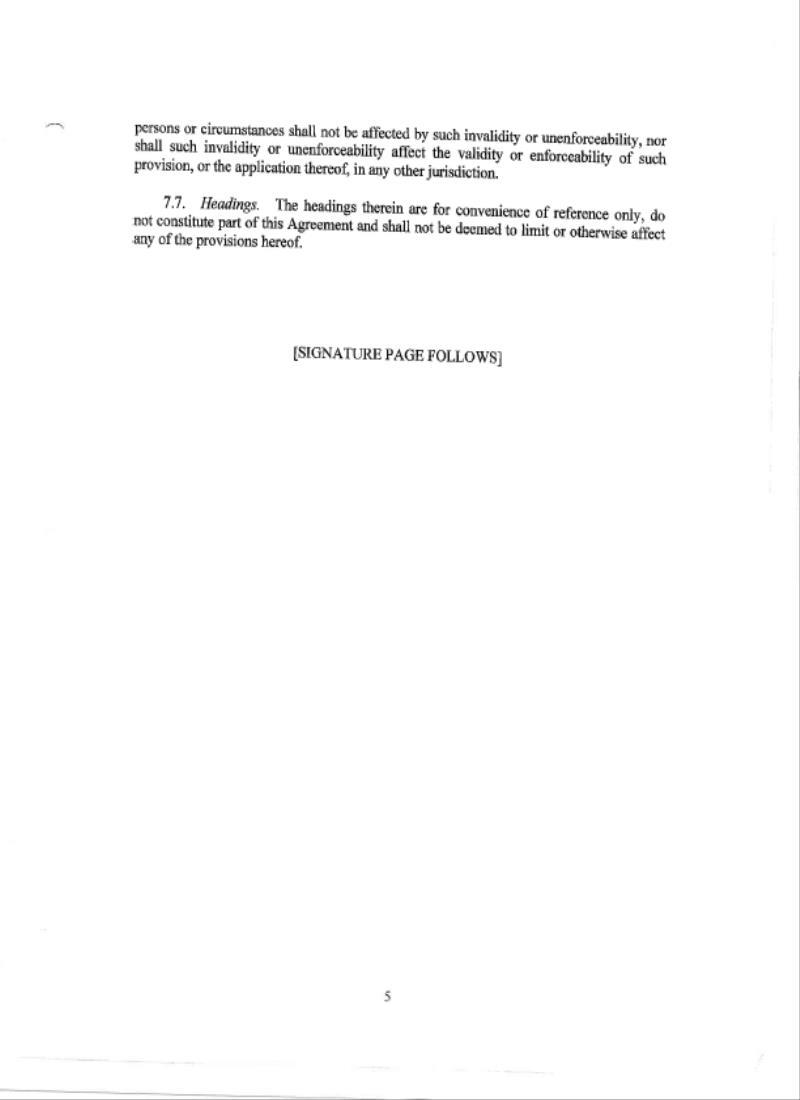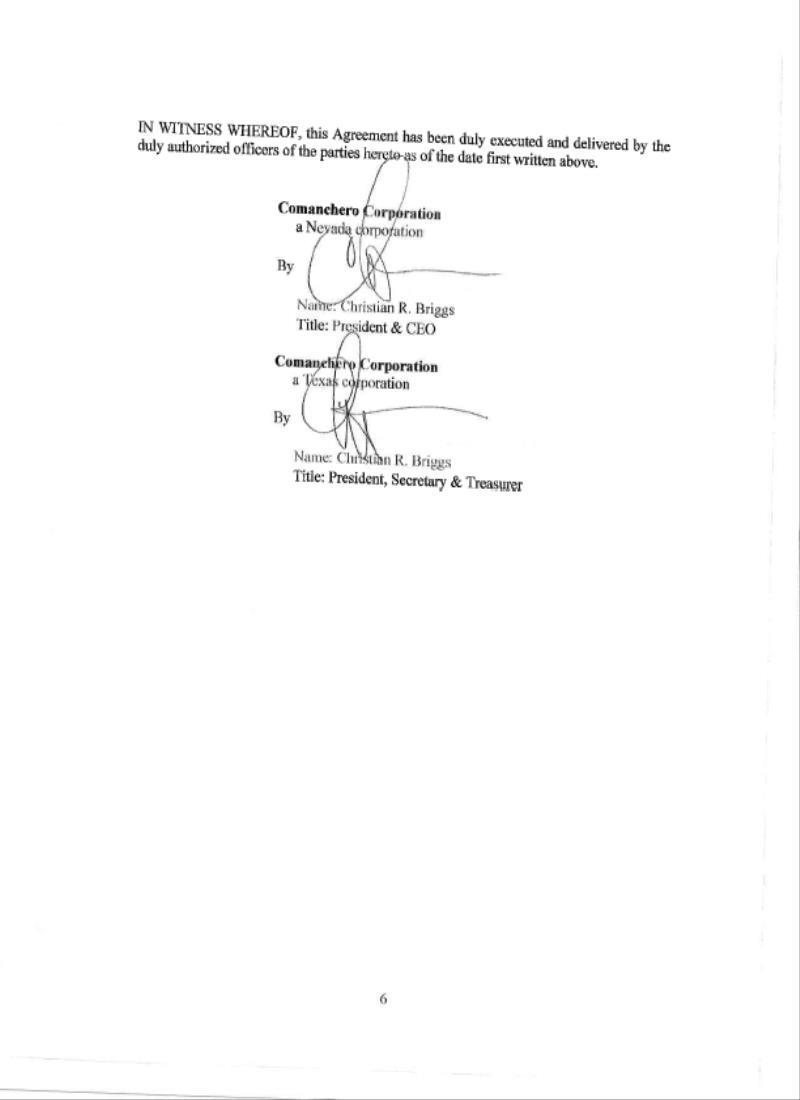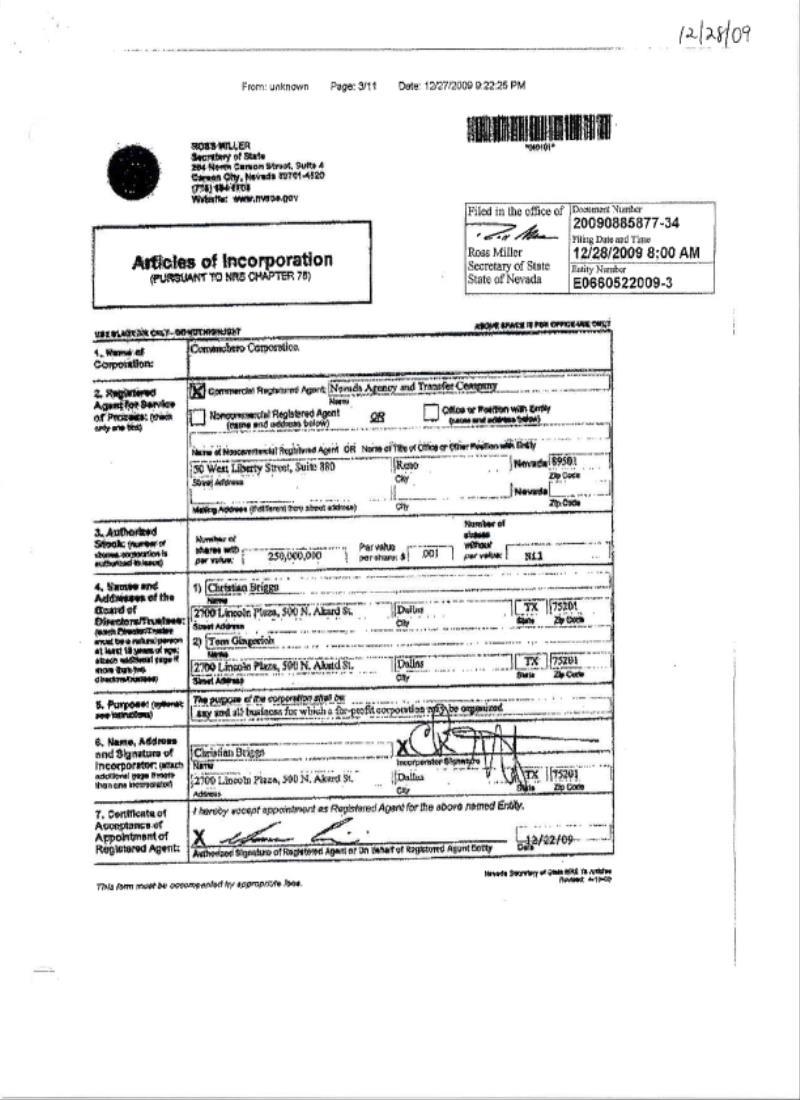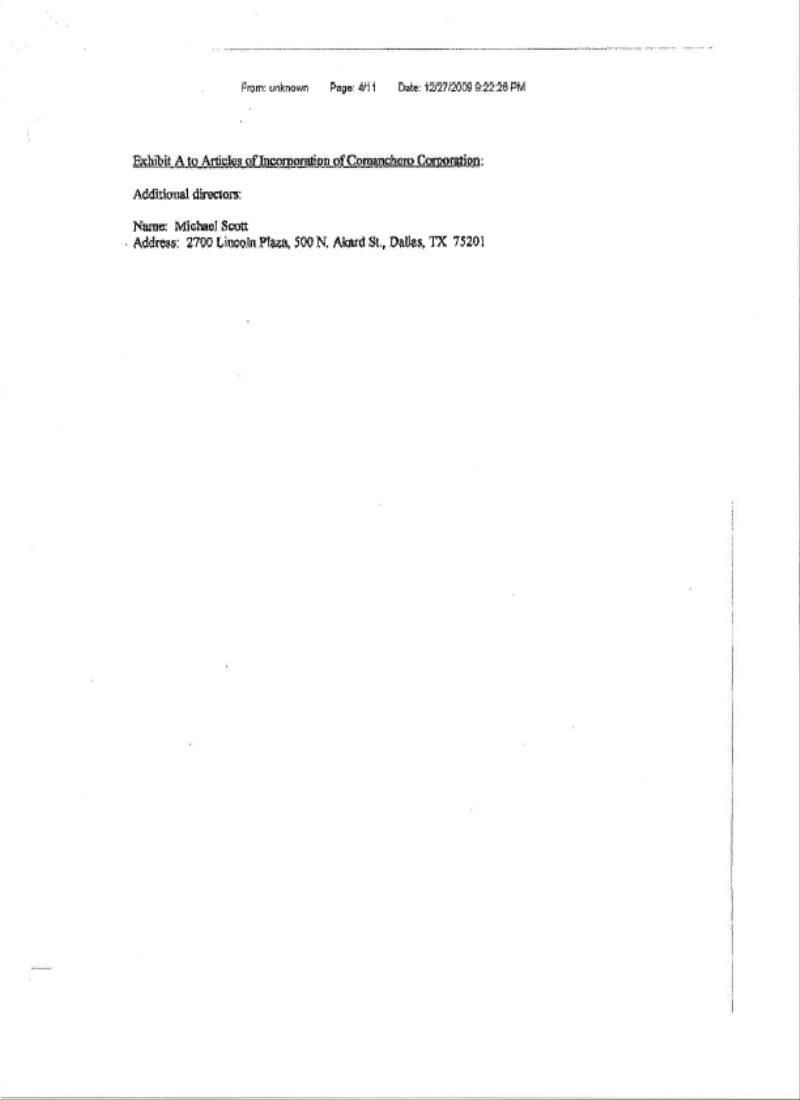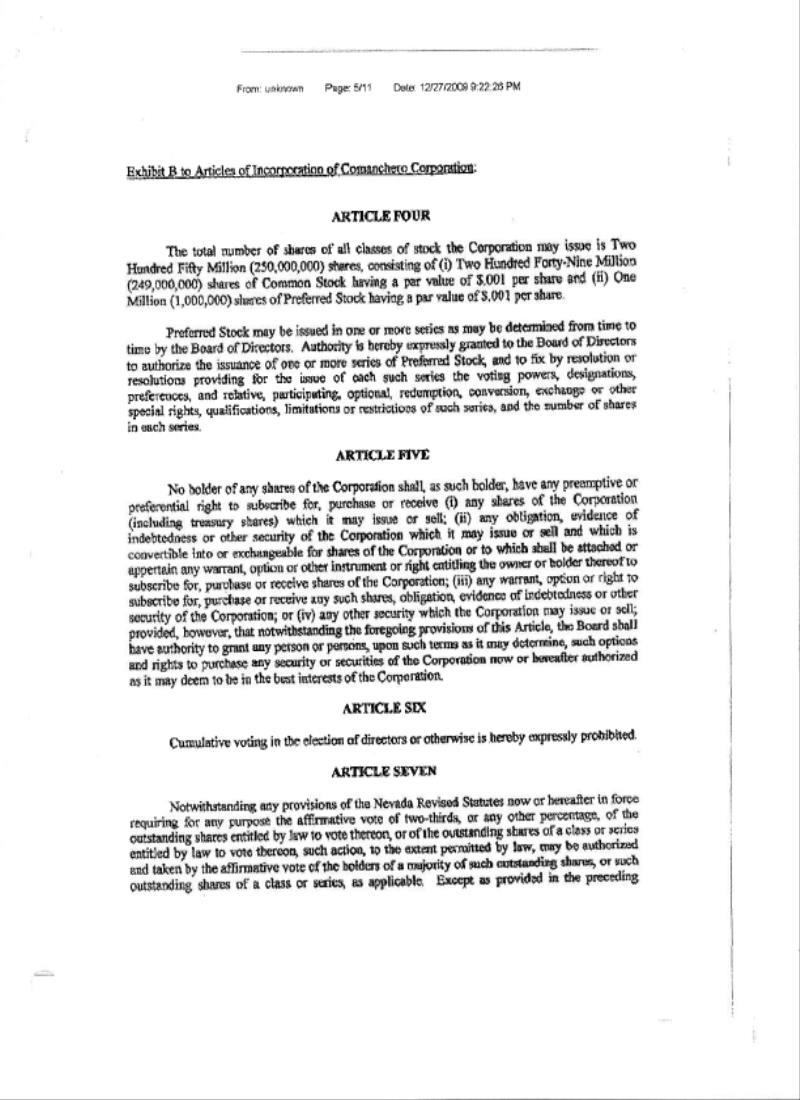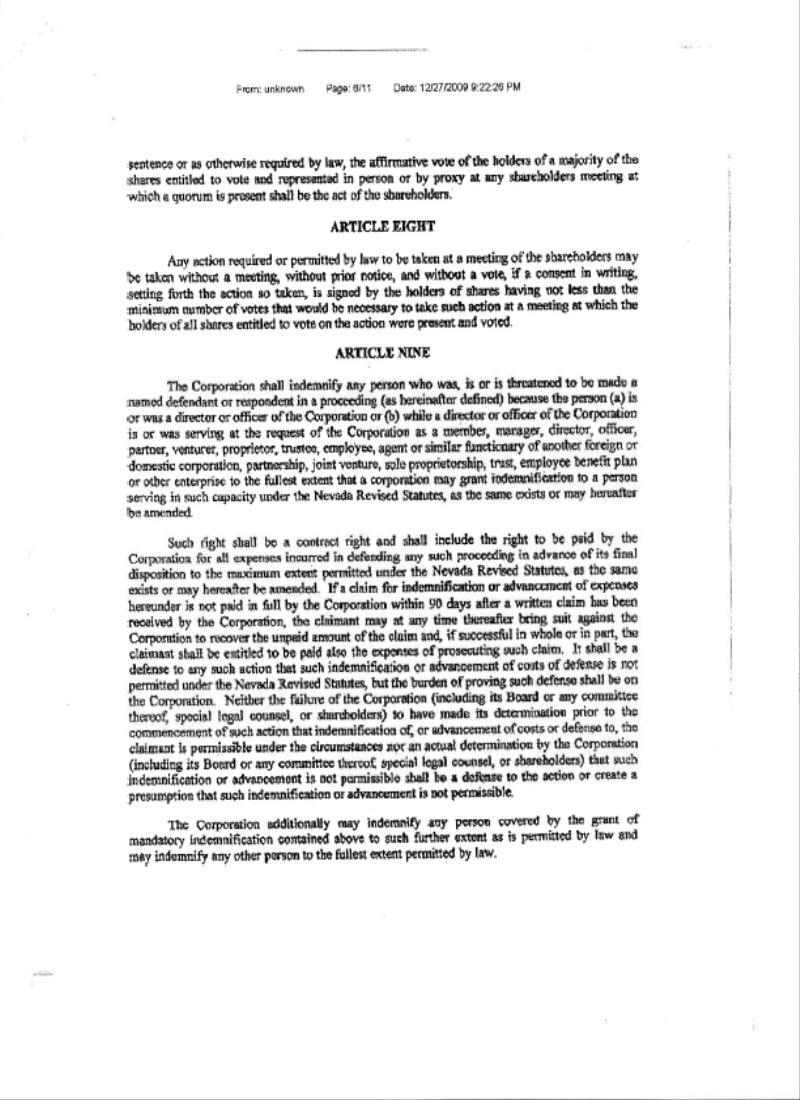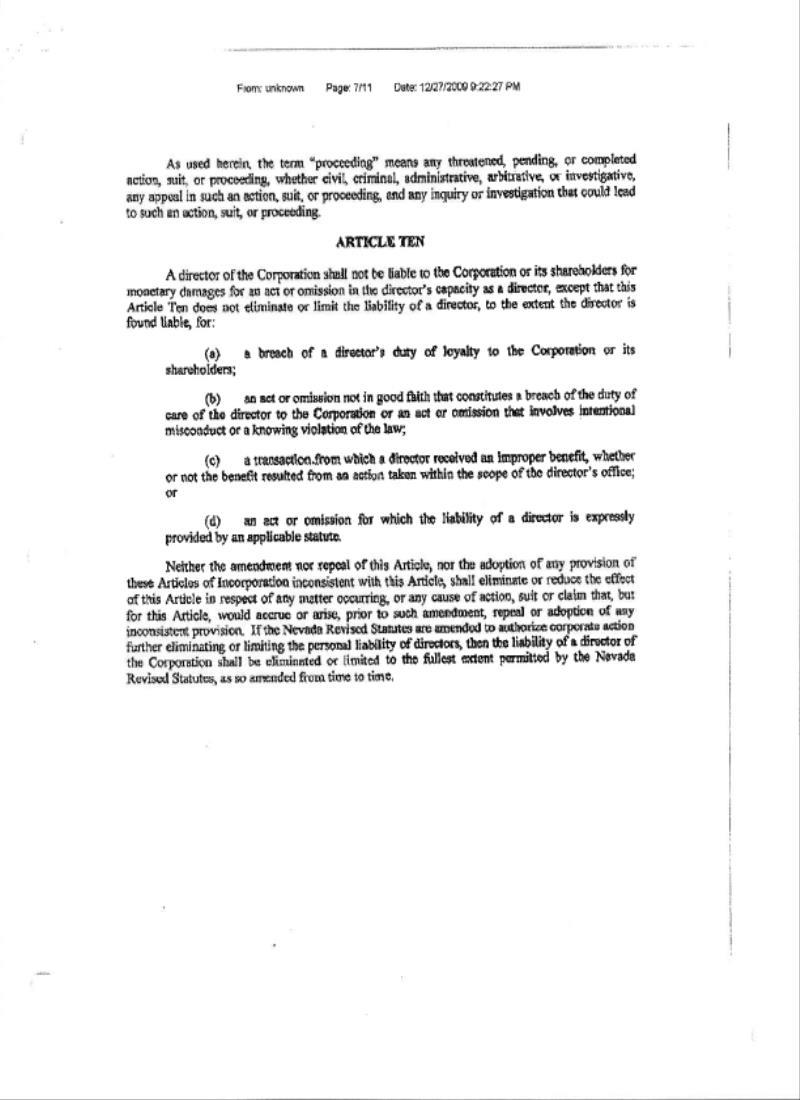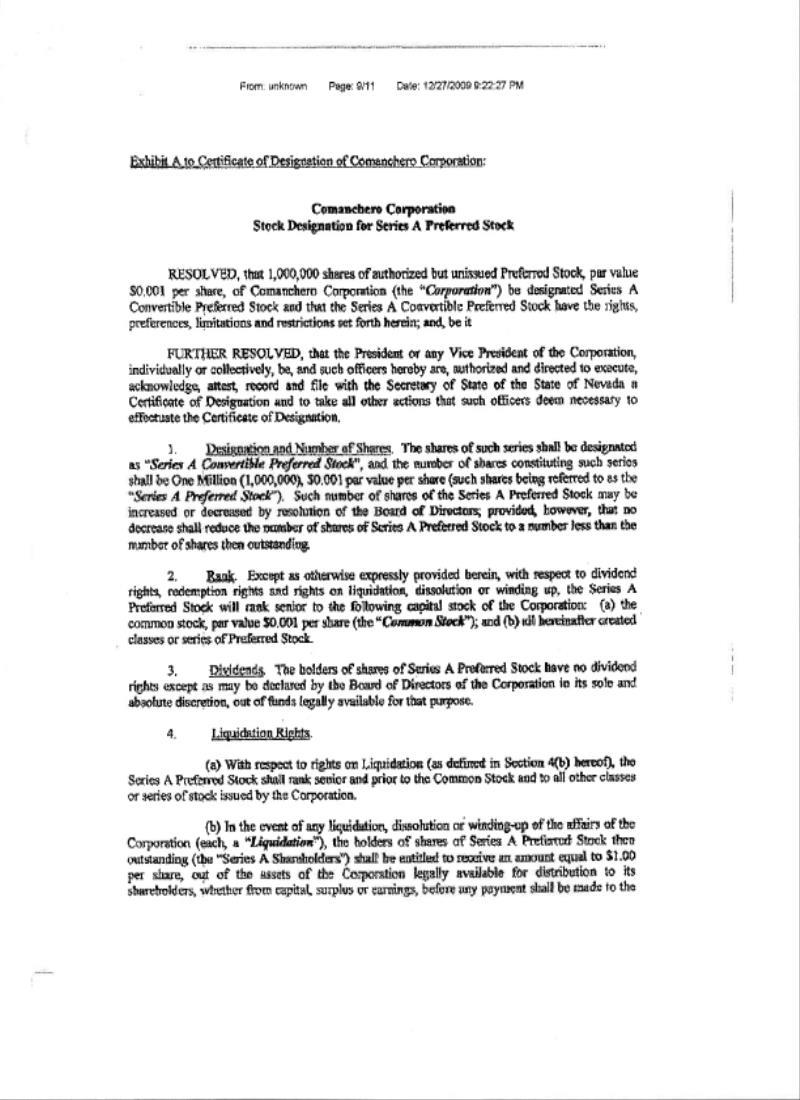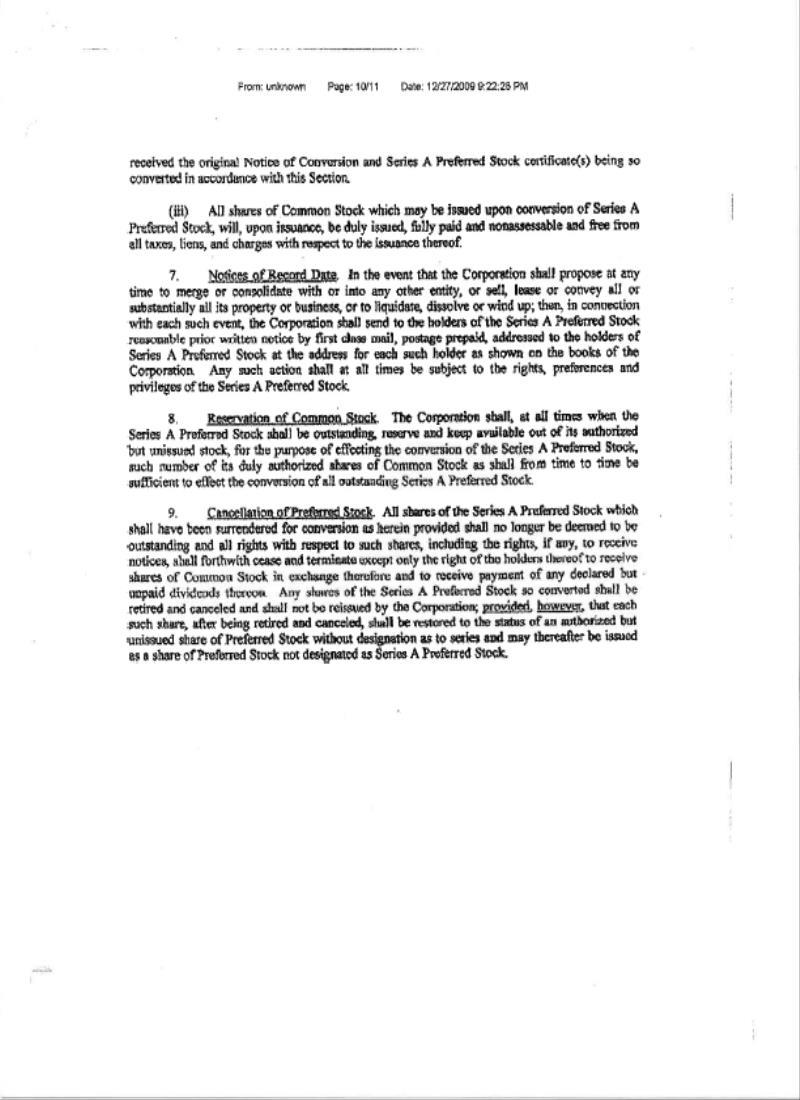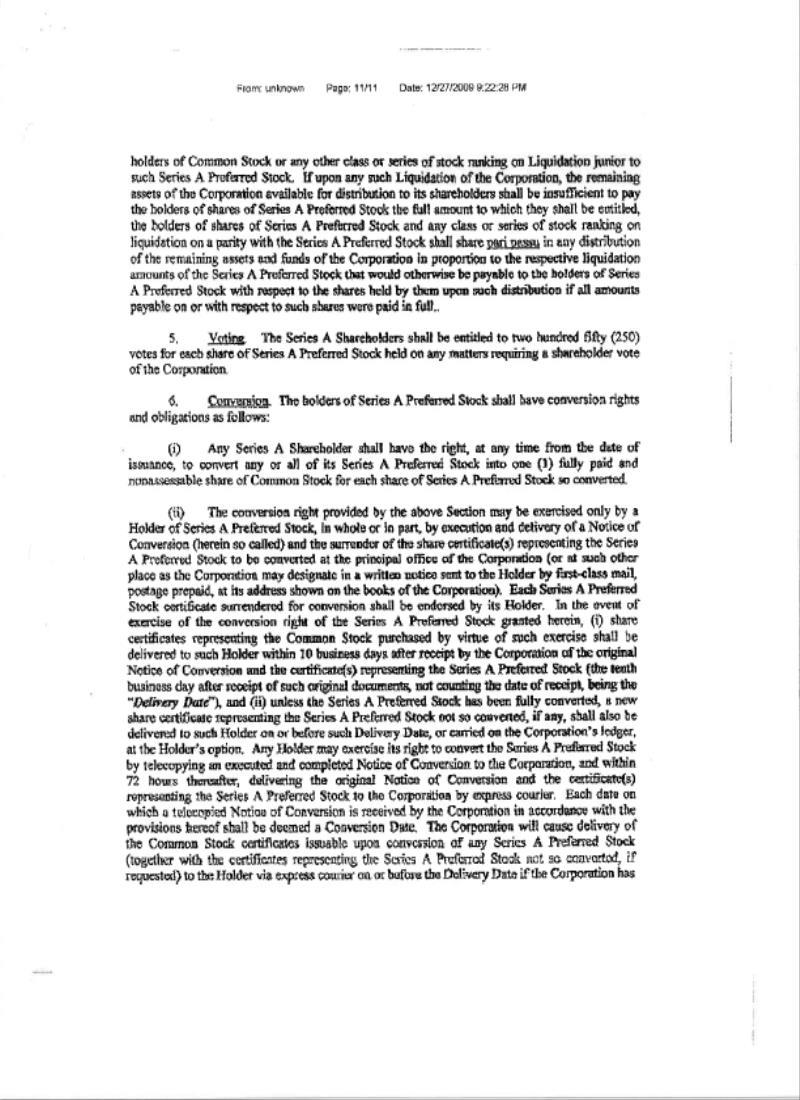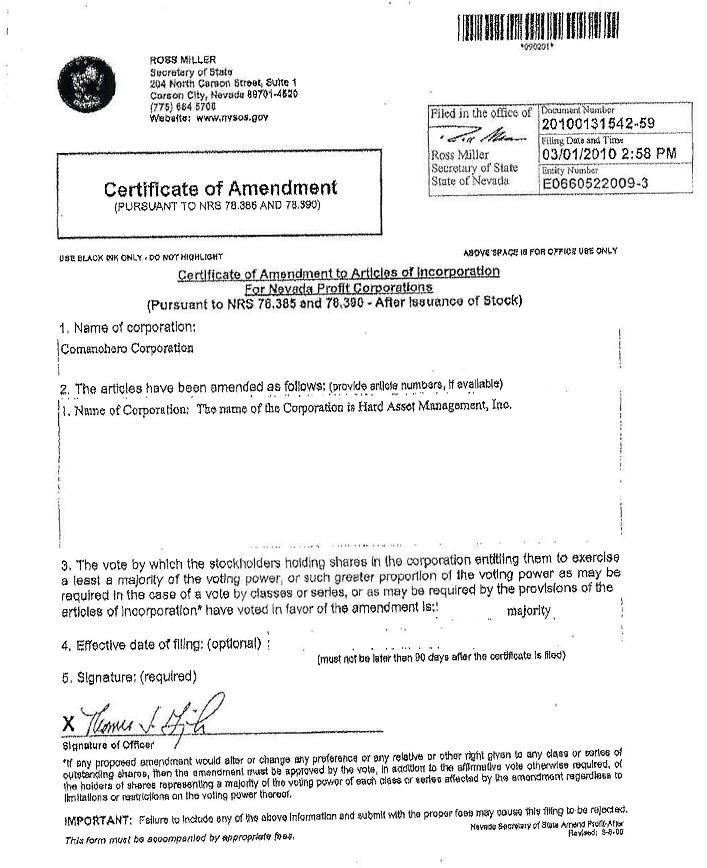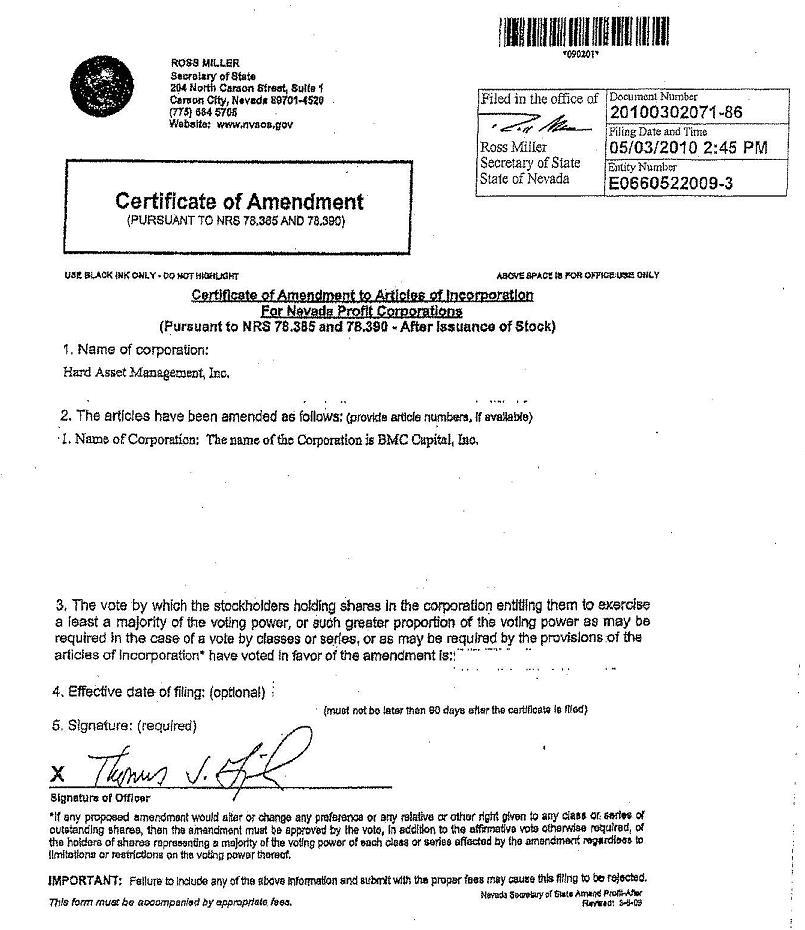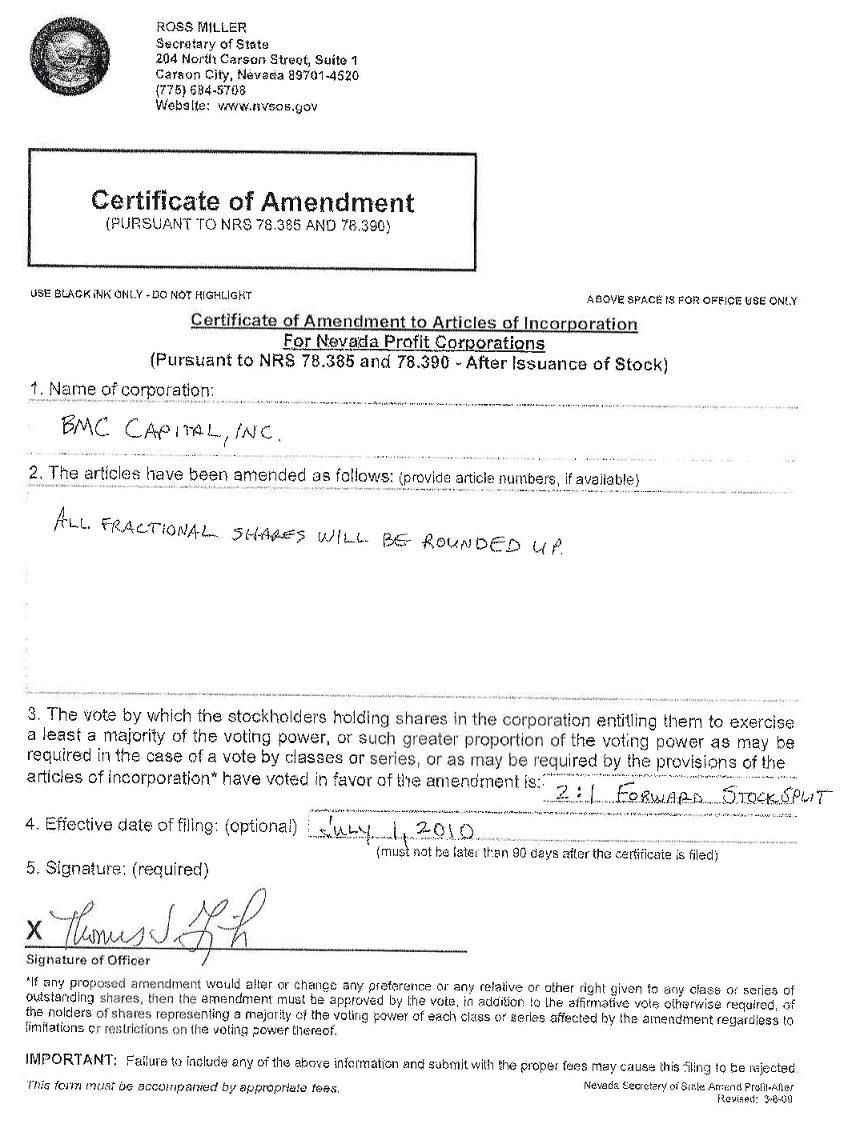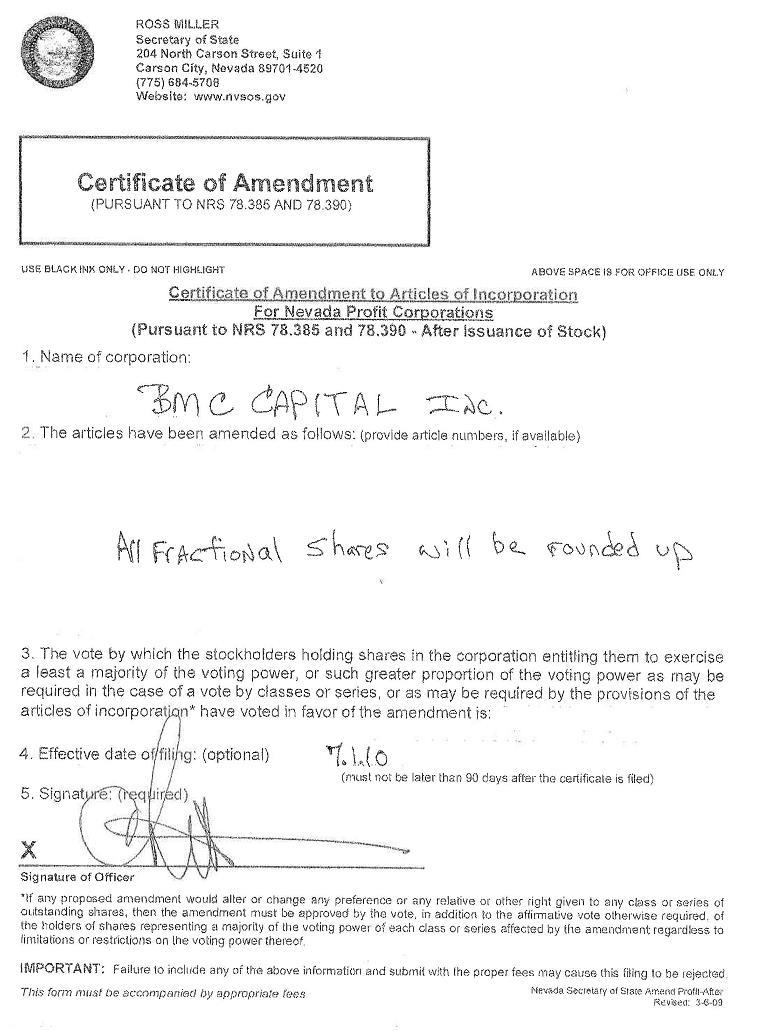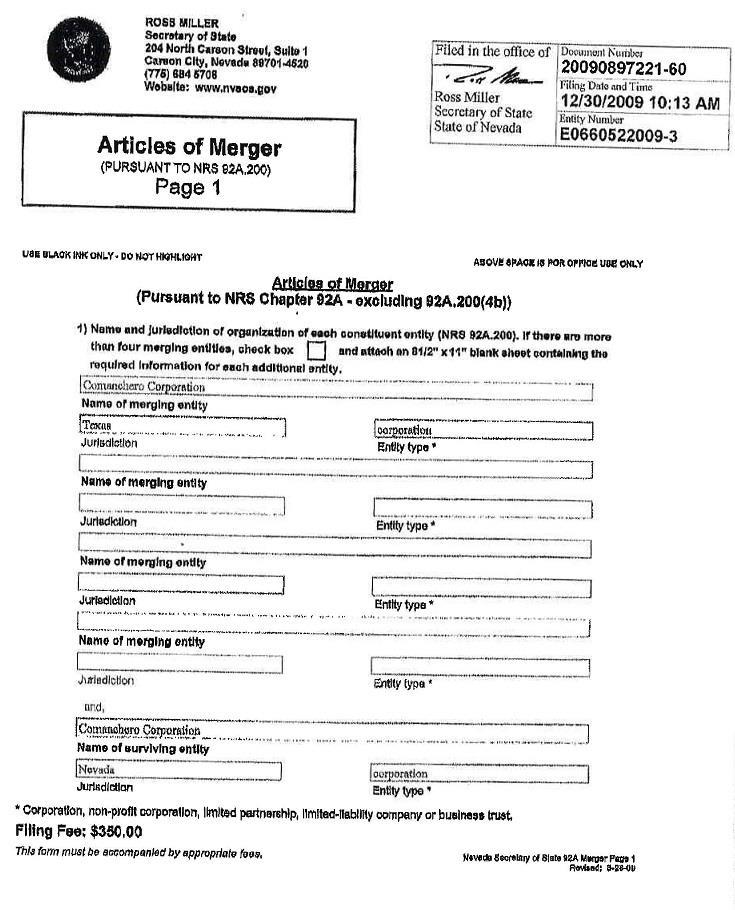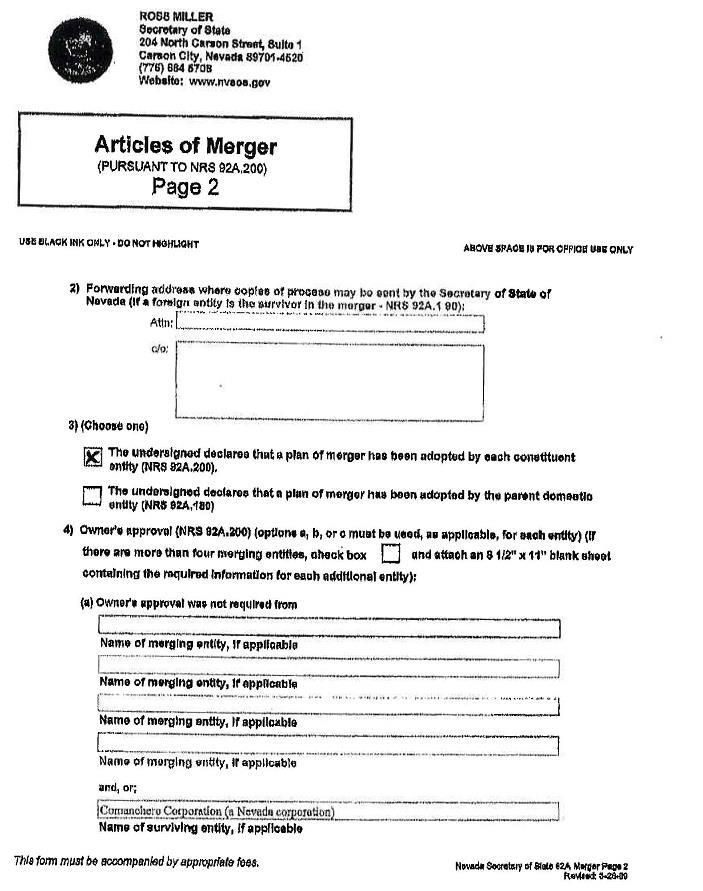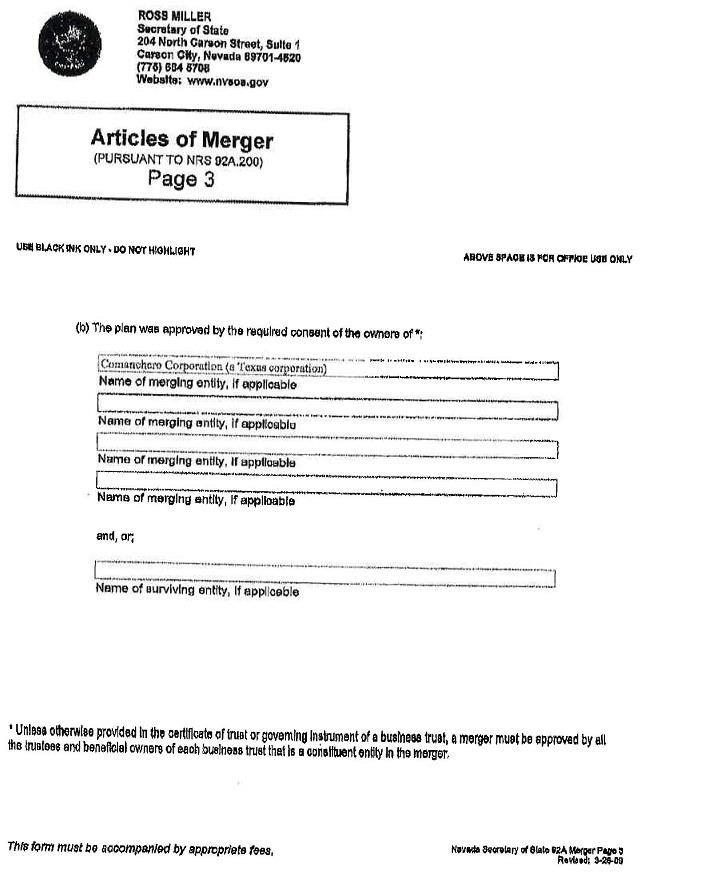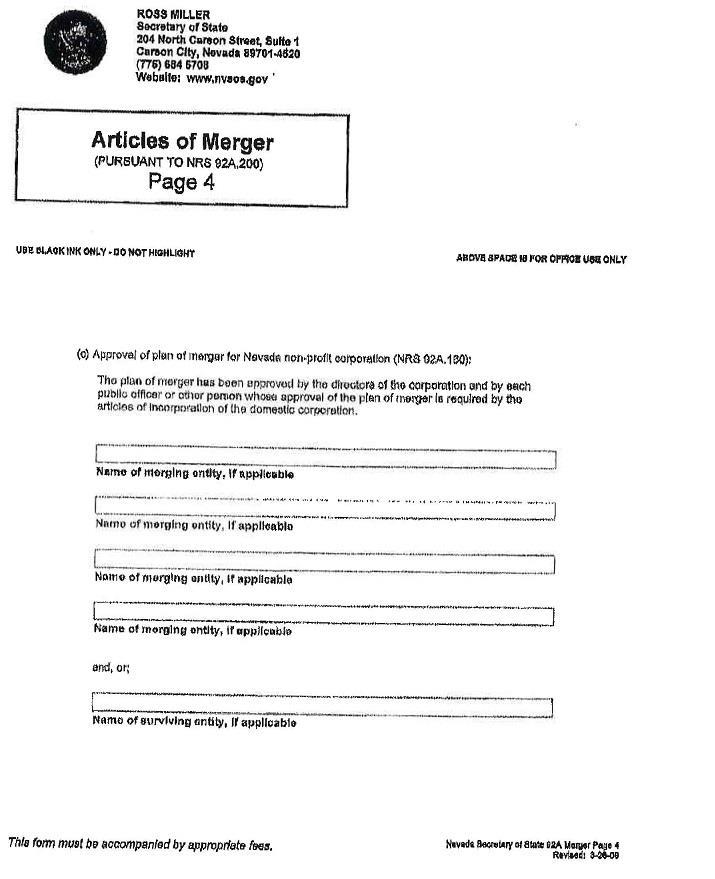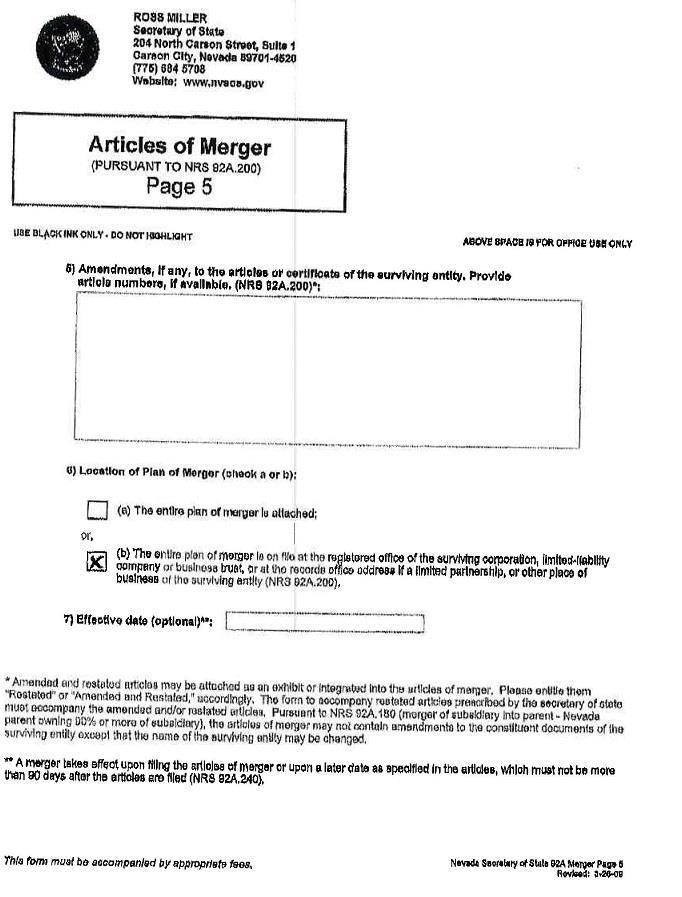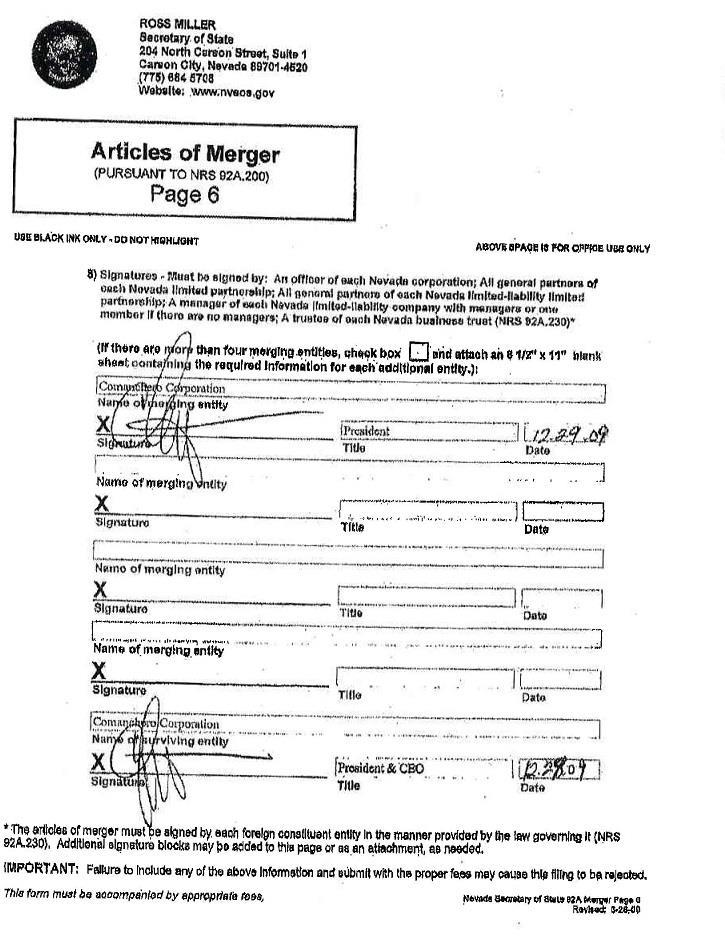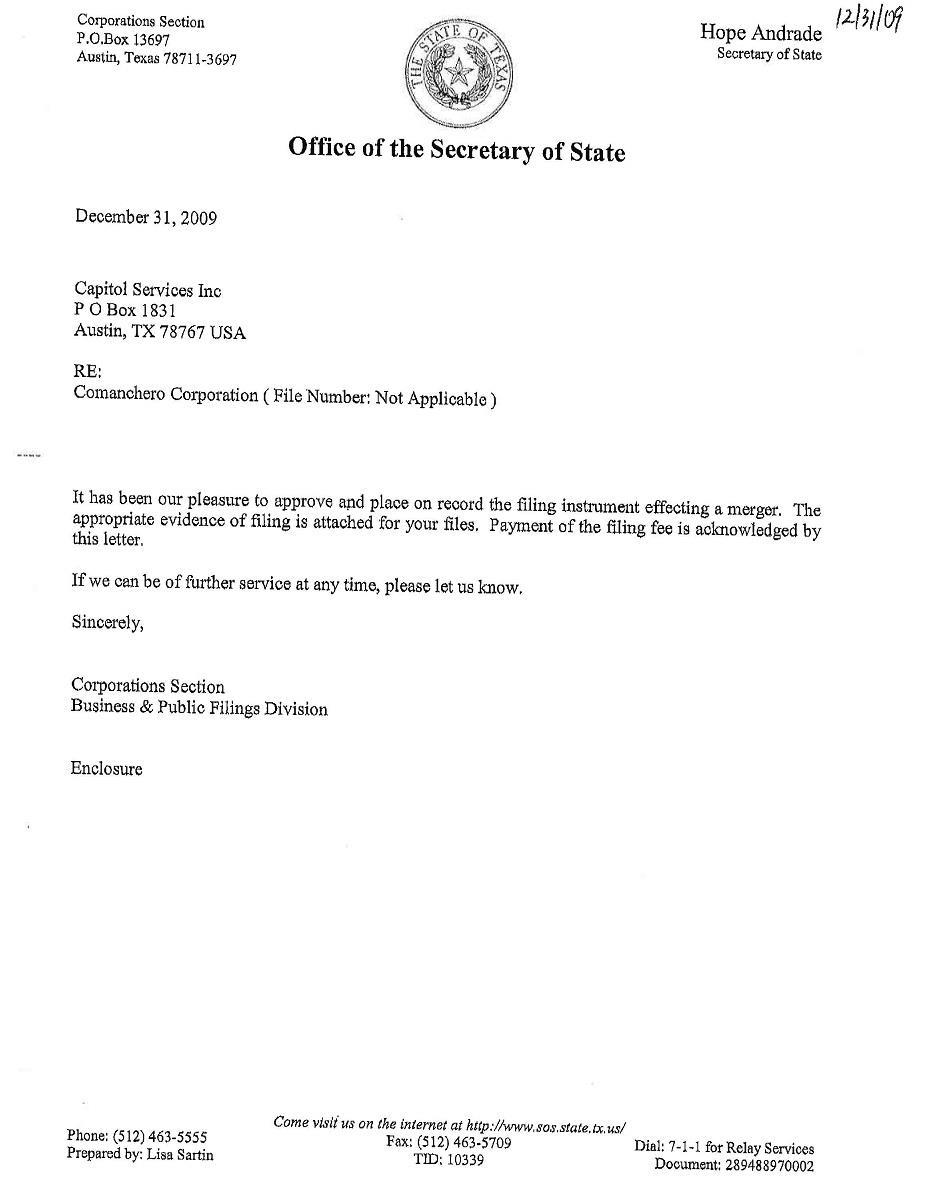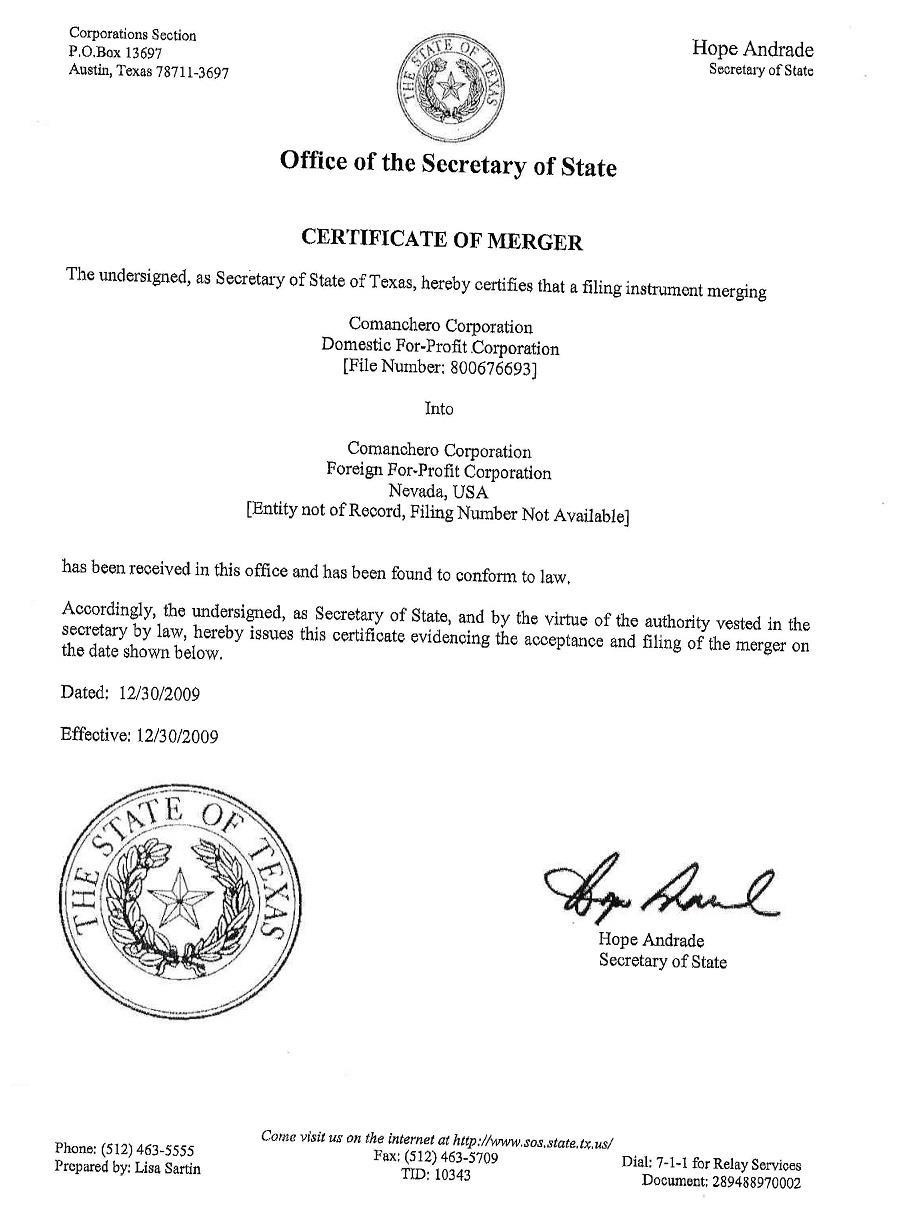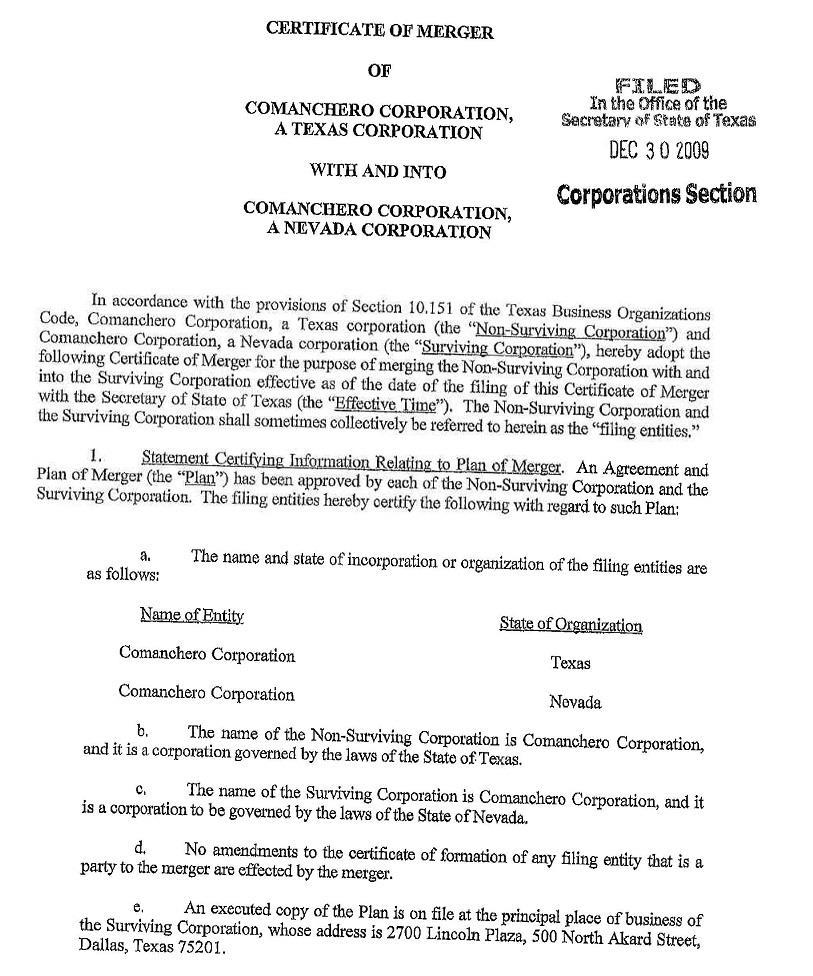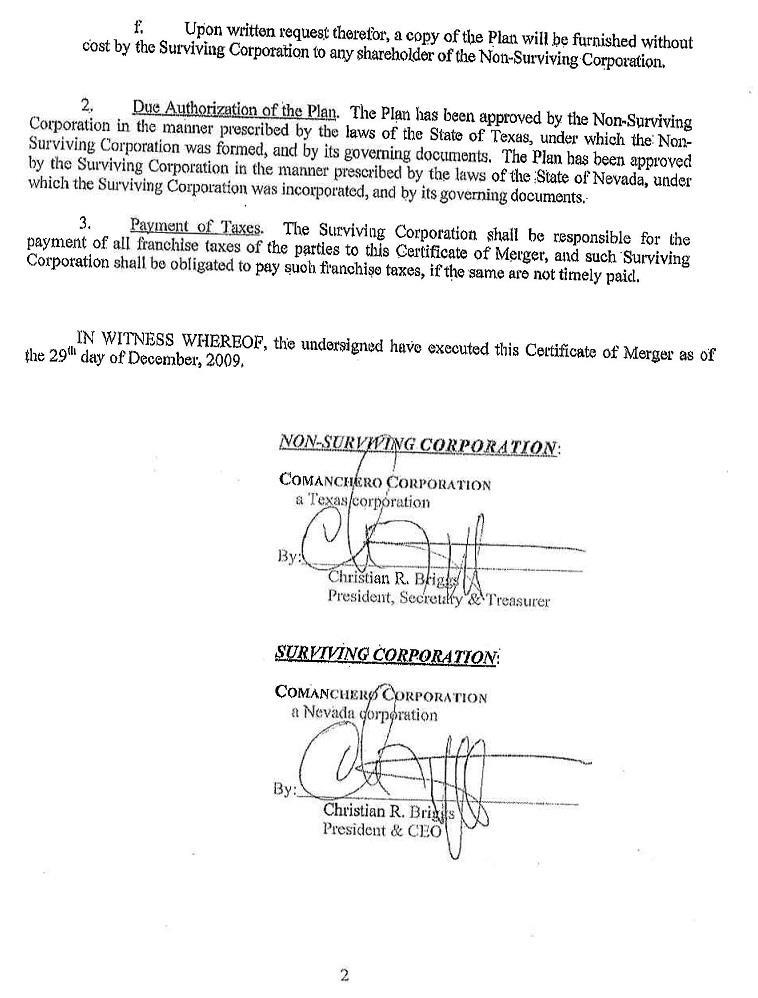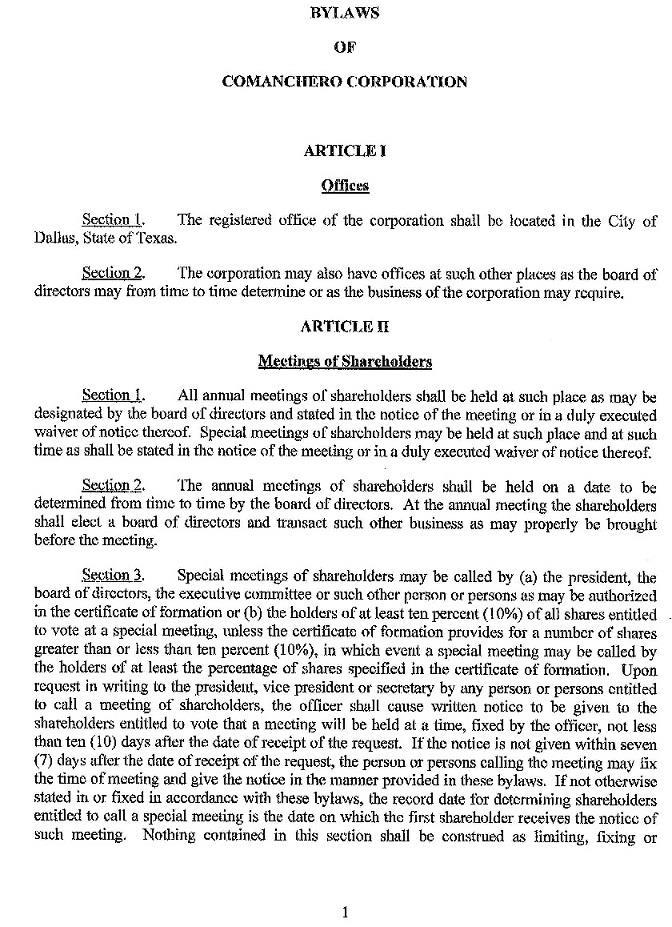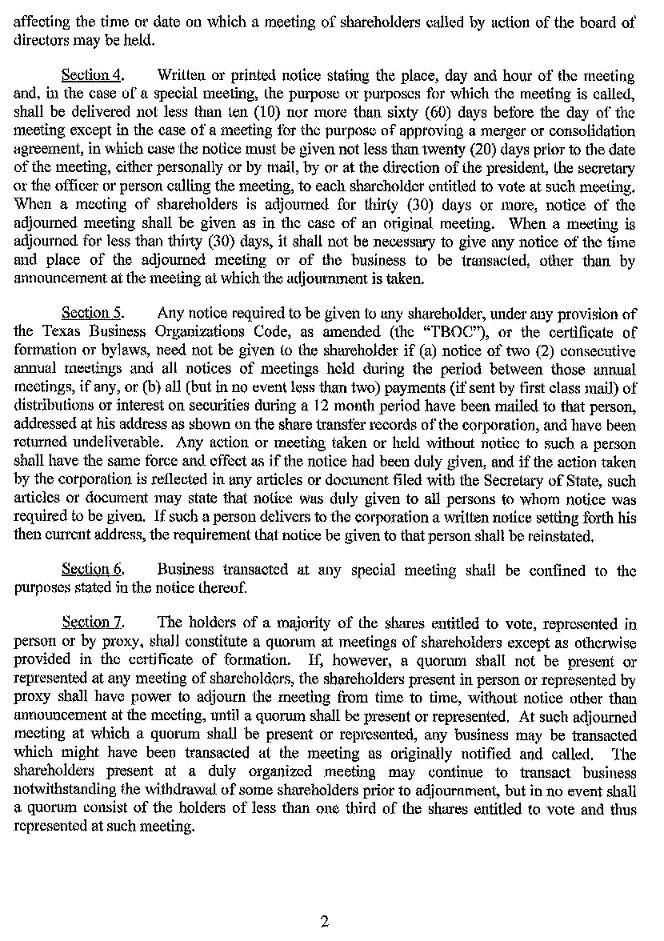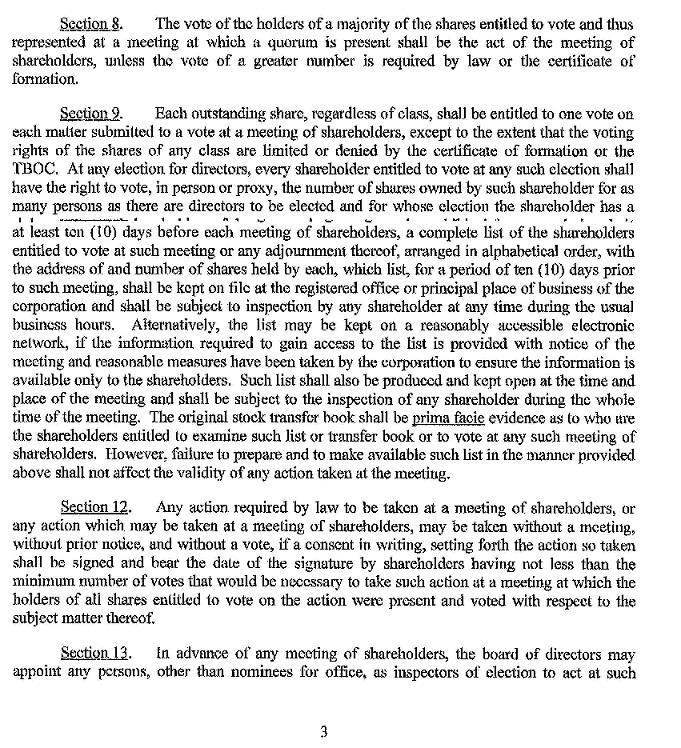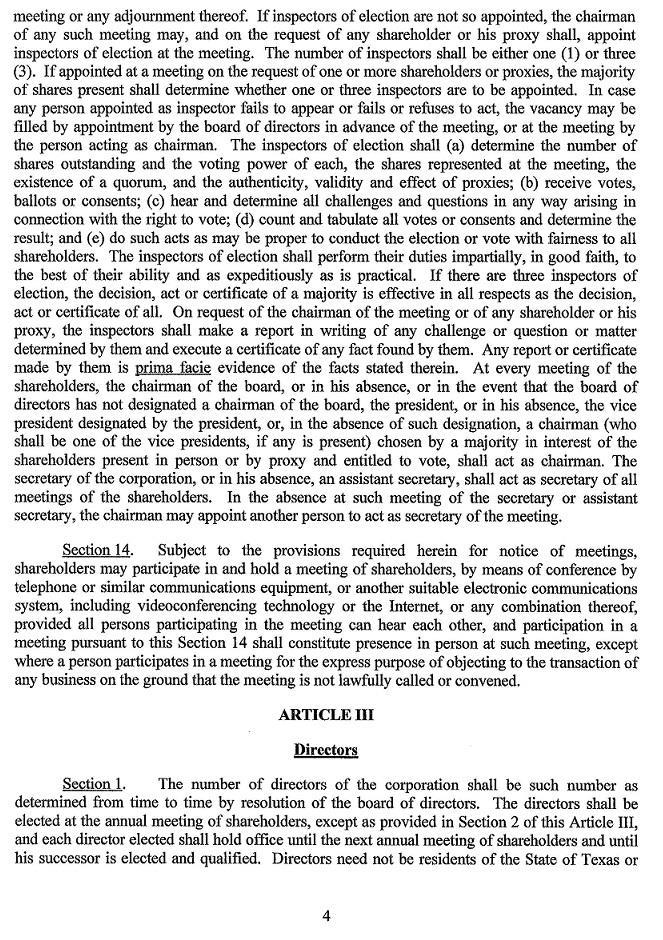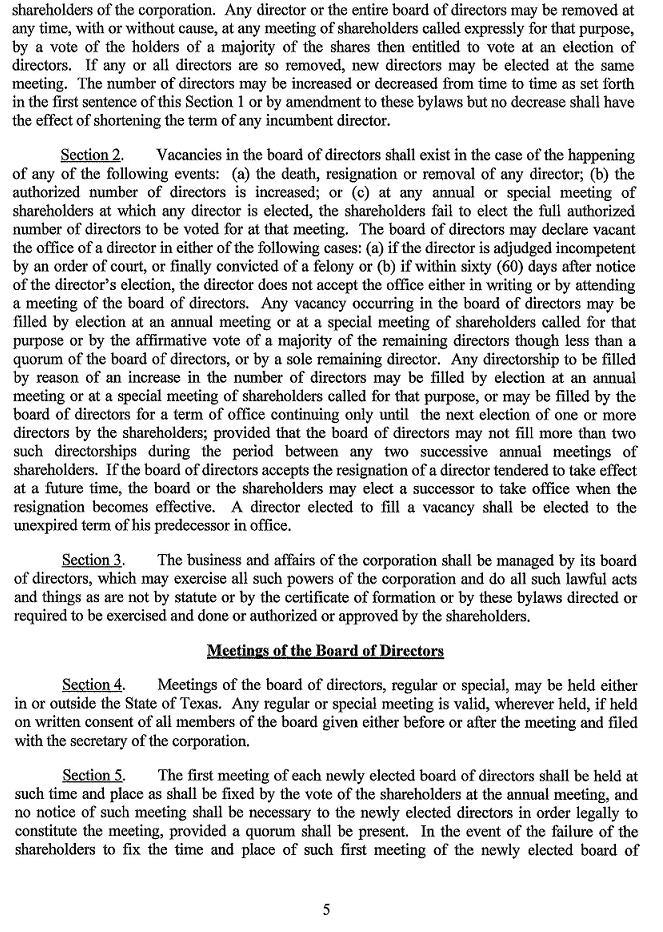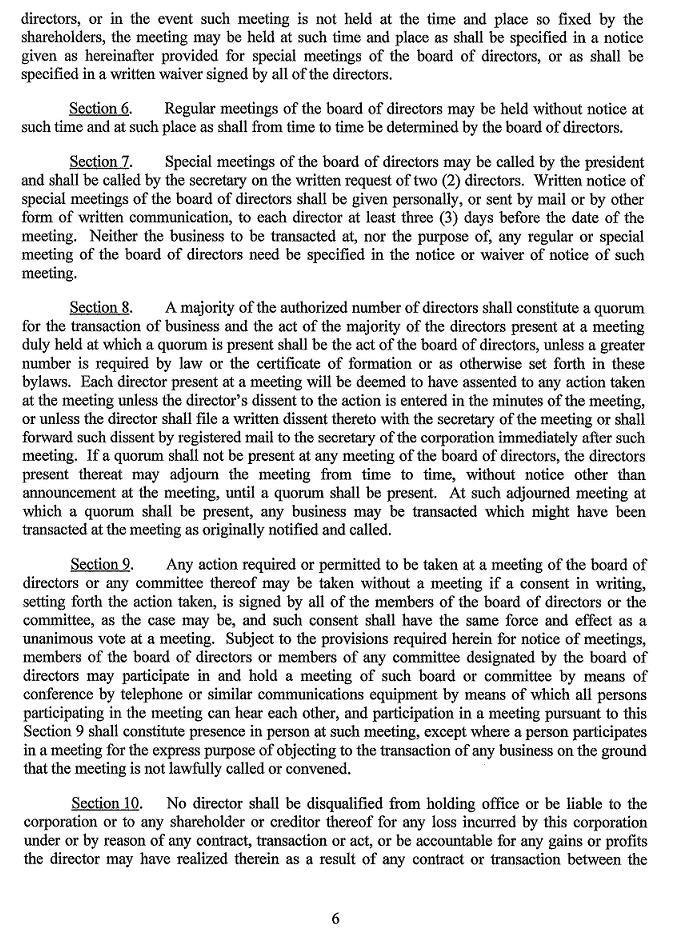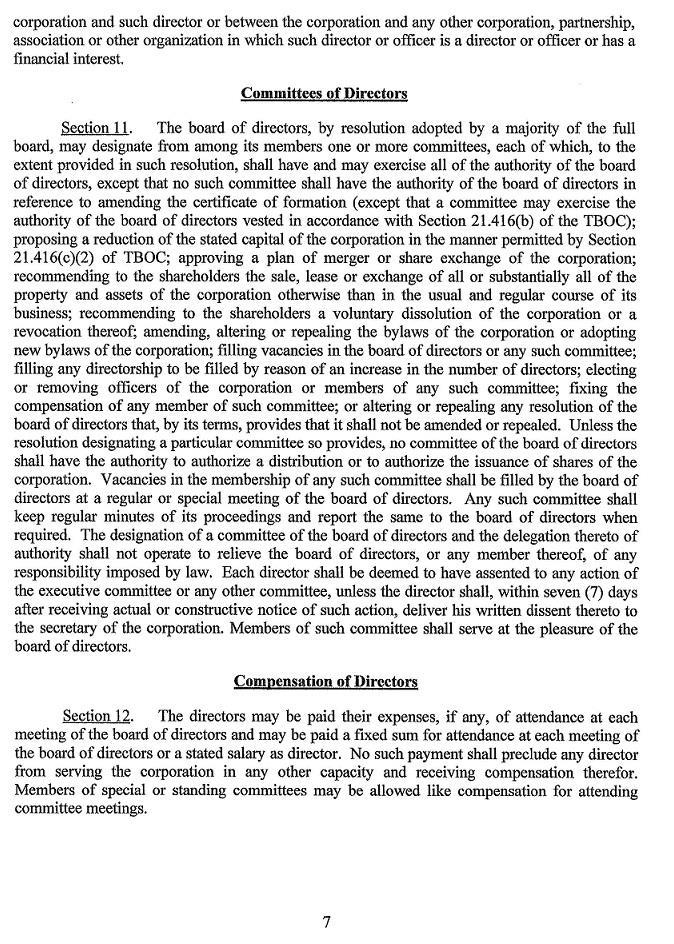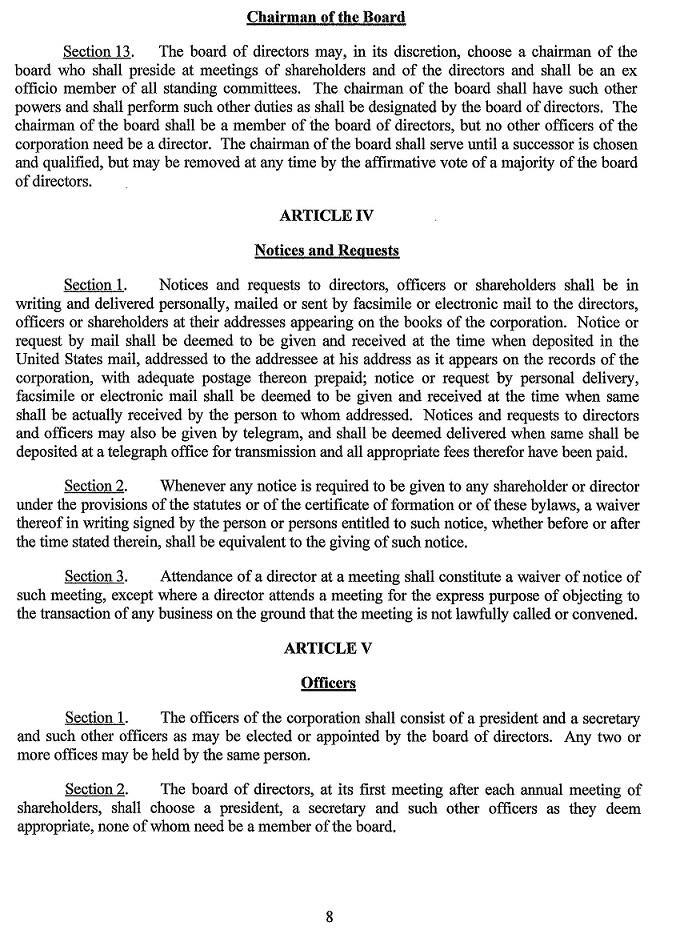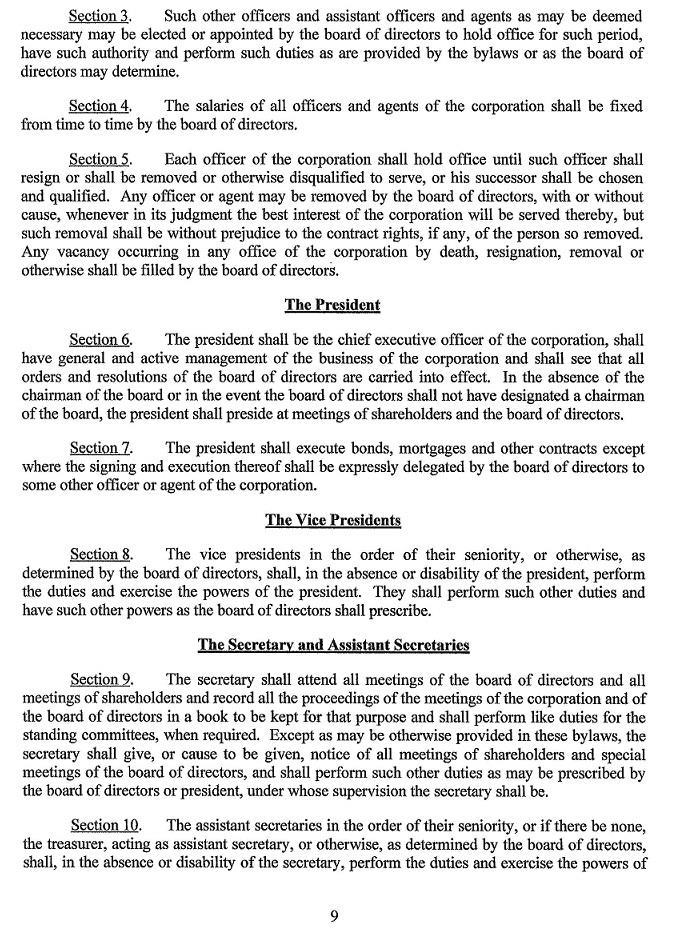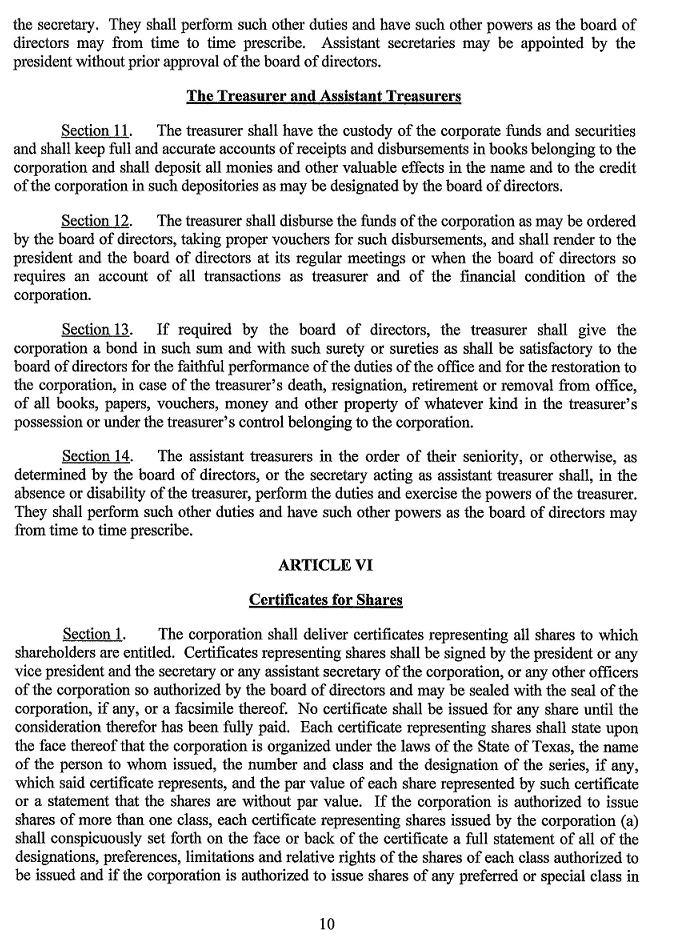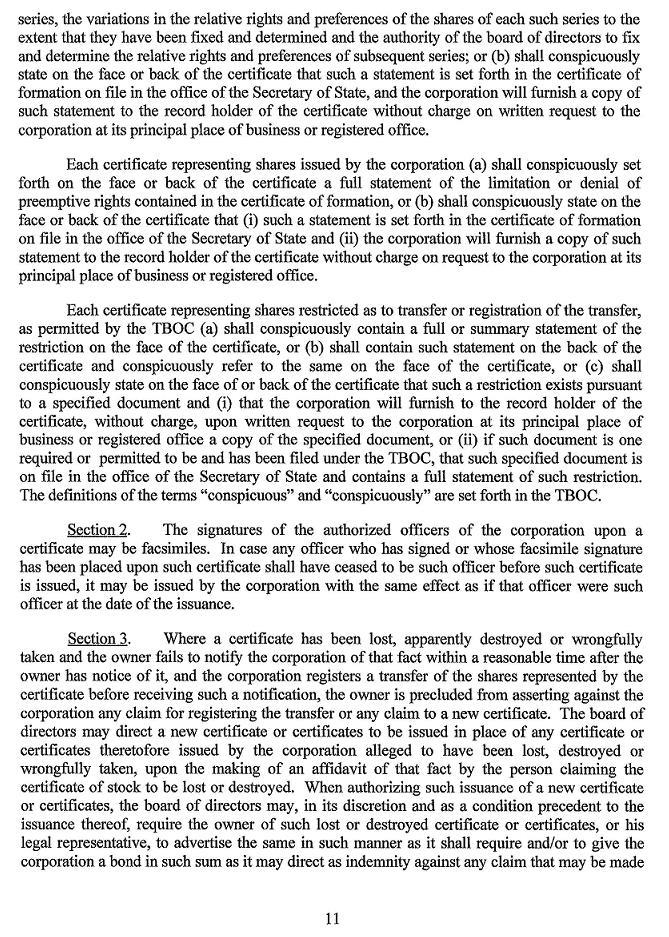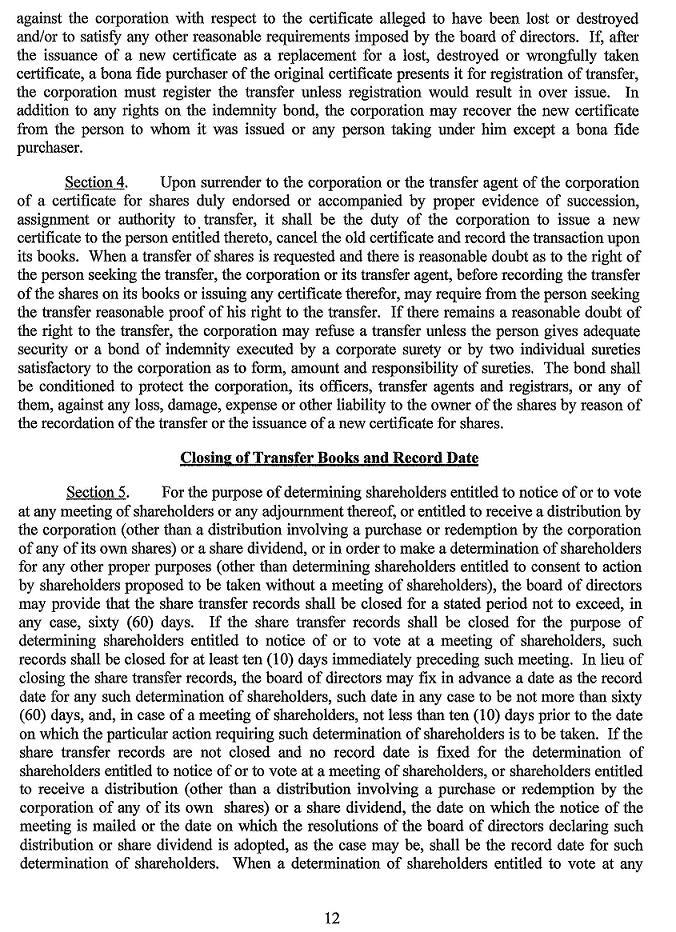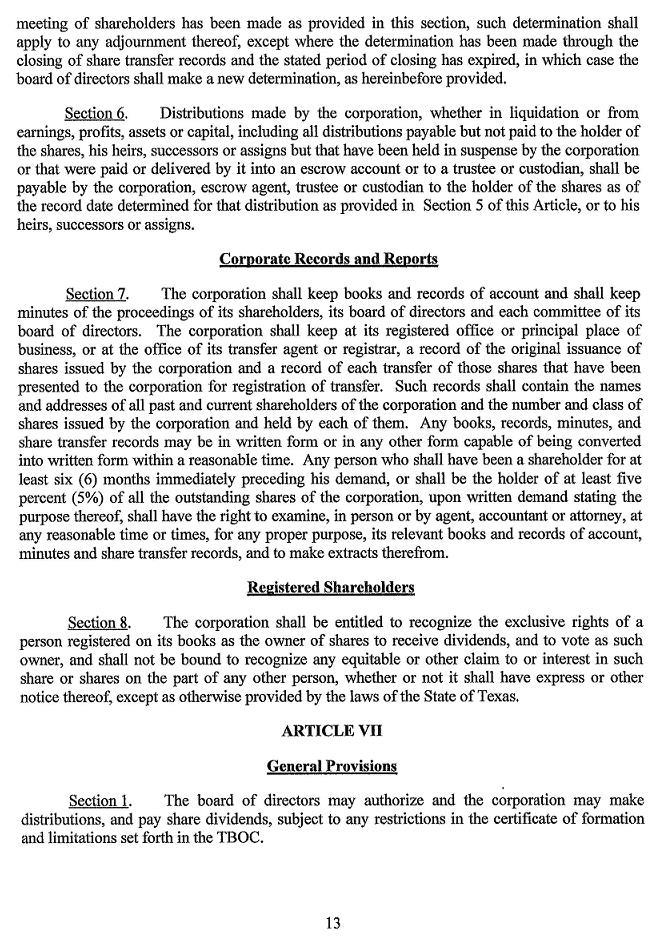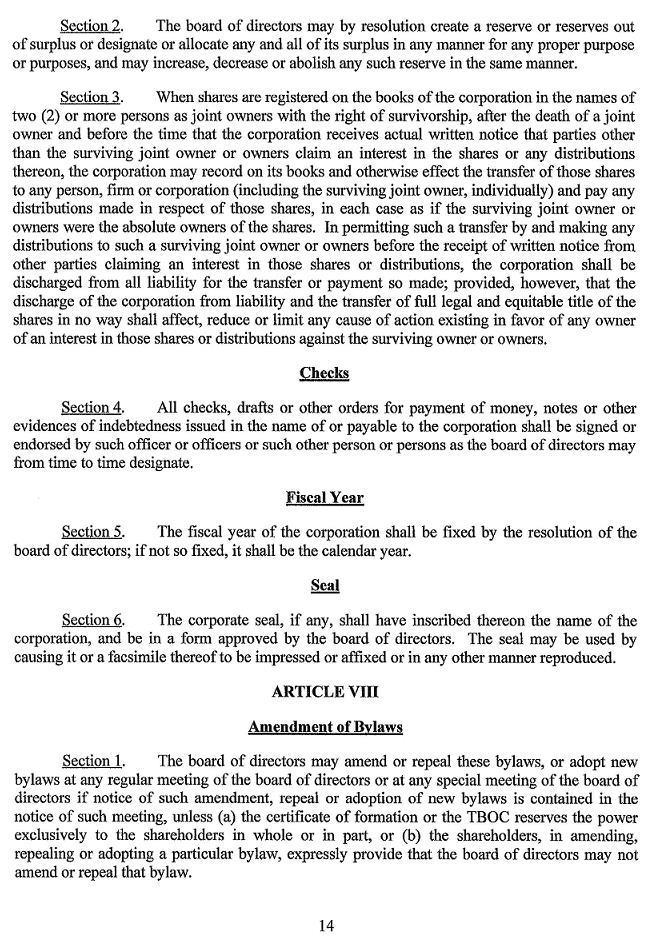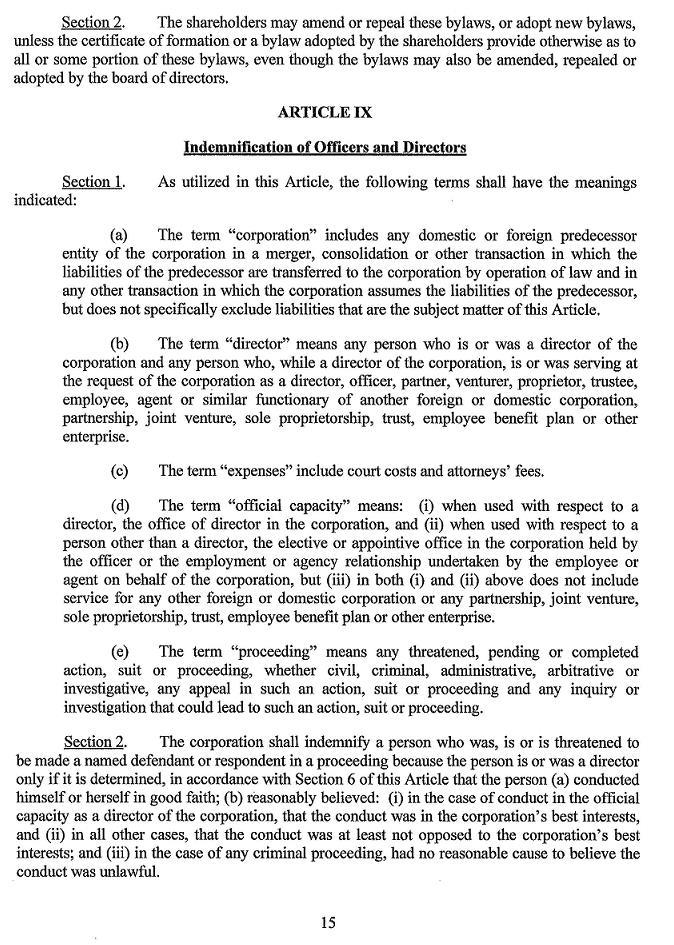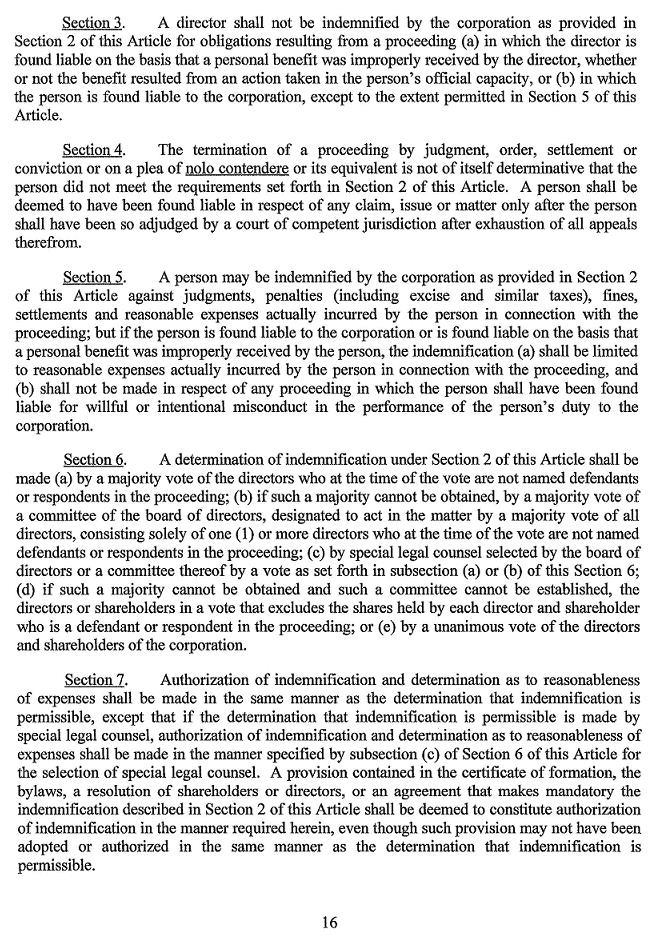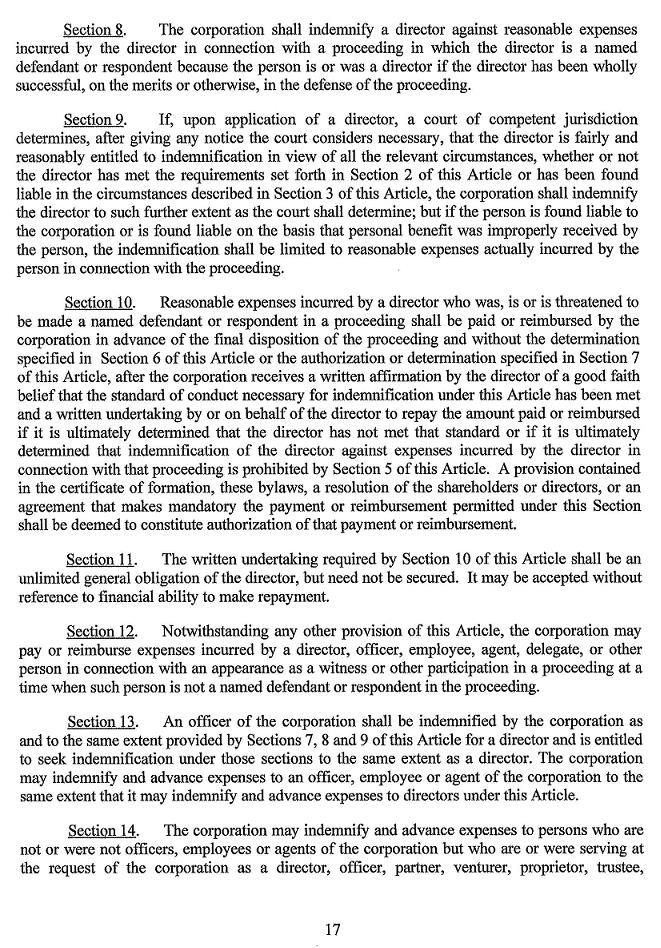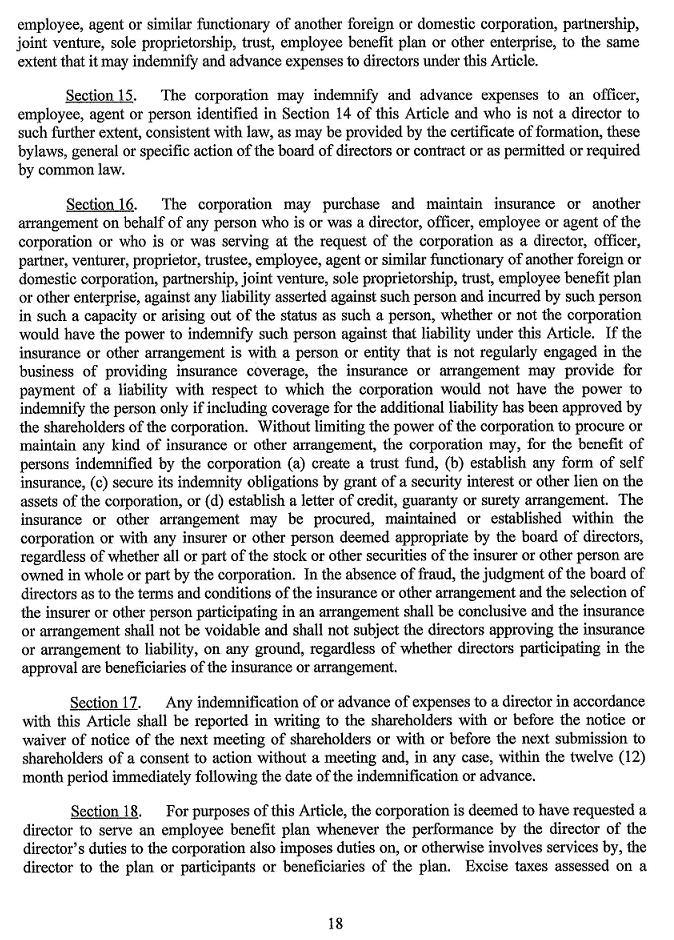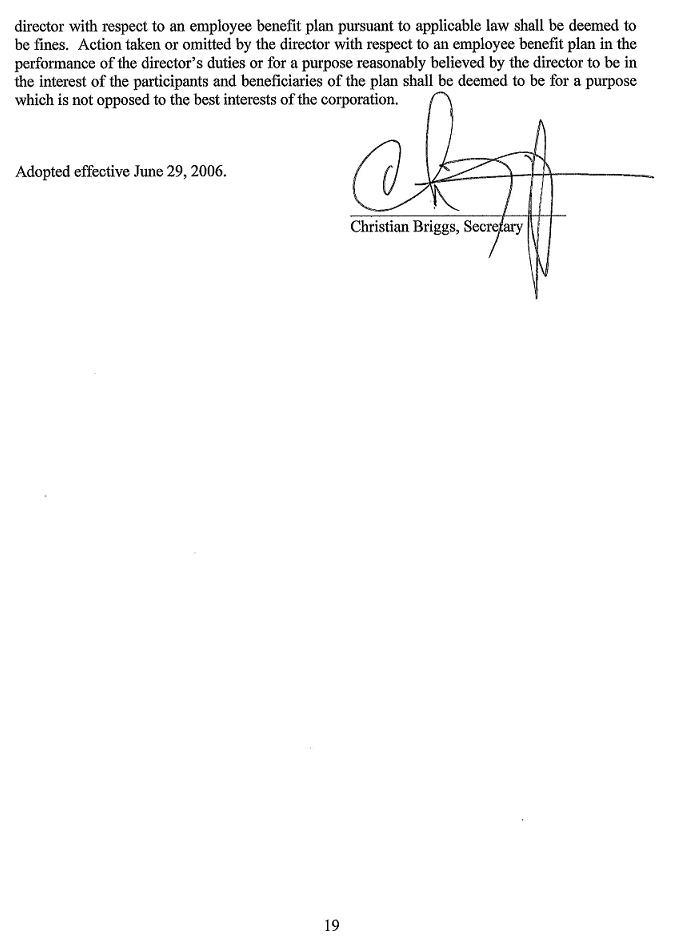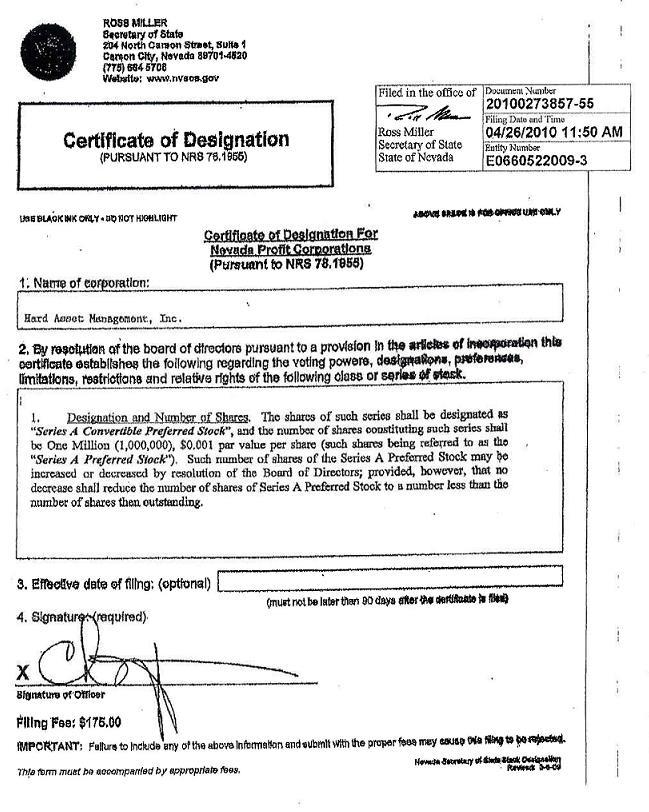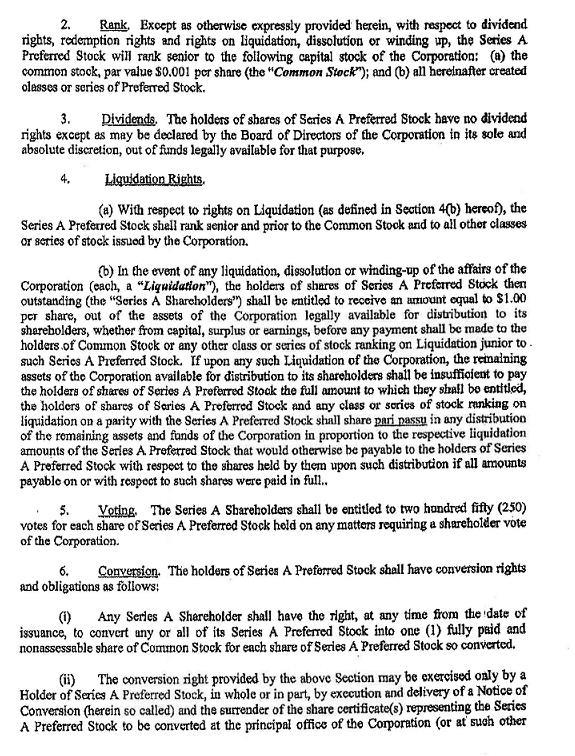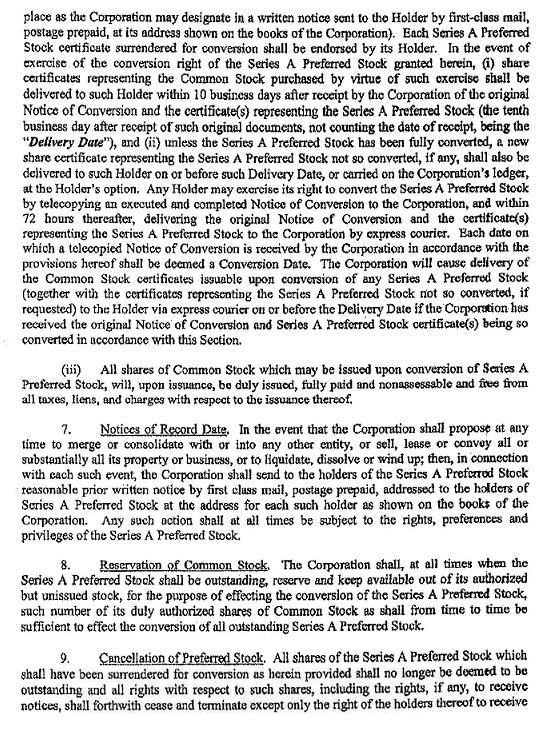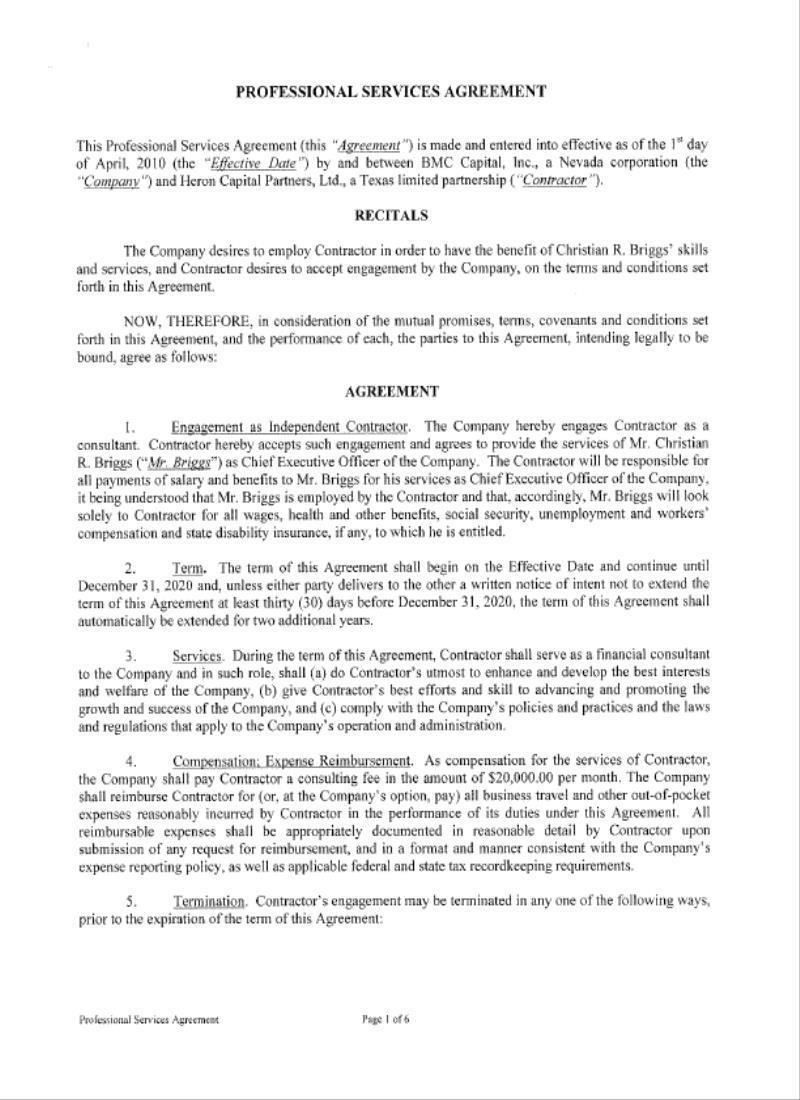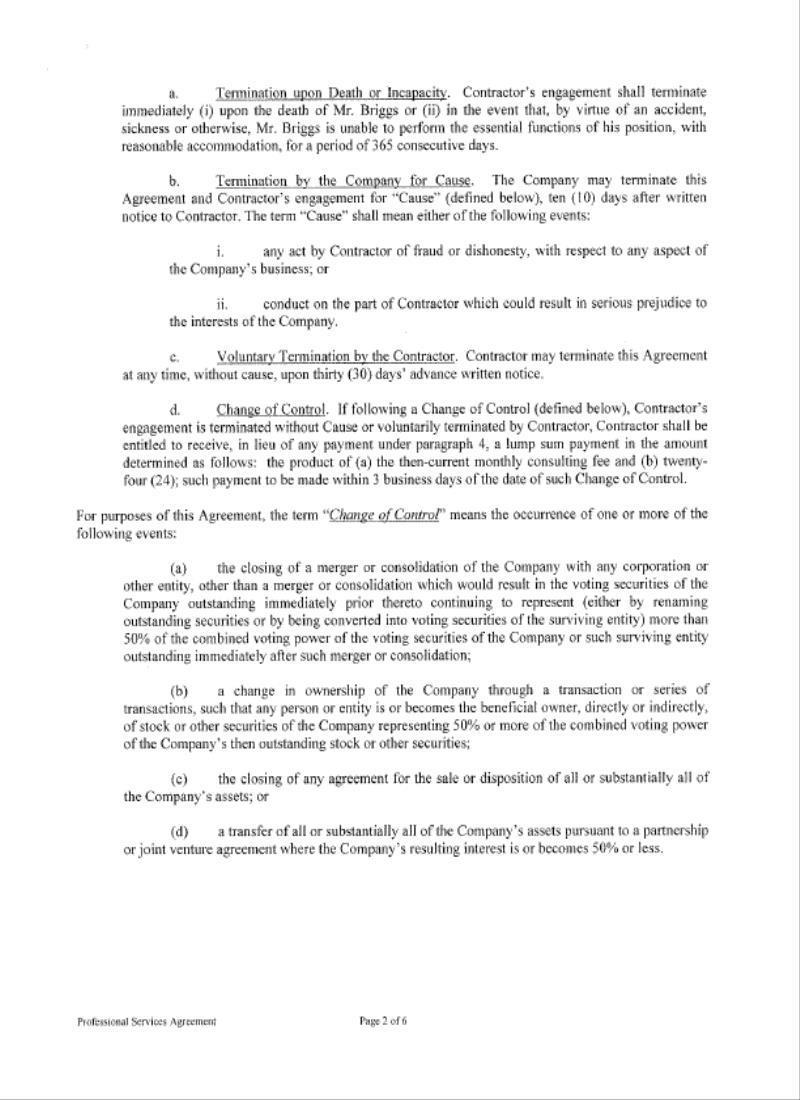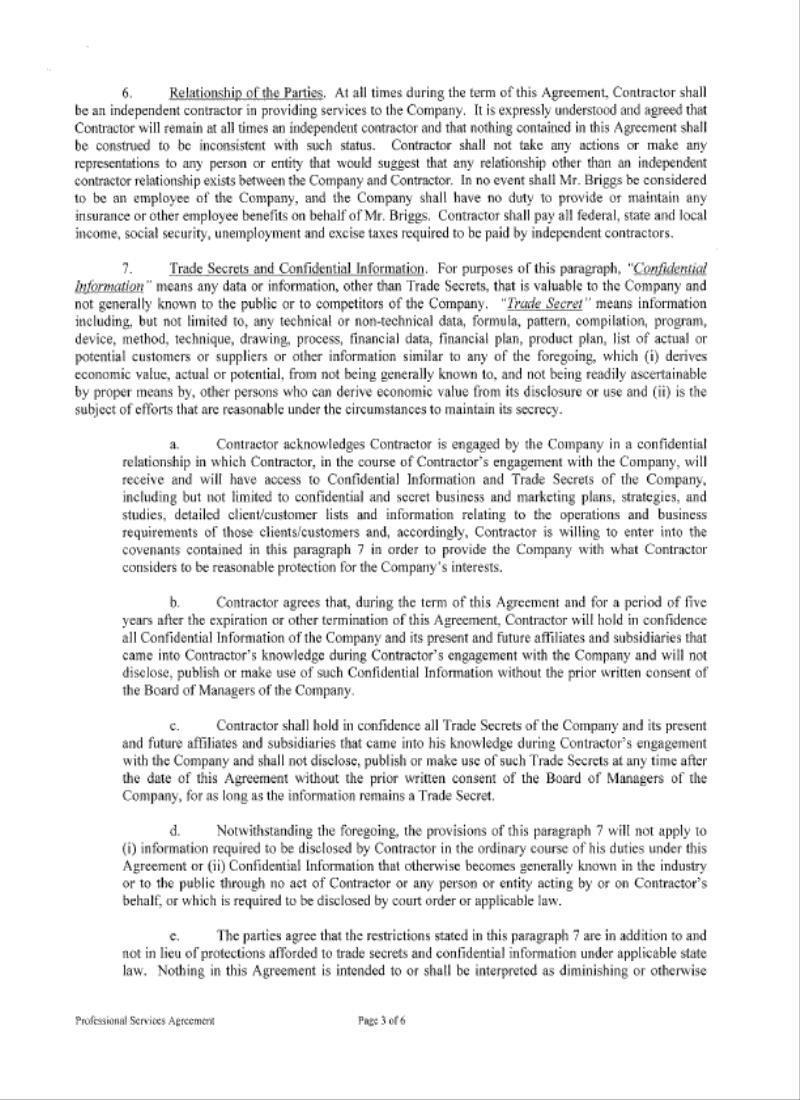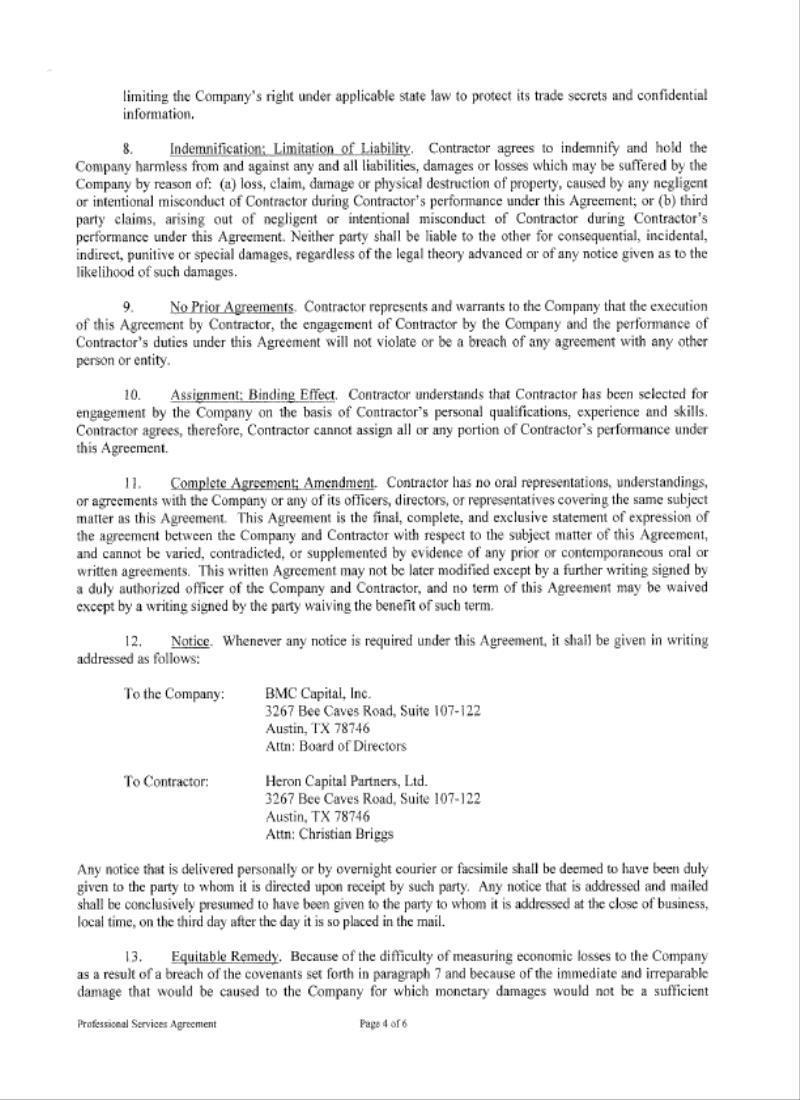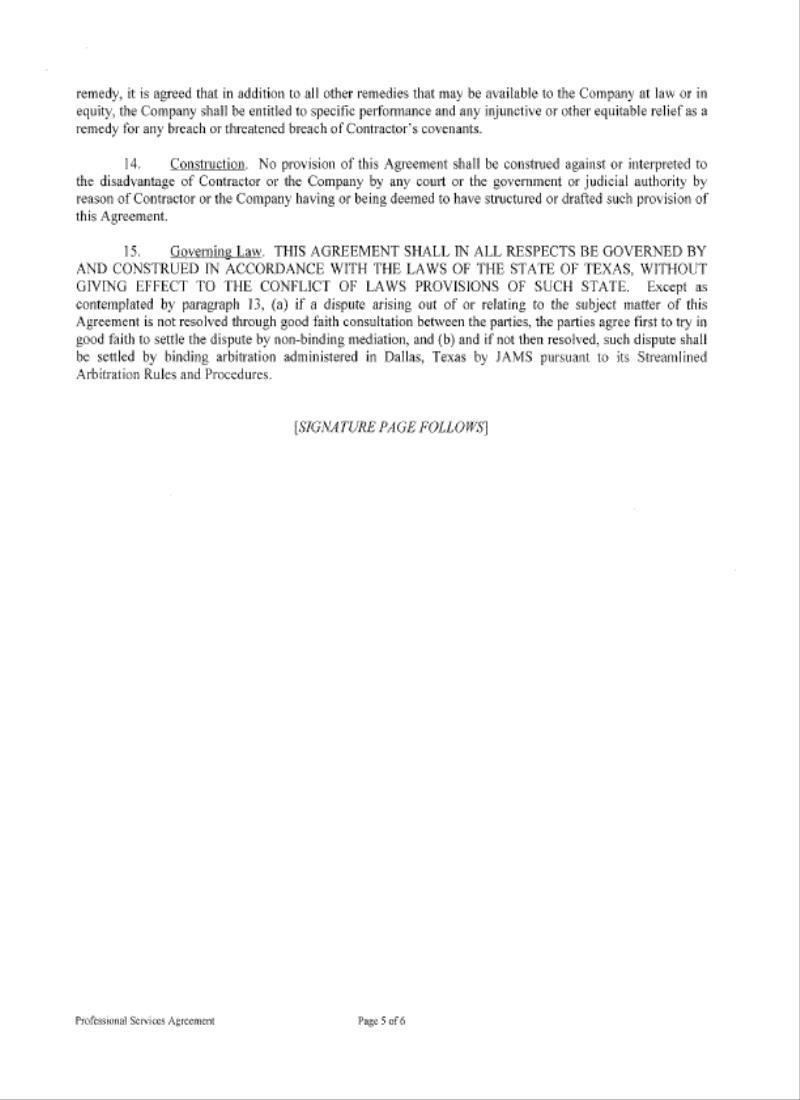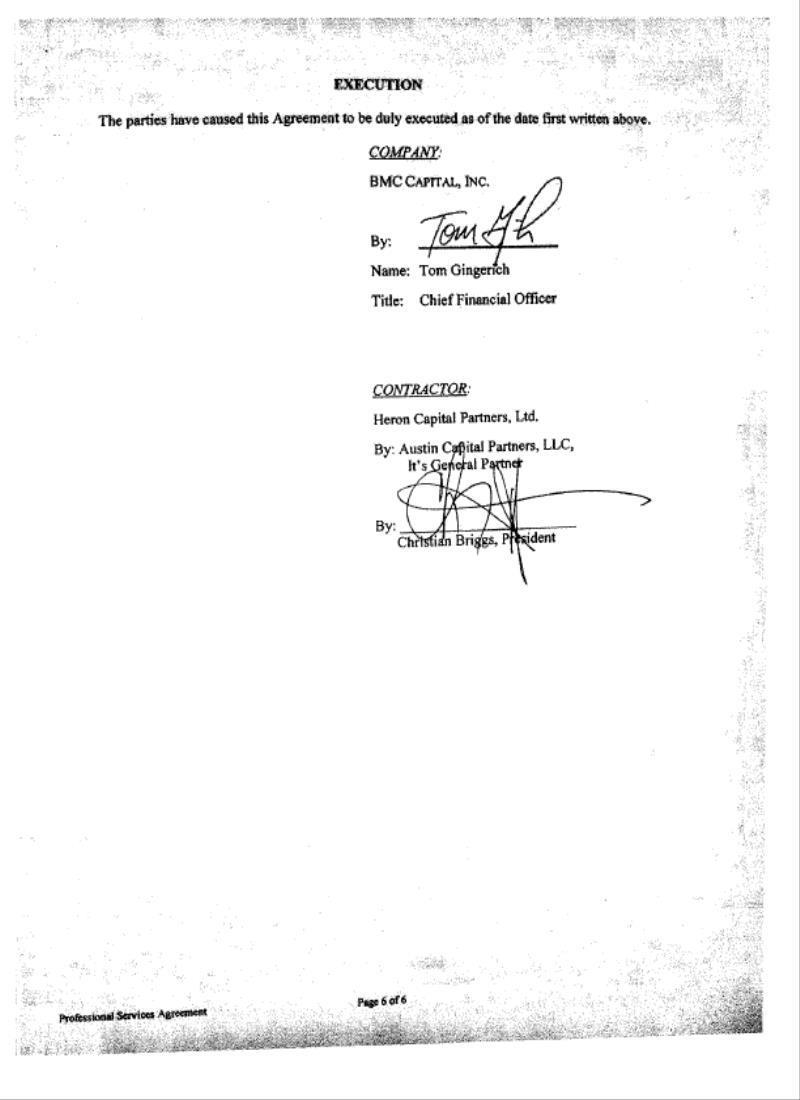As filed with the Securities and Exchange Commission September __, 2016
Registration No.______
UNITED STATES
SECURITIES AND EXCHANGE COMMISSION
Washington, D.C. 20549
FORM S-1
REGISTRATION STATEMENT UNDER THE SECURITIES ACT OF 1933
BMC CAPITAL, INC. |
Nevada |
| 5094 |
| 90-0712962 |
(State or Other Jurisdiction of Organization) |
| (Primary Standard Industrial Classification Code) |
| (IRS Employer Identification Number) |
3267 Bee Caves Road
Suite 107-122
Austin, Texas 78746
(512) 553-6785
(Address, including zip code, and telephone number, including area code, of
Registrant’s principal executive offices)
Christian Briggs
3267 Bee Caves Road
Suite 107-122
Austin, Texas 78746
(310)279-9400
c@bmchas.com
(Name, address, including zip code, and telephone number, including area
code, of agent for service)
Copies of all communications to:
Thomas E. Stepp, Jr.
Stepp Law Corporation
15707 Rockfield Boulevard, Suite 101
Irvine, California 92618
Telephone: 949.660.9700
Fax: 949.660.9010
Email: tes@stepplawgroup.com
APPROXIMATE DATE OF COMMENCEMENT OF PROPOSED SALE TO THE PUBLIC: From time to time after the effective date of this registration statement.
If any of the securities being registered on this Form are to be offered on a delayed or continuous basis pursuant to Rule 415 under the Securities Act of 1933, please check the following box. T
If this form is filed to register additional securities for an offering pursuant to Rule 462(b) under the Securities Act, please check the following box and list the Securities Act registration statement number of the earlier effective registration statement for the same offering. ¨
If this form is a post-effective amendment filed pursuant to Rule 462(c) under the Securities Act, check the following box and list the Securities Act registration statement number of the earlier effective registration statement for the same offering. ¨
If this form is a post-effective amendment filed pursuant to Rule 462(d) under the Securities Act, check the following box and list the Securities Act registration statement number of the earlier effective registration statement for the same offering. ¨
Indicate by check mark whether the registrant is a large accelerated filer, an accelerated filer, a non-accelerated filer or a smaller reporting company. See definitions of “large accelerated filer”, “accelerated filer”, a “smaller reporting company” in Rule 12b-2 of the Exchange Act.
Large Accelerated Filer | ¨ | Accelerated Filer | ¨ |
Non-accelerated Filer | ¨ | Smaller Reporting Company | x |
CALCULATION OF REGISTRATION FEE
Title of Each Class Of Securities To Be Registered |
| Number of Shares To Be Registered |
|
| Proposed Maximum Offering Price Per Share |
| Proposed Maximum Aggregate Offering Price |
| Registration Fee (1) | ||
Common Stock, $.001 par value(1) |
|
| 1,348,354 |
|
| $.30 |
| $404,506.20 |
| $40.73 | |
(1) The offering price has been estimated solely for the purpose of computing the amount of the registration fee in accordance with Rule 457(o). Our common stock is not traded on any national exchange and, in accordance with Rule 457, the offering price was determined by the price shares were sold to our shareholders in private placement transactions. The selling shareholders may sell shares of our common stock at a fixed price of $.30 per share until the prices of our common stock are quoted on the OTC Bulletin Board and thereafter at prevailing market prices or privately negotiated prices. The fixed price of $.30 has been determined as the selling price based upon what we believe will be the market value of our common stock after the registration statement of which this prospectus is a part is declared effective by the SEC. There can be no assurance that a market maker will agree to file the necessary documents with the Financial Industry Regulatory Authority (“FINRA”), which operates the OTC Bulletin Board, nor can there be any assurance that an application for quotation will be approved.
THE REGISTRANT HEREBY AMENDS THIS REGISTRATION STATEMENT ON DATES AS MAY BE NECESSARY TO DELAY ITS EFFECTIVE DATE UNTIL THE REGISTRANT SHALL FILE A FURTHER AMENDMENT WHICH SPECIFICALLY STATES THAT THIS REGISTRATION STATEMENT SHALL THEREAFTER BECOME EFFECTIVE IN ACCORDANCE WITH SECTION 8(a) OF THE SECURITIES ACT OF 1933, OR UNTIL THIS REGISTRATION STATEMENT SHALL BECOME EFFECTIVE ON DATES AS THE SECURITIES AND EXCHANGE COMMISSION, ACTING UNDER SAID SECTION 8(a), MAY DETERMINE.
THE INFORMATION IN THIS PROSPECTUS IS NOT COMPLETE AND MAY BE CHANGED. THE SELLING SHAREHOLDERS MAY NOT SELL THEIR SECURITIES UNTIL THE REGISTRATION STATEMENT OF WHICH THIS PROSPECTUS IS A PART AND FILED WITH THE SECURITIES AND EXCHANGE COMMISSION IS EFFECTIVE. THIS PROSPECTUS IS NOT AN OFFER TO SELL THESE SECURITIES AND IT IS NOT SOLICITING AN OFFER TO BUY THESE SECURITIES IN ANY STATE WHERE THE OFFER OR SALE OF THESE SECURITIES IS NOT PERMITTED.
| 2 |
PRELIMINARY PROSPECTUS
SUBJECT TO COMPLETION,
DATED September ____, 2016
BMC CAPITAL, INC.
Up to 1,348,354 Shares of Common Stock
Offering Price: $.30 per share
This is a resale prospectus for the resale of up to 1,348,354 shares of our common stock by the selling stockholders specified herein. We will not receive any proceeds from the sale of those shares.
Our common stock is not traded on any public market and, although we intend to apply to have the prices of our common stock quoted on the Over-The-Counter Bulletin Board (“OTCBB”) maintained by the Financial Industry Regulatory Authority (“FINRA”) concurrently with the filing of the registration statement of which this prospectus is a part, there can be no assurance that a market maker will agree to file the necessary documents with FINRA to enable us to participate on the OTCBB, nor can there be any assurance that any application filed by any such market maker for quotation on the OTCBB will be approved.
Selling stockholders will sell at a fixed price of $.30 per share until the prices of our common stock are quoted on the OTCBB and thereafter at prevailing market prices or privately negotiated prices.
We qualify as an “emerging growth company” as defined in the Jumpstart Our Business Startups Act, which became law in April, 2012 and will be subject to reduced public company reporting requirements. See “Jumpstart Our Business Startups Act” specified herein.
Investing in our common stock involves very significant risks. See “RISK FACTORS” beginning on Page 11 of this prospectus.
Neither the Securities and Exchange Commission nor any state securities commissioner has approved or disapproved of these securities or passed upon the adequacy or accuracy of this prospectus. Any representation to the contrary is a criminal offense.
The date of this prospectus is September __, 2016.
You should rely only on the information specified in this prospectus. We have not authorized anyone to provide you with information different from that specified in this prospectus. The selling shareholders are offering to sell, and seeking offers to buy, their common shares only in jurisdictions where offers and sales are permitted. The information specified in this prospectus is accurate only as of the date of this prospectus, regardless of the time of delivery of this prospectus or of any sale of our common shares.
| 3 |
|
| 5 |
| |
|
| 5 |
| |
|
| 5 |
| |
|
| 7 |
| |
|
| 11 |
| |
|
| 25 |
| |
|
| 25 |
| |
|
| 26 |
| |
|
| 26 |
| |
|
| 26 |
| |
|
| 28 |
| |
|
| 31 |
| |
|
| 31 |
| |
|
| 33 |
| |
|
| 33 |
| |
|
| 42 |
| |
|
| 42 |
| |
|
| 42 |
| |
|
| 42 |
| |
|
| 43 |
| |
|
| 43 |
| |
|
| 44 |
| |
MANAGEMENT’S DISCUSSION AND ANALYSIS OF FINANCIAL POSITION AND |
|
| 44 |
|
|
| 44 |
| |
|
| 51 |
| |
|
| 54 |
| |
SUMMARY OWNERSHIP OF MANAGEMENT & CERTAIN BENEFICIAL SECURITY HOLDERS |
|
| 57 |
|
CHANGES IN AND DISAGREEMENTS WITH ACCOUNTANTS ON ACCOUNTING AND FINANCIAL DISCLOSURE |
|
| 60 |
|
|
| 60 |
| |
|
| 61 |
| |
|
| 61 |
| |
AUDITED FINANCIAL STATEMENTS FOR YEARS ENDED DECEMBER 31, 2015, AND DECEMBER 31, 2014 |
|
| 63 |
|
UNAUDITED FINANCIAL STATEMENTS FOR THE 6 MONTHS ENDED JUNE 30, 2016 AND JUNE 30, 2015 |
|
| 72 |
|
|
| 80 |
| |
|
| 80 |
| |
|
| 81 |
|
| 4 |
| Table of Contents |
Except where the context otherwise requires and for purposes of this prospectus only:
| · | the terms “we,” “us,” “our,” “the Company,” “our Company” refer to BMC Capital Inc., a Nevada corporation | |
| · | the terms “our Subsidiary,” “the Subsidiary,” “HAM” refer to Hard Asset Management, Inc., a Puerto Rico corporation. |
THIS PROSPECTUS INCLUDES FORWARD-LOOKING STATEMENTS. TO THE EXTENT THAT ANY STATEMENTS MADE IN THIS PROSPECTUS CONTAIN INFORMATION THAT IS NOT HISTORICAL, SUCH AS FINANCIAL PROJECTIONS, INFORMATION OR EXPECTATIONS ABOUT OUR BUSINESS PLANS, RESULTS OF OPERATIONS, PRODUCTS OR MARKETS, OR FUTURE EVENTS, SUCH STATEMENTS ARE FORWARD-LOOKING. FORWARD-LOOKING STATEMENTS CAN BE IDENTIFIED BY THE USE OF WORDS SUCH AS “INTENDS”, “ANTICIPATES”, “BELIEVES”, “ESTIMATES”, “PROJECTS”, “FORECASTS”, “EXPECTS”, “PLANS” AND “PROPOSES”. ALTHOUGH WE BELIEVE THAT THE EXPECTATIONS SPECIFIED IN THOSE FORWARD-LOOKING STATEMENTS ARE BASED ON REASONABLE ASSUMPTIONS, THERE ARE A NUMBER OF RISKS AND UNCERTAINTIES THAT COULD CAUSE ACTUAL RESULTS TO DIFFER MATERIALLY FROM THOSE FORWARD-LOOKING STATEMENTS. THESE INCLUDE, AMONG OTHERS, THE CAUTIONARY STATEMENTS IN THE “RISK FACTORS” SECTION BEGINNING ON PAGE 11 OF THIS PROSPECTUS AND THE “MANAGEMENT'S DISCUSSION AND ANALYSIS OF FINANCIAL POSITION AND RESULTS OF OPERATIONS” SECTION ELSEWHERE IN THIS PROSPECTUS. WE DO NOT UNDERTAKE ANY OBLIGATION TO UPDATE PUBLICLY ANY FORWARD-LOOKING STATEMENTS.
BMC Capital, Inc. (“we”, “our”, “us” or the “Company”) was formed as a Nevada corporation on December 28, 2009, with the name Comanchero Corporation to engage in the business of marketing and selling coins, metals, automobiles, and other assets. A copy of our Articles of Incorporation is attached as Exhibit 3.1 to the registration statement to which this prospectus is a part. On December 30, 2009, we merged with a Texas corporation entitled Comanchero Corporation. Pursuant to that merger, the Texas corporation was merged with and into Comanchero Corporation, a Nevada corporation, and, accordingly, we are the surviving corporation. A copy of the Agreement and Plan of Merger which specifies the terms and conditions of that merger is attached as Exhibit 2.1 to the registration statement of which this prospectus is a part. A copy of the Articles of Merger filed with the Nevada Secretary of State and the Certificate of Merger filed with the Texas Secretary of State is attached as Exhibit 3.6 to the registration statement of which this prospectus is a part.
On March 1, 2010, we changed our name to Hard Asset Management, Inc. We changed our name to Hard Asset Management, Inc. to better associate us with the rare coin and metals industries. A copy of the Certificate of Amendment which changed our name to Hard Asset Management, Inc. is attached as Exhibit 3.2 to the registration statement of which this prospectus is a part.
On May 3, 2010, we changed our name to BMC Capital, Inc. We changed our name to BMC Capital, Inc., as an acronym for “Bring Me Coins”. A copy of the Certificate of Amendment which changed our name to BMC Capital, Inc. is attached as Exhibit 3.3 to the registration statement of which this prospectus is a part. Subsequently, we were notified by BMC Capital, LP, a Texas company, that it had a perfected interest in the name BMC Capital and, accordingly, we could not operate in Texas using “BMC Capital” as part of our name. Accordingly, on September 20, 2012, we registered the trade name BMC Hard Assets, Inc., and we operate using that name in our business of purchasing and selling rare coins, precious metals and antiquities.
| 5 |
| Table of Contents |
We are a developmental stage company with a principal business of purchasing hard assets, as well as providing a platform for collectors to sell their hard assets, which assets include rare coins, precious metals and other antiquities (the “Hard Assets”). Our business is primarily conducted through our wholly-owned subsidiary, Hard Asset Management, Inc., a corporation formed under the laws of the Commonwealth of Puerto Rico (“HAM”). Accordingly, HAM will be subject to the tax laws of the Commonwealth of Puerto Rico, including Puerto Rico’s Act 20, which provides tax incentives for companies that establish and expand their export services businesses in Puerto Rico.
Corporate Structure
HAM was formed on July 14, 2016, pursuant to the laws of Puerto Rico. On August 25, 2016, the Company entered into a Stock Purchase Agreement with HAM, whereby the Company purchased and acquired 100% of the issued and outstanding shares of common stock of HAM. As a result, HAM became a wholly-owned subsidiary of the Company. A copy of that Stock Purchase Agreement is attached as Exhibit 2.2 to that registration statement of which this prospectus is a part. HAM, whose operations are based in Puerto Rico, will purchase, store, sell and ship the Hard Assets.
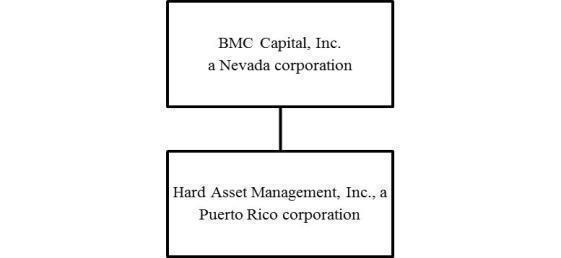
We desire to become one of the leading companies in managing and selling rare coins, precious metals and other antiquities within the hard asset industry. Accordingly, we will offer an alternative to auction houses and wholesalers, thereby allowing collectors to purchase and sell such hard assets through our online marketplace created through our website bmchardassets.com, which was completed in August 2016. The base content of our website will remain the same, but the inventory section will be constantly updated with new items. Through our website, we intend to sell to, and act as a selling agent for, collectors who desire to sell antiquities, rare coins and precious metals. We have three Acquisition and Management programs, which will allow collectors to choose their purchase amounts, the Silver Account ($50,000-$250,000); the Gold Account ($250,000 - $1,000,000) and the Platinum Account (more than $1,000,000).
Our operations to date have been devoted primarily to start-up business development activities. While our President, Chief Executive Officer and Chief Creative Officer have performed start-up activities such as acquiring our Subsidiary and creating our website, our Subsidiary has commenced operations, which include the following:
| · | Research antiquities, rare coins and precious metals for purchase and resale | |
| · | Research trends in the antiquities, rare coins and the precious metals industries | |
| · | Research and develop our online market place through our website bmchardassets.com | |
| · | Identify office space and storage facilities to lease in Puerto Rico |
We anticipate that we will receive revenue from the sale of Hard Assets. Additionally, we intend to charge a commission for transfers that occur through our website, which we anticipate will be a percentage of gross sales proceeds.
| 6 |
| Table of Contents |
Our principal executive office is located at 700 Lavaca Street, Suite 1419, Austin, Texas 78701, however all notices and correspondence is sent to 3267 Bee Caves Road, Suite 107-122, Austin, Texas 78746. Our telephone number is (512) 553-6785.
The principal executive office for our Subsidiary is located at 332 Dorado Beach East, Dorado, Puerto Rico 00646. Our Subsidiary’s telephone number is (787) 948-0072.
Our fiscal year ends on December 31.
As of the date of this prospectus, we have not sold any of the Hard Assets nor have any transfers of the Hard Assets been made through our website. Our net losses for the period ending December 31, 2015, and June 30, 2016, were ($12,291) and ($131,113), respectively.
As of the date of this prospectus, we have 178,011,826 shares of our $.001 par value common stock issued and outstanding and held by 50 shareholders. 263,158 shares of that common stock were offered and sold to Leslie Ball, a member of our board of directors, at a purchase price of $.19 per share and an additional 263,158 shares of that common stock were issued to Leslie Ball for marketing and consulting services rendered to the Company. 152,900,000 shares of that common stock were issued to Heron Capital Partners Ltd. (“Heron”) for sales, marketing, purchasing and administrative services rendered to the Company by Christian Briggs, our President, Chief Executive Officer and chairman of our board of directors. Heron intends to transfer those shares to Peach Management, LLC, a Puerto Rico limited liability company (“Peach”). The membership units of Peach are held by Christian Briggs and his wife, Julie Briggs, equally. 100,000 shares of that common stock were issued to Thomas Gingerich, our Chief Financial Officer and a member of our board of directors, for accounting, sales and administration services rendered to the Company. 10,000 shares of that common stock were issued to Delfino Galindo, our Chief Creative Officer, for creating our website and consulting services rendered to the Company. The remaining 24,475,510 shares of that common stock were offered and sold at purchase prices of $.01 to .30 per share.
We are registering 1,348,354 shares of our common stock held by 47 shareholders pursuant to the Securities Act of 1933 for sale by those shareholders, which are named later in this prospectus. Our officers and directors hold 153,536,316 shares of our common stock, and 127,040 of those shares are being registered.
As of June 30, 2016, we had $300 in current assets and $676,689 in liabilities. Accordingly, our working deficit position as of June 30, 2016, was $676,389.
As of December 31, 2015, we had $492 in current assets and $545,768 in liabilities. Accordingly, our working deficit position as of December 31, 2015, was $545,276.
As of August 31, 2016, our cash on hand was $5,206. Currently, we do not have enough cash to finance our operations. We have incurred operating losses since our formation and expect to incur losses for the foreseeable future, and we may not achieve profitability. We expect to incur negative cash flows as we increase our inventory and incur operating losses. Because of the operating losses and negative cash flows, there is substantial doubt as to our ability to continue as a going concern. We will need to generate revenues in excess of the current amounts to achieve profitability and positive cash flows necessary to continue operating our business.
| 7 |
| Table of Contents |
Yuma Properties, LP., which is beneficially owned by Christian Briggs, our Chief Executive Officer, President and member of our Board of Directors (“Yuma”), lends us the funds necessary to operate our business. In that regard, we have a written Senior Secured Line of Credit with Yuma pursuant to which we can borrow from Yuma the principal amount of $250,000, which accrues at an interest rate of 10% per annum, commencing on the dates the funds are borrowed. We can provide no guarantee or assurance that we can pay the amount lent, or any other amount, on the date the borrowed funds are to be repaid, May 31, 2017. A copy of that Senior Secured Line of Credit is attached as Exhibit 99.1 to that registration statement of which this prospectus is a part. As of August 31, 2016, Yuma has lent us $155,000. Funds lent pursuant to that Senior Secured Line of Credit are due and payable on May 31, 2017; provided, however, accrued interest on the outstanding balance of advances is required to be paid monthly. To date, we have not made any payments of such interest. The transaction contemplated by that Senior Secured Line of Credit does not contemplate a revolving line of credit, and amounts we pay to Yuma for advances made pursuant to that Senior Secured Line of Credit may not be borrowed by us again. Our operating expenses are approximately $64,000 each month.
We anticipate to fund our operations for the next 12 months we will require approximately (i) $1,800,000.00 for inventory, which we anticipate that we will acquire during the first 3 months after we have sufficient funding; (ii) $64,000 each month for operating expenses ($768,000); and (iii) $200,000 for working capital, for a total of $2,768,000. We anticipate that we should be able to generate cash in excess of $50,000 from the sale of our current inventory. That inventory is fully paid, and the proceeds from the sale of that inventory will be used to purchase additional inventory, pay our general and administrative expenses, and additional working capital necessary to conduct our business. Additionally, we have commenced the offer and sale of up to 6,666,666 shares of our common stock at $0.30 per share in a private placement transaction pursuant to Section 4(a)(2) of the Securities Act of 1933, as amended (the “Securities Act”) and Rule 506(b) of Regulation D (the “Offering”). As of the date of this prospectus, no capital has been raised pursuant to the Offering.
To the extent we are not able to raise any capital pursuant to the Offering or sell our inventory or the sale of our inventory does not provide sufficient proceeds to fund our operations, we will continue to borrow money from Yuma. In the event Yuma cannot lend us funds necessary to support our operations during the next 12 months, we plan to obtain additional funds through revenue from operations, private placements of our capital stock and/or loans from sources other than Yuma.
Employees of the Company
Presently, we have 4 employees.
Thomas Gingerich is our Chief Financial Officer.
Delfino Galindo is our Chief Creative Officer.
Josh Gottesgen and Patrick Kliesch are full-time employees of the Company that assist us in our website development, video production and live show on our website.
We anticipate that on or about November 1, 2016, Mr. Gingerich, Mr. Galindo, Mr. Gottesgen and Mr. Kliesch will cease being employees of the Company and will become employees of the Subsidiary in similar capacities.
Currently, we have no written employment agreements with our employees.
| 8 |
| Table of Contents |
Our officers and directors are responsible for all planning, development and operational duties and will continue to do so throughout the early stages of our growth. Human resource planning will be a part of an ongoing process that will include regular evaluation of our operations. We intend to hire additional employees at such time as we determine it is appropriate. We can provide no assurance or guarantee on the date on which we will hire employees.
Christian R. Briggs is our Chief Executive Officer, President and chairman of our board of directors. He is not an employee of the Company; rather, he provides his services to the Company pursuant to a Professional Services Agreement between the Company, on the one hand, and Heron, on the other hand. It is anticipated that on or about November 1, 2016, that agreement will terminate and Mr. Briggs will become an employee of the Subsidiary in similar capacities.
Employees of our Subsidiary
Our Subsidiary, currently, has no employees.
We have no present plans to be acquired or to merge with another company, nor do our directors or shareholders have plans to enter into a change of control or similar transaction.
Jumpstart Our Business Startups Act (the “JOBS Act”)
We have elected to not opt out of the JOBS Act extended accounting transition period. This may make our financial statements more difficult to compare to other companies.
Pursuant to the JOBS Act, as an emerging growth company, we can elect to opt out of the extended transition period for any new or revised accounting standards that may be issued by the PCAOB or the SEC. We have elected not to opt out of such extended transition period, which means that when a standard is issued or revised and it has different application dates for public or private companies, we, as an emerging growth company, can adopt the standard for the private company. This may make comparison of our financial statements with any other public company which is not either an emerging growth company or an emerging growth company which has opted out of using the extended transition period difficult or impossible, as possible different or revised standards may be used.
Emerging Growth Company:
The JOBS Act is intended to reduce the regulatory burden on emerging growth companies. We meet the definition of an emerging growth company and as long as we qualify as an “emerging growth company,” we will, among other things:
| · | be temporarily exempted from the internal control audit requirements Section 404(b) of the Sarbanes-Oxley Act; | |
|
| |
| · | be temporarily exempted from various existing and forthcoming executive compensation-related disclosures, for example: “say-on-pay”, “pay-for- performance”, and “CEO pay ratio”; | |
|
| |
| · | be temporarily exempted from any rules that might be adopted by the Public Company Accounting Oversight Board requiring mandatory audit firm rotation or supplemental auditor discussion and analysis reporting; | |
|
| |
| · | be temporarily exempted from having to solicit advisory say-on-pay, say- on-frequency and say-on-golden-parachute shareholder votes regarding executive compensation pursuant to Section 14A of the Securities Exchange Act of 1934, as amended (the “Exchange Act”); | |
|
| |
| · | be permitted to comply with the SEC’s detailed executive compensation disclosure requirements on the same basis as a smaller reporting company; and | |
|
| |
| · | be permitted to adopt any new or revised accounting standards using the same timeframe as private companies (if the standard applies to private companies). |
| 9 |
| Table of Contents |
We will continue to be an emerging growth company until the earliest of:
· the last day of the fiscal year during which we have annual total gross revenues of $1 billion or more; · the last day of the fiscal year following the fifth anniversary of the first sale of our common equity securities in an offering registered pursuant to the Securities Act of 1933, as amended; · the date on which we issue more than $1 billion in non-convertible debt securities during a previous three-year period; or · the date on which we become a large accelerated filer, which generally is a company with a public float of at least $700 million (Exchange Act Rule 12b-2).
The offering
Securities being offered: | Up to 1,348,354 shares of our common stock, $.001 par value by the selling stockholders. |
Offering price per share: | $.30 |
Offering period: | The shares will be offered on a time-to-time basis by the selling stockholders. |
Net proceed: | We will not receive any proceeds from the sale of the shares. |
Use of proceed: | We will not receive any proceeds from the sale of the shares. |
Number of Shares of Common Stock Authorized and Outstanding: | 178,011,826 shares of common stock issued and outstanding, 249,000,000 shares of $.001 par value common stock authorized. |
The number of shares of our common stock outstanding excludes:
| · | A total of 20,000,000 shares of common stock reserved for future issuance pursuant to our 2016 Equity Incentive Plan, which we refer to as the “Plan”; | |
|
| |
| · | A total of 1,000,000 shares of common stock issuable upon the conversion of shares of our preferred stock; and | |
|
| |
| · | Those shares of our common stock issuable upon the conversion of a Convertible Demand Promissory Note dated June 16, 2011, in the principal amount of $47,125. |
There is no trading market for our common stock. We intend to apply for participation on the Over-the-Counter Bulletin Board (“OTCBB”), and we hope that thereafter such trading market will develop. The selling stockholders will sell at a fixed price of $.30 per share until prices of our common stock are quoted on the OTCBB and thereafter at prevailing market prices or privately negotiated prices.
We intend to enter into an agreement with a broker-dealer registered with the Securities and Exchange Commission (the “SEC”) and a member in good standing of FINRA to assist us in connection with causing the prices of our common stock to be quoted on the OTCBB. There can be no assurance that any application filed by any sponsoring market maker for such quotation on the OTCBB will be approved.
| 10 |
| Table of Contents |
Selected Financial Information
|
| For the year ended December 31, 2015 |
|
| For the year ended December 31, 2014 |
|
| For the 6 months ended June 30, 2016 (unaudited) |
| |||
|
|
|
|
|
|
|
|
| ||||
BALANCE SHEET DATA: |
|
|
|
|
|
|
|
|
| |||
Current Assets: |
| $ | 492 |
|
| $ | 302 |
|
| $ | 300 |
|
Total Assets: |
| $ | 492 |
|
| $ | 302 |
|
| $ | 300 |
|
Total Liabilities: |
| $ | 545,768 |
|
| $ | 533,287 |
|
| $ | 676,689 |
|
Stockholders’ Deficit |
| $ | (545,276 | ) |
| $ | (532,985 | ) |
| $ | (676,389 | ) |
| For the year ended December 31, 2015 |
|
| For the year ended December 31, 2014 |
|
| For the 6 months ended June 30, 2016 (unaudited) |
| ||||
STATEMENT OF OPERATIONS DATA: |
|
|
|
|
|
|
|
| ||||
Revenue: |
| $ | 0 |
|
| $ | 0 |
|
| $ | 0 |
|
Gross Profit: |
| $ | 0 |
|
| $ | 0 |
|
| $ | 0 |
|
Operating Expenses: |
| $ | 5 |
|
| $ | 75 |
|
| $ | 121,656 |
|
Other Expenses (Interest): |
| $ | 12,286 |
|
| $ | 12,286 |
|
| $ | 9,457 |
|
Net (Loss): |
| $ | (12,291 | ) |
| $ | (12,361 | ) |
| $ | (131,113 | ) |
The foregoing summary information is qualified by and should be read in conjunction with our financial statements and accompanying footnotes, appearing elsewhere in the registration statement of which this prospectus is a part.
This prospectus contains forward-looking statements, which relate to future events or our future financial performance. In some cases, those forward-looking statements can be identified by terminology such as “may”, “should”, “expects”, “plans”, “anticipates”, “believes”, “estimates”, “predicts”, “potential” or “continue” or the negative of these terms or other comparable terminology. These statements are only predictions and involve known and unknown risks, uncertainties and other factors, including the risks specified below that may cause our actual results, levels of activity, performance or achievements to be materially different from any future results, levels of activity, performance or achievements expressed or implied by these forward-looking statements.
| 11 |
| Table of Contents |
While these forward-looking statements, and any assumptions upon which they are based, are made in good faith and reflect our current judgment regarding the direction of our business, actual results will almost always vary, sometimes materially, from any estimates, predictions, projections, assumptions or other future performance suggested herein. Except as required by applicable law, including the securities laws of the United States, we do not intend to update any of the forward-looking statements to conform these statements to actual results.
Investors should carefully consider the following factors in evaluation our business, operations and financial condition. Additional risks and uncertainties not presently known to us, that we currently deem immaterial, or that are similar to those faced by other companies in our industry or business in general, such as competitive conditions, may also impair our business operations. The occurrence of any of the following risks could have a material adverse effect on our business, financial condition and results of operations.
Risks Related to Our Business
Our limited operating history makes it difficult to evaluate our business and future prospects. There is no assurance our future operations will result in profitable revenues. If we cannot generate sufficient revenues to operate profitably, we may suspend or cease operations.
Our limited operating history makes it difficult to evaluate our business and future prospects. We were formed in 2009, but have a minimal operating history. Our operations have consisted mainly of identifying sources of antiquities, rare coins and precious metals, developing our website and otherwise organizing and planning our operations. Currently, we are minimally capitalized and have limited operations and no revenue.
Our net losses for the period ending December 31, 2015, and June 30, 2016, were ($12,291) and ($131,113), respectively. As of August 31, 2016, our cash on hand was $5,206. Currently, we do not have enough cash to finance our operations.
Any purchaser of our common stock should consider our business and prospects in light of the risks and difficulties we will encounter as an early stage business. These risks include:
| · | our ability to identify and acquire antiquities, investment quality antiquities, rare coins and precious metals at prices that are advantageous to us; | |
|
| |
| · | our ability to effectively and efficiently market and distribute our products; | |
|
| |
| · | our ability to obtain market acceptance of our current and future products; | |
|
| |
| · | our ability to sell our products at competitive prices, which exceed our per unit costs; and | |
|
| |
| · | our ability to maximize the profitability of our business operations. |
| 12 |
| Table of Contents |
We may not be able to resolve these risks and difficulties, which could materially and adversely affect our revenue, operating results and our ability to continue to operate our business.
We can provide no assurance that we will be successful in generating sufficient revenues to support our operations in the future. Our ability to generate future revenues will be dependent on a number of factors, most of which are beyond our control, including demand for rare coins, precious metals and antiquities, market competition and government regulation. Failure to generate sufficient revenues may force us to cease operations and you could lose all or part of your investment. As with any investment in a company with a limited operating history, ownership of our securities may involve significant risks and is not recommended if an investor cannot reasonably accommodate the risk of a total loss of his or her investment.
We require additional funding to continue our operations. If we do not secure additional funding, we may not be able to continue as a going concern.
We incurred a net loss of ($131,113) for the six months ended June 30, 2016. We incurred a net loss of ($12,291) for the year ended December 31, 2015. We anticipate these losses will continue for the foreseeable future.
On June 30, 2016, we had cash reserves of $0 and negative retained earnings of ($2,830,517). On December 31, 2015, we had cash reserves of $192 and negative retained earnings of ($2,699,404). We estimate that such cash reserves are not sufficient to fund our daily operations. To fund our daily operations we must raise additional capital. No guarantee or assurance can be given that we will receive additional funds required to fund our daily operations. In addition, in the absence of the receipt of additional funding, we may be required to scale back our operations. Currently, we do not have enough cash to finance our operations for even one month. We have secured from Yuma, and an affiliate of Christian Briggs, our President and Chief Executive Officer, a Senior Secured Line of Credit in the principal amount of $250,000. Currently, Yuma has advanced to us the principal amount of $155,000. Accordingly, there remains available to us the principal amount of $95,000 of that line of credit.
We anticipate to fund our operations for the next 12 months we will require approximately (i) $1,800,000 for inventory, which we anticipate that we will acquire during the first 3 months after we have sufficient funding; (ii) $64,000 each month for operating expenses ($768,000); and (iii) $200,000 for working capital, for a total of $2,768,000. We plan to meet any shortfall of cash necessary to fund our operations through revenue from operations, private placements of our capital stock and/or loans from sources other than Yuma.
A copy of the Senior Secured Line of Credit is attached as Exhibit 99.1 to that registration statement to which this prospectus is a part.
Because of the lingering effects of the recession and the lack of available credit for businesses such as ours, we may be hampered in our ability to raise the necessary working capital. We cannot provide any assurance that any additional funding will be available to us, or if available, will be on terms favorable to us. If we do not raise the necessary working capital and or increase our revenue, we will not be able to remain operational.
Our failure to raise additional capital or generate the cash necessary to finance our business could force us to limit or cease our operations. Accordingly, we will need to raise additional funds, and we may not be able to obtain additional funds on favorable terms, if at all. If we raise additional funds by the sale of our common stock, our stockholders may experience significant dilution of their ownership interests, and the per-share value of our common stock could decline.
Because we are currently considered a “shell company” within the meaning of Rule 12b-2 pursuant to the Securities Exchange Act of 1934, the ability of holders of our common stock to sell their shares may be limited by applicable regulations.
We are, currently, considered a “shell company” within the meaning of Rule 12b-2 pursuant to the Securities Exchange Act of 1934 and pursuant to Rule 405 of the Securities Act of 1933, in that we currently have (i) nominal assets and operations; and (ii) our assets consist solely of cash and cash equivalents. Accordingly, the ability of holders of our common stock to sell their shares may be limited by applicable regulations.
| 13 |
| Table of Contents |
As a result of our classification as a “shell company”, our investors are not allowed to rely on the “safe harbor” provisions of Rule 144 promulgated pursuant to the Securities Act of 1933 so as not to be considered underwriters in connection with the sale of our securities until one year from the date that we cease to be a “shell company.” Additionally, as a result of our classification as a shell company:
| · | investors should consider shares of our common stock to be significantly risky and illiquid investments; | |
|
| |
| · | we may not register our securities on Form S-8 (an abbreviated form of registration statement); and | |
|
| |
| · | our ability to attract additional funding to sustain our operations may be limited significantly. |
We can provide no assurance or guarantee that we will cease to be a “shell company” and, accordingly, we can provide no assurance or guarantee that there will be a liquid market for our shares. Accordingly, investors may not be able to sell our shares and lose their investments in the Company.
Our auditor has expressed substantial doubt about our ability to continue as a going concern.
We may not be able to generate profitable operations in the future or obtain the necessary financing to meet our obligations and repay liabilities arising from normal business operations when they come due. The outcome of these matters cannot be predicted with any certainty at this time. These factors raise substantial doubt that we will be able to continue as a going concern. We plan to continue to provide for our capital needs through related party advances. Our financial statements do not include any adjustments to the amounts and classification of assets and liabilities that may be necessary should we be unable to continue as a going concern.
Material weaknesses in our internal controls and financial reporting may limit our ability to prevent or detect financial misstatements or omissions. As a result, our financial reports may not be in compliance with U.S. GAAP. Any material weakness, misstatement or omission in our financial statements will negatively affect the market and the price of our stock, which could result in significant losses to our investors.
Our current management does not possess recent experience managing and operating a public company. We rely in many instances on the professional experience and advice of third parties. Therefore, we may, in turn, experience “weakness” and potential problems in implementing and maintaining adequate internal controls as required under Section 404 of the “Sarbanes-Oxley” Act of 2002. This “weakness” also includes a deficiency, or combination of deficiencies, in internal controls over financial reporting, such that there is a reasonable possibility that a material misstatement of our annual or interim financial statements will not be prevented or detected on a timely basis. If we fail to achieve and maintain the adequacy of our internal controls, as such requirements are modified, supplemented or amended from time to time, we may not be able to ensure that we can conclude on an ongoing basis that we have effective internal controls over financial reporting in accordance with Section 404 of the Sarbanes-Oxley Act of 2002. Moreover, effective internal controls, particularly those related to revenue recognition, are necessary for us to produce reliable financial reports and are important to help prevent financial fraud. If we cannot provide reliable financial reports or prevent fraud, our business and operating results could be harmed, investors could lose confidence in our reported financial information, and the trading price of our common stock, if a market ever develops, could drop significantly.
| 14 |
| Table of Contents |
Pursuant to Section 404 of the Sarbanes-Oxley Act, we are required to include in our annual reports our assessment of the effectiveness of our internal control over financial reporting as of the end of our fiscal years. We have not yet completed any assessment of the effectiveness of our internal control over financial reporting. We expect to incur additional expenses and diversion of management’s time as a result of performing the system and process evaluation, testing, and remediation required in order to comply with the management certification.
As we are an emerging growth company and have elected not to opt out of the extended transition period created by the provisions of the JOBS Act, during that transition period, our independent auditor shall not attest to, and report on, the assessment made by our management regarding the effectiveness of our internal control structure and procedures for financial reporting.
As we have elected to use the extended transition period for complying with new or revised accounting standards pursuant to the JOBS Act, our financial statements may not be comparable to public companies that are not emerging growth companies.
Section 107 of the JOBS Act provides that an emerging growth company can take advantage of the extended transition period provided in Section 7(a)(2)(B) of the Securities Act of 1933 for complying with new or revised accounting standards. An emerging growth company can, therefore, delay the adoption of certain accounting standards until those standards would otherwise apply to private companies. We have elected to take advantage of the benefits of this extended transition period. Our financial statements may, therefore, not be comparable to those public companies that comply with such new or revised accounting standards.
Our officers and directors control approximately 86% of the Company, giving them significant voting power, which allows them to take action that may not be in the best interest of all other shareholders.
Christian Briggs, our Chief Executive Officer, President and chairman of our board of directors; Delfino Galindo, our Chief Creative Officer; Thomas Gingerich, our Chief Financial Officer and a member of our board of directors, and Leslie Ball, a member of our board of directors, beneficially own approximately 86% of our outstanding shares of common stock as of the date of this prospectus. As a result, they have control of most matters requiring approval by our stockholders, without the approval of our minority stockholders. They will, also, be able to affect most corporate matters requiring stockholder approval by written consent, without the need for a duly noticed and duly held meeting of our stockholders. Accordingly, our other shareholders will be limited in their ability to affect change in how we conduct our business. Mr. Briggs, Mr. Galindo, Mr. Gingerich, and Mr. Ball have significant influence in determining the outcome of any corporate transaction or other matters submitted to our shareholders for approval, including mergers, consolidations and the sale of all or substantially all of our assets, the election of directors and other significant corporate actions. In addition to their stock ownership, they are key to our operations and have significant influence over our key decisions. This concentration of ownership and influence over our decision-making may also discourage, delay or prevent a change in control of the Company, which could deprive our shareholders of an opportunity to receive a premium for their shares as part of a sale of the Company and might reduce the price of our common stock. These actions may be taken even if they are opposed by our other shareholders.
Additionally, we are authorized to issue 1,000,000 shares of preferred stock. All of those shares of preferred stock are convertible into shares of our common stock on a 1 share per 1 share basis. Additionally, each share of our preferred stock is entitled to 250 votes per share on all matters submitted to our stockholders for a vote. Those 1,000,000 shares of our preferred stock were issued to Heron. Heron intends to transfer those shares to Peach. The membership units of Peach are held by Christian Briggs, our President and Chief Executive Officer, and his wife, Julie Briggs, equally. Accordingly, in addition to those shares of common stock currently held by Heron, Mr. Briggs is in a position to influence the vote of those 1,000,000 shares of our preferred stock.
| 15 |
| Table of Contents |
Our officers and directors are aware of their fiduciary duties to the Company and its shareholders and will make every effort to consider the best interests of the Company and its shareholders in connection with the relationship between the Company and our Subsidiary. We cannot provide any assurance, however, that our officers and directors will not engage in conduct or make decisions which are not in the best interest in the Company. Such decisions could harm our operations, business plans and cash flows.
We have not formulated a plan to resolve any possible conflict of interest with our directors’ and officers’ other business activities. In the event they are unable to fulfill any aspect of their duties to the Company, we may experience little or no profits and eventual closure of business.
Because Christian Briggs, Delfino Galindo, Thomas Gingerich, and Leslie Ball (our officers and directors) have other outside business activities and will have limited time to spend on our business, our operations may be sporadic, which may result in periodic interruptions or suspensions of operations.
In addition to having other outside business activities, our officers and directors who are also officers and directors of our Subsidiary, which conducts the majority of our operations, will only be devoting approximately 5 hours per week to the Company and between 10-40 hours per week to our Subsidiary. Accordingly, our operations may be sporadic and occur at times which are convenient to Mr. Briggs, Mr. Galindo, Mr. Gingerich, and Mr. Ball. Christian Briggs will devote up to 5 hours to the Company and 40 hours to our Subsidiary per week; Delfino Galindo will devote 0 hours to the Company and up to 40 hours per week to our Subsidiary; Thomas Gingerich, will devote up to 5 hours per week to the Company and approximately 40 hours per week to our Subsidiary; and Leslie Ball will devote up to 5 hours per week to the Company and approximately 10 hours per week to our Subsidiary. In the event they are unable to fulfill any aspect of their duties to the Company, we may experience a shortfall or complete lack of sales resulting in little or no profits and eventual closure of the business.
We are dependent upon our current officers and directors, and the loss of one or more of our executive officers or directors or an inability to attract and retain highly skilled employees could compromise our ability to pursue our growth strategy and grow our business.
Our success depends in large part on the continued service and efforts of our key management personnel. We are currently managed by 3 officers (Christian Briggs, Delfino Galindo, and Thomas Gingerich) and 3 directors (Christian Briggs, Leslie Ball and Thomas Gingerich) and we are entirely dependent upon them to conduct our operations. If they should resign or die, there could be no one to operate the Company. If our current officers and directors are no longer able to serve as such and we are unable to find other persons to replace them, it will have a negative effect on our ability to continue active business operations and could result in investors losing some or all of their investment in the Company. Additionally, competition for qualified management in our industry is intense. Many of the companies with which we compete for management personnel have greater financial and other resources than we do. As a result, we may experience difficulty hiring and retaining qualified personnel.
To grow our business, we will need the assistance of additional sales representatives knowledgeable in the industry. There is no guarantee we can add such sales representatives to assist in future growth.
Our officers and directors have limited experience in the rare coin, precious metals and antiquities business, and we may have to hire qualified consultants to assist us in our operations. If we cannot locate qualified consultants, we may have to suspend or cease operations which will result in the loss of your investment.
Christian Briggs, our Chief Executive Officer and a member of our Board of Directors, has experience in our industry, but due to his lack of recent experience in the rare coin, precious metals and antiquities business, he and our other officers (who have no such experience) may make decisions and choices that negatively impact our operations, including marketing and sales. Consequently, our operations, earnings and ultimate financial success could suffer irreparable harm due to management's lack of experience in this industry. As a result, we may have to suspend or cease operations which will result in the loss of our shareholders’ investments. We may decide to hire independent consultants to assist us in sales and marketing. As independent consultants, with no fiduciary responsibility to our shareholders, their expertise and sales ability may fall short of our expectations and not assist in our growth, but cause us to incur additional expense for their services. Without name recognition, we will have a definite marketing challenge, and our competitors will have advantages in attracting customers.
| 16 |
| Table of Contents |
If we are unable to retain key personnel, it will have an adverse effect on our business. We do not maintain “key man” life insurance policies on our key personnel.
The conduct of our business is dependent on retaining the services of qualified personnel. The loss of key management, the inability to secure or retain such key personnel with unique knowledge of our business or our inability to attract and retain sufficient numbers of other qualified personnel would adversely affect our business and could have a material adverse effect on our business, operating results, and financial condition.
We do not have “key man” life insurance policies for any of our key personnel. If we were to obtain “key man” insurance for our key personnel, of which there can be no assurance, the amounts of such policies may not be sufficient to pay losses experienced by us as a result of the loss of any of those personnel.
We may not maintain sufficient insurance coverage for the risks associated with our business operations.
Risks associated with our business operations include, but are not limited to, claims for wrongful acts committed by our officers, directors, and other representatives, the loss of intellectual property rights, the loss of key personnel and risks posed by natural disasters. Any of these risks may result in significant losses. We do not carry business interruption insurance. In addition, we cannot provide any assurance that our insurance coverage is sufficient to cover any losses that we may sustain, or that we will be able to successfully claim our losses under our insurance policies on a timely basis or at all. If we incur any loss not covered by our insurance policies, or the compensated amount is significantly less than our actual loss or is not timely paid, our business, financial condition and results of operations could be materially and adversely affected.
We intend to become subject to the periodic reporting requirements of the Securities Exchange Act of 1934, which will require us to incur audit fees and legal fees in connection with preparation of reports. These additional costs could reduce or eliminate our ability to operate profitability.
Following the effective date of this registration statement of which this prospectus is a part, we will be required to file periodic reports with the SEC pursuant to the Securities Exchange Act of 1934 and the rules and regulations promulgated thereunder. In order to comply with these requirements, our independent registered public accounting firm will have to review our financial statements on a quarterly basis and audit our financial statements on an annual basis. Moreover, our legal counsel will have to review and assist in the preparation of such reports. The costs charged by these professionals for such services cannot be accurately predicted at this time, because factors such as the number and type of transactions that we engage in and the complexity of our reports cannot be determined and such factors will have a major effect on the amount of time to be spent by our auditors and attorneys. These costs will be expenses of our operations and, therefore, have a negative effect on our ability to pay our other costs and expenses and earn a profit.
Conversion of our preferred stock to common stock could result in dilution to our shareholders.
Heron, currently, holds 1,000,000 shares of our preferred stock. Those shares of our preferred stock are convertible, on a one share for one share basis, into shares of our common stock. Heron is beneficially owned by Christian Briggs, our Chief Executive Officer, President and Chairman of our board of directors. If Mr. Briggs converts shares of our preferred stock to shares of our common stock, our other stockholders may experience dilution of their ownership interests, and the per share value of our common stock could decline. There are no restrictions regarding the conversion of that preferred stock by Mr. Briggs.
| 17 |
| Table of Contents |
Our information systems and website may be susceptible to cybersecurity breaches and other risks.
We anticipate that we will receive revenue from the sale of Hard Assets through our website, bmchardassets.com. We also intend to charge a commission for transfers that occur through that website. Additionally, we have information systems that support our business, including service development, marketing, sales, and intracompany communications. Our website and systems may be susceptible to outages due to fire, floods, power loss, telecommunication failures, break-in and other events. Additionally, our website and systems may be vulnerable to cybersecurity breaches such as computer viruses, break-in and similar disruptions from unauthorized tampering. The occurrence of these or other events could disrupt or damage our information systems and adversely affect our business and results of operations.
Our growth strategy contemplated by our business plan may not be achievable or may not result in profitability.
We may not be able to implement the growth strategy contemplated in our business plan fast enough for us to achieve profitability. Our growth strategy is dependent on a number of factors, including market acceptance of our products. We can provide no assurance that potential customers will purchase our products or that those customers will purchase our products at the cost and on the terms assumed in our business plan. Among other things, implementation of our growth strategy would be adversely affected if:
· | we are not able to attract sufficient customers to the products we offer, considering the price and other terms required in order for us to attain the level of profitability that will enable us to continue to pursue our growth strategy; |
·
| adequate penetration of new markets at a reasonable cost becomes impossible, in turn limiting the future demand for our products below the level assumed by our business plan; |
· | we are forced to significantly adapt our business plan to meet changes in our markets; and |
· | for any reason, we are not able to attract, hire, retain and motivate qualified personnel. |
If we cannot manage our growth effectively, we may not become profitable.
Businesses which grow rapidly often have difficulty managing their growth. If we grow as rapidly as we anticipate, we will need to expand our management by recruiting and employing experienced executives and key employees capable of providing the necessary support. We can provide no assurance that our management will be able to manage our growth effectively or successfully. Our failure to meet these challenges could cause us to lose money and our shareholders’ investments in us could be lost.
Among other things, implementation of our growth strategy would be adversely affected if we were not able to attract sufficient customers for the products we offer or plan to offer considering the price and other terms required for us to attain the necessary profitability.
| 18 |
| Table of Contents |
Risks Related to our Common Stock
We are an “emerging growth company,” and any decision on our part to comply with certain reduced disclosure requirements applicable to emerging growth companies could make our common stock less attractive to investors.
We are an “emerging growth company,” as defined in the Jumpstart Our Business Startups Act enacted in April 2012, and, for as long as we continue to be an emerging growth company, we may choose to take advantage of exemptions from various reporting requirements applicable to other public companies, including, but not limited to, not being required to comply with the auditor attestation requirements of Section 404 of the Sarbanes-Oxley Act of 2002, reduced disclosure obligations regarding executive compensation in our periodic reports and proxy statements, and exemptions from the requirements of holding a nonbinding advisory vote regarding executive compensation, and stockholder approval of any golden parachute payments not previously approved. We could be an emerging growth company for up to five years, although, if the market value of our common stock that is held by non-affiliates exceeds $700 million during that five-year period or we issue more than $1 billion of non-convertible debt during a 3 year period, we would cease to be an “emerging growth company”. We cannot predict if investors will determine that our common stock is less desirable, if we choose to rely on those exemptions. If some investors determine that our common stock is less desirable, as a result of any choices to reduce future disclosure, there may be a less active trading market for our common stock and our stock price may be more volatile.
Currently, there is no public market for our common stock, and there can be no assurance that any public market will ever develop or that our common stock will be quoted for trading and, even if quoted, it will probably be subject to significant price fluctuations. We anticipate our common stock may be quoted on the OTCBB, which may result in limited liquidity and the inability of our stockholders to maintain accurate price quotations for our common stock.
Prior to the date of this prospectus, there was not an established trading market for our common stock, and there is currently no public market whatsoever for our common stock. We intend to retain a broker-dealer registered with the SEC and a member in good standing of FINRA to file an application with FINRA, so as to enable the quotation for the prices of our common stock on the OTCBB. There can be no assurance as to whether any market maker will file that application or if that application will be accepted by FINRA. We are not permitted to file such application on our own behalf. If that application is accepted, there can be no assurance as to whether any market for our common stock will develop or the prices at which our common stock will trade. If that application is accepted, we cannot predict the extent to which investor interest in us will result in the development of an active, liquid trading market. Active trading markets generally result in lower price volatility and more efficient execution of buy and sell orders for investors.
In addition, it is probable that our common stock will not be followed by any market analysts, and there may be few institutions acting as market makers for our common stock. Either of these factors could adversely affect the liquidity and trading price of our common stock. Until an orderly market develops in our common stock, if ever, the price at which it trades will probably fluctuate significantly. Prices for our common stock will be determined in the market and may be influenced by many factors, including the depth and liquidity of the market for our common stock, developments affecting our business, including the impact of the factors referred to elsewhere in these RISK FACTORS, investor perception, and general economic and market conditions. No assurance can be given that an orderly or liquid market will develop for our common stock. Because of the anticipated low price of our common stock, many brokerage firms may not be willing to effect transactions in our common stock.
| 19 |
| Table of Contents |
Upon our liquidation, holders of our preferred stock are entitled to receive the first proceeds from the liquidation of our assets.
In the event of any liquidation, dissolution or winding up of our affairs, the holders of the shares of our preferred stock then outstanding are entitled to receive an amount equal to $1 per share from our assets legally available for distribution to our shareholders, whether from capital, surplus or earnings, and before any payment shall be made to the holders of our common stock. In the event of any such liquidation, dissolution or winding up, there may not be sufficient proceeds from such liquidation, dissolution or winding up after the payment to the holders of our preferred stock of funds sufficient to return to the holders of our common stock the amounts of their investments, or any amount whatsoever.
The market price, if any, for our common stock may be volatile.
If a market price for our common stock should develop, that market price for our common stock may be volatile and subject to significant fluctuations in response to factors including the following:
| · | liquidity of the market for our shares of common stock; | |
| · | actual or anticipated fluctuations in our operating results; | |
| · | sales of substantial amounts of our common stock, or the perception that such sales might occur; | |
| · | changes in financial estimates by securities research analysts; | |
| · | changes in the economic performance or market valuations of other companies in our industry; | |
| · | announcements by us or our competitors of acquisitions, strategic partnerships, joint ventures or capital commitments; | |
| · | addition or departure of key personnel; | |
| · | fluctuations of exchange rates between foreign currencies and the U.S. dollar; | |
| · | our dividend policy; and | |
| · | general economic or political conditions. |
Our operating results may decline below the expectations of our investors. In that event, the market price of our common stock, if any, would likely be materially adversely affected, and the value of our common stock may decline. In addition, the securities market has, from time to time, experienced significant price and volume fluctuations that are not related to the operating performance of particular companies. These market fluctuations may, also, materially and adversely affect the market price of our common stock, if any.
Volatility in our common share price may subject us to securities litigation.
The market for our common stock, if one develops, may be characterized by significant price volatility, and we expect that our share price may be more volatile than a seasoned issuer for the indefinite future. In the past, plaintiffs have often initiated securities class action litigation against a company following periods of volatility in the market price of its securities. We may, in the future, be the target of similar litigation. Securities litigation could result in substantial costs and liabilities and could divert our management's attention and resources.
Certain provisions of Nevada law provide for indemnification of our officers and directors at our expense and limit their liability, which may result in a major cost to us and damage the interests of our shareholders, because our resources may be expended for the benefit of our officers and/or directors.
Applicable Nevada law provides for the indemnification of our directors, officers, employees, and agents, under certain circumstances, for attorney’s fees and other expenses incurred by them in any litigation to which they become a party resulting from their association with us or activities on our behalf. We will also pay the expenses of such litigation for any of our directors, officers, employees, or agents, upon such person’s promise to repay us, if it is ultimately determined that any such person shall not have been entitled to indemnification. This indemnification policy could result in substantial expenditures by us, which we will be unable to recover.
| 20 |
| Table of Contents |
We have been advised that, in the opinion of the SEC, indemnification for liabilities occurring pursuant to federal securities laws is against public policy as expressed in the Securities Act of 1933 and, therefore, unenforceable. In the event that a claim for indemnification against these types of liabilities, other than the payment by us of expenses incurred or paid by a director, officer, or controlling person in the successful defense of any action, lawsuit, or proceeding, is asserted by a director, officer, or controlling person in connection with our securities being registered, we will (unless in the opinion of our counsel, the matter has been settled by controlling precedent) submit to a court of appropriate jurisdiction, the issue of whether such indemnification by us is against public policy as expressed in the Securities Act of 1933, and we will be governed by the final adjudication of such issue. The legal process relating to this matter, if it were to occur, probably will be very costly and may result in us receiving negative publicity, either of which factors would probably materially reduce the market and price for our common stock, if such a market ever develops.
Any market that develops for our common stock will be subject to the penny stock restrictions, which will create a lack of liquidity and make trading difficult or impossible.
SEC Rule 15g-9 establishes the definition of a “penny stock,” for purposes relevant to us, as an equity security that has a market price of less than $5.00 per share or with an exercise price of less than $5.00 per share, subject to a limited number of exceptions. It is probable that our common stock will be considered to be a penny stock for the immediately foreseeable future. This classification severely and adversely affects the market liquidity for our common stock. For any transaction involving a penny stock, unless exempt, the penny stock rules require that a broker-dealer approve a person’s account for transactions in penny stocks, and the broker-dealer receive from the investor a written agreement to the transaction setting forth the identity and quantity of the penny stock to be purchased.
To approve a person’s account for transactions in penny stocks, the broker-dealer must obtain financial information, investment experience and objectives of that person and make a reasonable determination that transactions in penny stocks are suitable for that person and that person has sufficient knowledge and experience in financial matters to be capable of evaluating the risks of transactions in penny stocks.
The broker-dealer must, also, deliver, prior to any transaction in a penny stock, a disclosure schedule prepared by the SEC relating to the penny stock market, which, in highlight form, sets forth:
· | the basis on which the broker-dealer made the suitability determination, and | |
· | that the broker-dealer received a signed, written agreement from the investor prior to the transaction. |
Disclosure, also, has to be made about the risks of investing in penny stock in both public offerings and in secondary trading and commissions payable to, both, the broker-dealer and the registered representative, current quotations for the securities, and the rights and remedies available to an investor in cases of fraud in penny stock transactions. Finally, monthly statements must be sent disclosing recent price information for the penny stock held in the account and information on the limited market in penny stocks.
Because of these regulations, broker-dealers may desire to not engage in the necessary paperwork and disclosures and encounter difficulties in their attempt to sell our common stock, which may affect the ability of the selling shareholders or other holders to sell our common stock in the secondary market and have the effect of reducing trading activity in the secondary market of our common stock. These additional sales practice and disclosure requirements could impede the sale of our common stock, if and when our common stock becomes publicly traded. In addition, the liquidity of our common stock may decrease, with a corresponding decrease in the price of our common stock. Our common stock, in all probability, will be subject to such penny stock rules for the foreseeable future and our shareholders will, quite probably, have difficulty selling our common stock.
| 21 |
| Table of Contents |
We do not intend to pay dividends on our common stock.
We have not paid any dividends on our common stock, and we have no plans to pay dividends on our common stock in the foreseeable future.
We intend to retain earnings, if any, to provide funds for the operation of our business. Therefore, there can be no assurance that holders of our common stock will receive any additional cash, stock or other dividends on their shares of our common stock until we have funds which our Board of Directors determines can be allocated to dividends. Investors that require liquidity should also not invest in our common stock. There is no established trading market for our common stock and should one develop, it will likely be volatile and subject to minimal trading volumes.
Because we can issue additional shares of common stock, purchasers of our common stock may experience dilution.
We are authorized to issue up to 249,000,000 shares of $.001 par value common stock. At present, there are 178,011,826 shares of our common stock issued and outstanding. Our board of directors has the authority to cause us to issue additional shares of common stock without consent of any of our stockholders. We anticipate that we will be required to raise additional capital to finance our operations, and that capital may be raised by the sale of additional shares of our common stock. Consequently, upon the sale of additional shares of our common stock, our stockholders will experience dilution in the ownership of our common stock.
One of the effects of the existence of unissued and unreserved common stock may be to enable our board of directors to issue shares of our common stock to persons friendly to current management, which issuance could render more difficult or discourage an attempt to obtain control of our Board of Directors by merger, tender offer, proxy contests, or otherwise, and thereby protect the continuity of our management and possibly deprive our stockholders of opportunities to sell their shares of our common stock at prices higher than prevailing market prices.
If a market develops for our common stock, sales of our common stock in reliance on Rule 144 may reduce prices in that market by a material amount.
All of the outstanding shares of our common stock are “restricted securities” within the meaning of Rule 144 under the Securities Act of 1933. As restricted securities, those shares may be resold only pursuant to an effective registration statement or pursuant to the requirements of Rule 144 or other applicable exemptions from registration under that act and as required under applicable state securities laws. Rule 144 provides in essence that an affiliate (i.e., an officer, director, or control person) who has held restricted securities for a prescribed period may, under certain conditions, sell every three months, in brokerage transactions, a number of shares that does not exceed 1.0% of the issuer’s outstanding common stock. The alternative average weekly trading volume during the four calendar weeks prior to the sale is not available to our shareholders, as the OTCBB (if and when the prices of our common stock are quoted thereon) is not an “automated quotation system” and, accordingly, market based volume limitations are not available for securities quoted only on the OTCBB.
Pursuant to the provisions of Rule 144, there is no limit on the number of restricted securities that may be sold by a non-affiliate (i.e., a stockholder who has not been an officer, director or control person for at least 90 consecutive days before the date of the proposed sale) after the restricted securities have been held by the owner for a prescribed period. A sale under Rule 144 or under any other exemption from the Securities Act of 1933, if available, or pursuant to registration of shares of our common stock held by our stockholders, may reduce the price of our common stock in any market that may develop.
Any trading market that may develop for our common stock may be restricted, because of state securities “Blue Sky” laws which prohibit trading absent compliance with individual state laws.
Transfers of our common stock may, also, be restricted under the securities laws promulgated by various states and foreign jurisdictions, commonly referred to as “Blue Sky” laws. Absent compliance with such laws, our common stock may not be traded in such jurisdictions. Because the shares of our common stock registered hereunder have not been registered for resale under the “Blue Sky” laws of any state, the holders of such shares and persons who desire to purchase such shares in any trading market that might develop in the future, should be aware that there may be significant state “Blue Sky” law restrictions upon the ability of investors to sell and purchasers to purchase such shares. These restrictions prohibit the secondary trading our common stock. We, currently, do not intend and may not be able to qualify securities for resale in those states which do not offer manual exemptions and require securities to be qualified before they can be resold by our shareholders. Accordingly, investors should consider the secondary market for our securities to be limited.
| 22 |
| Table of Contents |
Risks Related to our Industry
Competitors with more resources may force us out of business.
The market for rare coins, precious metals and antiquities is intensely competitive and such competition is expected to continue to increase. Generally, our actual and potential competitors are larger companies with longer operating histories, greater financial and marketing resources, with superior name recognition and established customer bases. Therefore, many of these competitors may be able to devote greater resources to attracting customers and be able to grant preferred pricing. Competition by existing and future competitors could result in our inability to secure an adequate customer base sufficient enough to support our operations. We cannot be assured that we will be able to compete successfully against present or future competitors or that the competitive pressure we may face will not force us to cease operations.
Possible shortage in supply or price fluctuations of rare coins, precious metals or antiquities may have a detrimental effect on our profitability.
We have not entered into any long-term supply contracts with suppliers of major rare coins, precious metals or antiquities, and we cannot guarantee that we will be able to pass any future increases in rare coins, precious metals or antiquities purchase prices on to consumers. In the event that there is a significant shortage or change in the prices of rare coins, precious metals or antiquities in the future and we are unable to transfer resulting cost increases to consumers, our profitability may be adversely affected.
We have good working relationships with a limited number of suppliers for rare coins, precious metals and antiquities. Although we believe alternative suppliers are available to supply rare coins, precious metals or antiquities, should any of these suppliers terminate its business arrangement with us or increase the prices of rare coins, precious metals or antiquities supplied by that supplier, it could delay product shipments and adversely affect our profitability.
If the price of precious metals, rare coins and antiquities decreases our business may be harmed.
The precious metals and rare coin markets have recently reached all-time highs and have experienced substantial change in the last few years. To date, demand for, and interest in, precious metals and rare coins has been sporadic, with the increases generally following a soft or bad economy. As a result, growth in the rare coins and precious metals markets depends on many factors, including, but not limited to:
· the current state of the economy; · the price of oil; · interest rates on certificates of deposit; or · the strength of the U.S. dollar against foreign currencies.
We cannot assure you that the growth in the precious metals and rare coins markets will continue to grow, or maintain these levels. Our business may suffer if the precious metals and rare coins markets do not grow or grow more slowly than they have in recent years or if we are unable to maintain the pace of industry demand. We may be unable to keep up with the fluctuations in precious metals and rare coins markets and, as a result, may suffer a decline in our competitive position.
As our business is subject to the risk of theft or loss in transit, theft or loss could hurt our reputation and affect our revenue.
We face the risk of theft from inventory or loss during shipment. We will take steps to prevent such theft by implementing comprehensive surveillance and security measures. In addition, we hope to be in a position to obtain and maintain insurance to cover losses resulting from theft or loss. However, if security measures fail, losses exceed our insurance coverage, or we are not able to maintain insurance at a reasonable cost, we could incur significant losses from theft, which would substantially harm our business and results of operations.
| 23 |
| Table of Contents |
As a dealer in rare coins and precious metals, we may be subject to product liability and authentication claims, which could harm our business.
As a dealer in rare coins and precious metals, we may be subject to product liability and authentication claims, which could harm our business.
The risk of product liability and authentication claims is mitigated by the fact that third party companies such as Numismatic Guaranty Corporation (“NGC”) and Professional Coin Grading Service (“PCGS”) encapsulate and authenticate all of our coins. All modern-era coins legitimately certified by NGC or PCGS are guaranteed to be authentic. If insurance becomes necessary, we may not be able to secure the additional required financing to pay the expense of such insurance, or secure acceptable terms or reasonable pricing when needed. A successful product liability claim against us could require us to pay a substantial monetary award. Moreover, a product buyback could generate substantial negative publicity about our products, services, and business, which could inhibit or prevent commercialization of other future products or services. We can provide no assurance that such claims or buybacks will not be made in the future.
Our business is subject to a variety of U.S. and foreign laws, rules and regulations that could subject us to claims or otherwise harm our business.
Government regulation of the Internet and e-commerce is evolving and unfavorable changes could substantially harm our business and results of operations. We are subject to a variety of laws in the U.S. and abroad that affect advertising, which compliance is costly; additionally, such compliance can result in negative publicity and diversion of management time and effort, and can subject us to claims. In some countries, such as the United Kingdom, regulatory agencies are required to pre-approve advertising and investigate complaints from the public. The failure to obtain approval and/or required revisions as a result of complaints could result in delays which may reduce our revenue, increase our expenses and adversely affect our profitability. In addition, the laws relating to the liability of providers of online services are currently unsettled both within the U.S. and abroad. Claims can be brought under both U.S. and foreign law for defamation and other tort claims, unlawful activity, copyright and trademark infringement.
The Digital Millennium Copyright Act has provisions that limit, but do not necessarily eliminate, our liability for listing or linking to third-party websites that include materials that infringe copyrights or certain other rights, as long as we comply with the statutory requirements of this act. The Child Online Protection Act and the Children’s Online Privacy Protection Act restricts the distribution of materials considered harmful to children and impose additional restrictions on the ability of online services to collect information from minors. In the area of data protection, the European Union and many states have passed laws requiring notification to users when there is a security breach for personal data, such as California’s Information Practices Act. We must comply with the Federal Trade Commission’s unfair trade practices rules and state consumer protection laws including “little” unfair trade practice rules. Any failure on our part to comply with these laws, rules and regulations may subject us to additional liabilities.
The prolonged downturn in the global economy could materially and adversely affect our business and results of operations.
The global market and economic conditions during the years 2008 through 2015 are unprecedented and challenging, with recessions occurring in most major economies. Continued concerns about the impact of potential long-term and wide-spread recession, energy costs, geopolitical issues, and the availability and cost of credit have contributed to increased market volatility and diminished expectations for economic growth around the world. The difficult economic outlook has negatively affected businesses, consumer confidence and contributed to market volatility of unprecedented levels.
| 24 |
| Table of Contents |
Risks Relating to Doing Business in Puerto Rico
Because our operations and headquarters will be located in Puerto Rico, we are subject to the risks of doing business in Puerto Rico, including periodic economic downturns and political instability, which may adversely affect our sales and cost of doing business in those regions of the world.
Economic downturns may affect our results of operations in the future. Additionally, other facts relating to the operation of our business in Puerto Rico may have a material adverse effect on our business, financial condition and results of operations, including:
| · | economic and political changes; | |
| · | the imposition of governmental controls or changes in government regulations, including tax laws, regulations and treaties; | |
| · | difficulties in enforcing our intellectual property rights; | |
| · | compliance with U.S. laws and those laws that may differ in Puerto Rico involving our operations; and | |
| · | restrictions on transfers of funds and assets between jurisdictions. |
As we continue to operate our business in Puerto Rico, our success will depend in part, on our ability to anticipate and effectively manage these risks. The impact of any one or more of these factors could materially adversely affect our business, financial condition and results of operations.
Additionally, our operations are subject to tax holidays and favorable tax incentives and rates. These tax holidays and incentives require us to meet certain minimum employment and investment criteria or thresholds in certain jurisdictions. We cannot assure you that we will be able to meet these criteria or thresholds or realize any net tax benefits from these tax holidays or incentives. If any of our tax holidays or incentives are terminated, our business, financial condition and results of operations could be materially adversely affected.
We will not receive any of the proceeds from the sale of shares of the common stock offered by the selling stockholders. We are registering 1,348,354 of our 178,011,826 currently outstanding shares of our common stock for resale to provide the holders thereof with tradable securities, but the registration of such shares does not necessarily mean that any of such shares will be offered or sold by the holders thereof.
The following table sets forth our capitalization as of June 30, 2016. The table should be read in conjunction with the financial statements and related notes included elsewhere in this prospectus:
Common stock, $.001 par value |
| $ | 178,012 |
|
Preferred stock, $.001 par value |
| $ | 1,000 |
|
Additional paid-in capital |
| $ | 1,975,116 |
|
Accumulated deficit |
| $ | (2,830,517 | ) |
Total stockholders’ equity (deficit) |
| $ | (676,389 | ) |
| 25 |
| Table of Contents |
DETERMINATION OF OFFERING PRICE
There is no established public market for the shares of our common stock being registered. The shares of our common stock registered by this registration statement were issued at prices ranging from $.001 to $.19 per share from December 2009 through October 2011. In determining the offering price, we selected $.30 per share, which we believe will be the value of our common stock after the registration statement of which this prospectus is a part is declared effective by the SEC.
The offering price of the common stock has been arbitrarily determined and has no relationship to any objective criterion of value. Additionally, because we have no significant operating history and have not generated any material revenues to date, the price does not have any relationship to our assets, book value, historical earnings, or net worth. In determining the offering price, we considered factors such as the prospects, if any, for similar companies, anticipated results of operations, present financial resources and the probability of acceptance of this offering. Our common stock is presently not traded on any market or securities exchange and we have not applied for listing or quotation on any public market.
We are not offering any shares of our common stock by this prospectus. All shares of our common stock that are being registered are owned by the selling shareholders, who will offer such shares at a fixed price of $.30 per share until the prices of our common stock are quoted on the OTCBB or another quotation service and thereafter at prevailing market prices, or privately negotiated prices. Accordingly, we have not included information on dilution in this prospectus.
All shares of our common stock offered under this prospectus are being offered by selling shareholders and may be sold from time to time for the accounts of the selling shareholders named in the following table. The table also contains information regarding each selling shareholder’s beneficial ownership of shares of our common stock as of the date of this prospectus.
We have issued those 1,348,354 shares of our common stock offered by this prospectus to 47 investors pursuant to transactions which we believe are exempt from registration pursuant to the provisions of then Section 4(2) of the Securities Act of 1933 and Rule 506 of Regulation D promulgated pursuant thereto.
The selling shareholders may offer and sell, from time to time, any or all of the shares of our common stock which are registered for sale by this registration statement. As the selling shareholders may offer all or only some portion of the 1,348,354 shares of our common stock to be registered, no estimate can be given as to the amount or percentage of those shares of our common stock that will be held by the selling shareholders upon termination of the offering.
| 26 |
| Table of Contents |
SELLING SECURITYHOLDER AND RELATIONSHIP TO THE COMPANY OR ITS AFFILIATES, IF ANY |
| SHARES OWNED (NUMBER AND PERCENTAGE*) BEFORE OFFERING |
|
| SHARES OFFERED |
|
| SHARES OWNED (NUMBER AND PERCENTAGE*) AFTER OFFERING |
| |||
Ben Ganter |
|
| 10,000 |
|
|
| 5,000 |
|
|
| 5,000 |
|
Brent Almand |
|
| 10,000 |
|
|
| 5,000 |
|
|
| 5,000 |
|
Brian & Jennifer Guinn |
|
| 10,000 |
|
|
| 5,000 |
|
|
| 5,000 |
|
Bruce Wasmuth(1) |
|
| 10,000 |
|
|
| 5,000 |
|
|
| 5,000 |
|
Carl Skelley |
|
| 1,294,211 |
|
|
| 183,651 |
|
|
| 1,110,560 |
|
Chris Ganter |
|
| 10,000 |
|
|
| 5,000 |
|
|
| 5,000 |
|
Clara Roundtree |
|
| 10,000 |
|
|
| 5,000 |
|
|
| 5,000 |
|
Delfino Galindo (2) |
|
| 10,000 |
|
|
| 5,000 |
|
|
| 5,000 |
|
Dimitri Tisnoi |
|
| 10,000 |
|
|
| 5,000 |
|
|
| 5,000 |
|
Dominic Briggs(3) |
|
| 10,000 |
|
|
| 5,000 |
|
|
| 5,000 |
|
Doug Davis |
|
| 10,000 |
|
|
| 5,000 |
|
|
| 5,000 |
|
Doyle Heath McBurnett |
|
| 25,000 |
|
|
| 12,500 |
|
|
| 12,500 |
|
Ed Prous |
|
| 10,000 |
|
|
| 5,000 |
|
|
| 5,000 |
|
Emanual Sklom |
|
| 526,316 |
|
|
| 87,665 |
|
|
| 438,651 |
|
Gunnar Sjoegren |
|
| 750,000 |
|
|
| 115,625 |
|
|
| 634,375 |
|
Isaac Roundtree |
|
| 10,000 |
|
|
| 5,000 |
|
|
| 5,000 |
|
Island Stock Transfer(4) |
|
| 25,000 |
|
|
| 12,500 |
|
|
| 12,500 |
|
Jeff Drapkin |
|
| 10,000 |
|
|
| 5,000 |
|
|
| 5,000 |
|
Jessica Cook |
|
| 10,000 |
|
|
| 5,000 |
|
|
| 5,000 |
|
James Roundtree |
|
| 100,000 |
|
|
| 34,375 |
|
|
| 65,625 |
|
Joe Denton |
|
| 116,667 |
|
|
| 36,458 |
|
|
| 80,209 |
|
Jonathan Villeza |
|
| 10,000 |
|
|
| 5,000 |
|
|
| 5,000 |
|
Joulia Prous |
|
| 10,000 |
|
|
| 5,000 |
|
|
| 5,000 |
|
Julie Briggs(5) |
|
| 10,000 |
|
|
| 5,000 |
|
|
| 5,000 |
|
Justin Roundtree |
|
| 10,000 |
|
|
| 5,000 |
|
|
| 5,000 |
|
Kathleen Roundtree |
|
| 10,000 |
|
|
| 5,000 |
|
|
| 5,000 |
|
Kyle Durant |
|
| 10,000 |
|
|
| 5,000 |
|
|
| 5,000 |
|
Leslie Ball |
|
| 526,316 |
|
|
| 87,665 |
|
|
| 438,651 |
|
Melissa Gentry |
|
| 10,000 |
|
|
| 5,000 |
|
|
| 5,000 |
|
Munck Wilson Mandala, LLP(6) |
|
| 200,000 |
|
|
| 46,875 |
|
|
| 153,125 |
|
Noel Spraggins |
|
| 83,334 |
|
|
| 32,292 |
|
|
| 51,042 |
|
Pepperwood Partners(7) |
|
| 753,666 |
|
|
| 116,083 |
|
|
| 637,583 |
|
Priscilla Huntress |
|
| 10,000 |
|
|
| 5,000 |
|
|
| 5,000 |
|
Ricardo Villeza |
|
| 10,000 |
|
|
| 5,000 |
|
|
| 5,000 |
|
Ronald Bratek |
|
| 398,158 |
|
|
| 71,645 |
|
|
| 326,513 |
|
Scott & Daneille O’Neal |
|
| 10,000 |
|
|
| 5,000 |
|
|
| 5,000 |
|
Sean Ryan |
|
| 100,000 |
|
|
| 34,375 |
|
|
| 65,625 |
|
Shanna Brady |
|
| 10,000 |
|
|
| 5,000 |
|
|
| 5,000 |
|
Stahl Family Revocable Tr |
|
| 1,500,000 |
|
|
| 209,375 |
|
|
| 1,290,625 |
|
Stephanie Briggs(8) |
|
| 10,000 |
|
|
| 5,000 |
|
|
| 5,000 |
|
Stuart Singer |
|
| 50,000 |
|
|
| 28,125 |
|
|
| 21,875 |
|
Tamara Molenaar |
|
| 10,000 |
|
|
| 5,000 |
|
|
| 5,000 |
|
The Gabrielle Briggs 1995 Trust(9) |
|
| 10,000 |
|
|
| 5,000 |
|
|
| 5,000 |
|
Timothy Rothwell |
|
| 263,158 |
|
|
| 54,770 |
|
|
| 208,388 |
|
Tom Gentry |
|
| 10,000 |
|
|
| 5,000 |
|
|
| 5,000 |
|
Thomas Gingerich(10) |
|
| 100,000 |
|
|
| 34,375 |
|
|
| 65,625 |
|
Troy Haney |
|
| 10,000 |
|
|
| 5,000 |
|
|
| 5,000 |
|
Total: |
|
| 7,111,826 |
|
|
| 1,348,354 |
|
|
| 5,763,472 |
|
| 27 |
| Table of Contents |
_________
*Percentage is indicated only if greater than 1%
(1) Bruce Wasmuth is the step-father of Christian Briggs, our Chief Executive Officer and a member of our Board of Directors.
(2) Delfino Galindo is our Chief Creative Officer.
(3) Dominic Briggs is the son of Christian Briggs, our Chief Executive Officer and a member of our Board of Directors.
(4) Island Stock Transfer is our transfer agent. No person affiliated with Island Stock Transfer is affiliated with the Company.
(5) Julie Briggs is the wife of Christian Briggs, our Chief Executive Officer and a member of our Board of Directors.
(6) Munck Wilson Mandala, LLP is a law firm. No member of Munck Wilson Mandala, LLP is an affiliate of the Company.
(7) Pepperwood Partners provided certain consulting services to us. No partner of Pepperwood Partners is an affiliate of the Company.
(8) Stephanie Briggs is the sister of Christian Briggs, our Chief Executive Officer and member of our Board of Directors.
(9) The beneficiary of The Gabrielle Briggs 1995 Trust is Gabrielle Briggs, who is the daughter of Christian Briggs, who is Chief Executive Officer and member of our Board of Directors.
(10) Thomas Gingerich is our Chief Financial Officer, Principal Accounting Officer, Principal Financial Officer, and a member of our Board of Directors.
Beneficial ownership is determined in accordance with SEC rules and generally includes voting or investment power with respect to securities. Shares of common stock subject to options, warrants and convertible preferred stock currently exercisable or convertible, or exercisable or convertible within sixty (60) days, are considered as outstanding for computing the percentage of the person holding such options or warrants, but are not considered as outstanding for computing the percentage of any other person.
None of the selling shareholders is a broker-dealer or an affiliate of a broker-dealer.
The selling shareholders will sell at a fixed price of $.30 per share until the prices of our common stock are quoted on the OTCBB or another quotation service and thereafter at prevailing market prices or privately negotiated prices.
We may require the shareholders to suspend the sales of the securities offered by this prospectus upon the occurrence of any event that makes any statement in this prospectus or the registration statement of which this prospectus is a part untrue in any material respect or that requires the changing of statements in these documents in order to make statements in those documents not misleading.
Shares offered only by selling shareholders
We are registering shares of our common stock on behalf of the selling shareholders. The selling shareholders will offer and sell the shares of our common stock to which this prospectus relates for their own accounts. We will not receive any proceeds from the sale of those shares. We will pay all fees and expenses in connection with the registration of those shares. Fees and expenses of any attorneys or other advisors retained by the selling shareholders in connection with the registration will be paid by the selling shareholders.
The selling shareholders (as used herein includes donees, pledgees, transferees or other successors-in-interest selling shares of common stock or interests in shares of common stock received after the date of this prospectus from a selling shareholder as a gift, pledge, partnership distribution or other transfer), may, from time to time, sell, transfer or otherwise dispose of any or all of their shares of common stock or interests in shares of common stock on any stock exchange, market or trading facility on which the shares are traded or in private transactions.
| 28 |
| Table of Contents |
The selling shareholders may sell some or all of their shares of our common stock registered hereby at a fixed price of $.30 per share until the prices of our common stock are quoted on the OTCBB and thereafter at prevailing market prices or privately negotiated prices. Prior to those prices being quoted on the OTCBB, the selling shareholders may sell their shares of our common stock registered hereby in private transactions to other individuals. Although our common stock is not listed on a public exchange, we intend to apply for participation on the OTCBB concurrently with the filing of this registration statement. In order to be quoted on the OTCBB, a market maker must file an application on our behalf in order to make a market for our common stock. There can be no assurance that a market maker will agree to file the necessary documents with FINRA, which operates the OTCBB, nor can there be any assurance that such an application for quotation will be approved. However, sales by selling shareholders of their shares of our common stock registered hereby must be made at the fixed price of $0.30 until the prices of our common stock are quoted on the OTCBB.
When prices for our common stock are quoted on the OTCBB, the shares of our common stock registered hereby may be sold or distributed from time to time by the selling shareholders directly to one or more purchasers or through brokers or dealers who act solely as agents, at market prices prevailing at the time of sale, at prices related to such prevailing market prices, at negotiated prices or at fixed prices, which may be changed. The distribution of those shares may be effected in one or more of the following methods:
| · | ordinary brokers transactions, which may include long or short sales; | |
| · | transactions involving cross or block trades on any securities or market where our common stock is trading; | |
| · | through direct sales to purchasers or sales effected through agents; | |
| · | through transactions in options, swaps or other derivatives (whether exchange listed or otherwise); or | |
| · | any combination of the foregoing; |
In addition, the selling shareholders may enter into hedging transactions with broker-dealers who may engage in short sales, if short sales were permitted, of those shares in the course of hedging the positions they assume with the selling shareholders. The selling shareholders may also enter into option or other transactions with broker-dealers that require the delivery by such broker-dealers of those shares, which shares may be resold thereafter pursuant to this prospectus. To the best of our knowledge, none of the selling shareholders are broker-dealers or affiliates of broker dealers.
Brokers, dealers, or agents participating in the distribution of those shares may receive compensation in the form of discounts, concessions or commissions from the selling shareholders and/or the purchasers of shares for whom such broker-dealers may act as agent or to whom they may sell as principal, or both (which compensation as to a particular broker-dealer may be in excess of customary commissions). Neither the selling shareholders nor we can presently estimate the amount of such compensation. However, the selling shareholders do not expect these commissions and discounts relating to their sales of shares to exceed what are customary in the types of transactions involved. We know of no existing arrangements among the selling shareholders and any other shareholder, broker, dealer or agent relating to the sale or distribution of those shares.
The selling shareholders may, from time to time, pledge or grant a security interest in some or all of the shares of common stock owned by them and, if they default in the performance of their secured obligations, the pledgees or secured parties may offer and sell the shares of common stock, from time to time, under this prospectus or under an amendment to this prospectus under SEC Rule 424(b)(3) or other applicable provision of the Securities Act amending the list of selling shareholders to include the pledgee, transferee or other successors in interest as selling shareholders under this prospectus. The selling shareholders may also transfer the shares of common stock in other circumstances, in which case the transferees, pledgees or other successors in interest will be the selling beneficial owners for purposes of this prospectus.
The aggregate proceeds to the selling shareholders from the sale of the common stock offered by them will be the purchase price of the common stock less discounts or commissions, if any. Each of the selling shareholders reserves the right to accept and, together with its agents from time to time, to reject, in whole or in part, any proposed purchase of common stock to be made directly or through agents.
| 29 |
| Table of Contents |
We will inform the selling shareholders that the anti-manipulation rules of Regulation M under the Securities Exchange Act of 1934 may apply to sales of those shares in the market and to the activities of the selling shareholders and their affiliates. In addition, we will make copies of this prospectus (as it may be supplemented or amended from time to time) available to the selling shareholders for the purpose of satisfying the prospectus delivery requirements of the Securities Act of 1933. The selling shareholders may indemnify any broker-dealer that participates in transactions involving the sale of those shares against certain liabilities, including liabilities arising under the Securities Act of 1933.
Our affiliates and/or promoters, if any, who are offering their shares of our common stock for sale and any broker-dealers who act in connection with the sale of the shares of our common stock hereunder will be deemed to be “underwriters” of this offering within the meaning of the Securities Act of 1933, and any commissions they receive and proceeds of any sale of the shares may be deemed to be underwriting discounts and commissions under the Securities Act of 1933. Selling shareholders who are “underwriters” within the meaning of Section 2(a)(11) of the Securities Act will be subject to the prospectus delivery requirements of the Securities Act.
The selling shareholders and any purchasers of our common stock should be aware that any market that develops for our common stock will be subject to “penny stock” rules.
Insofar as indemnification for liabilities occurring pursuant to the Securities Act of 1933 may be permitted to our directors, officers, and controlling persons, we have been advised that in the opinion of the SEC such indemnification is against public policy as expressed in the Securities Act of 1933 and, therefore, unenforceable.
If any of the selling shareholders enter into an agreement after the effectiveness of the registration statement of which this prospectus is a part to sell all or a portion of his or her shares of our common stock registered hereby to a broker-dealer as principal and that broker-dealer acts as underwriter, we will file a post-effective amendment to this registration statement identifying that broker-dealer, providing the required information regarding the plan of distribution, revising disclosures in that registration statement, as required, and filing a copy of that agreement as an exhibit to that registration statement.
Penny Stock Rules
SEC Rule 15g-9 establishes the definition of a “penny stock,” for purposes relevant to us, as any equity security that has a market price of less than $5.00 per share or with an exercise price of less than $5.00 per share, subject to a limited number of exceptions. It is probable that our common stock will be considered to be a penny stock for the immediate foreseeable future. For any transaction involving a penny stock, unless exempt, the penny stock rules require that a broker-dealer approve a person’s account for transactions in penny stocks and the broker-dealer receive from that person, a written agreement to the transaction setting forth the identity and quantity of the penny stock to be purchased.
In order to approve a person’s account for transactions in penny stocks, the broker-dealer must obtain financial information, investment experience, and objectives of that person and make a reasonable determination that the transactions in penny stocks are suitable for that person and that person has sufficient knowledge and experience in financial matters to be capable of evaluation the risks of transactions in penny stocks.
The broker-dealer must, also, deliver, prior to any transaction in a penny stock, a disclosure schedule prepared by the SEC relating to the penny stock market, which, in highlight form, sets forth the basis on which the broker-dealer made the suitability determination and that the broker-dealer received a signed, written agreement from the investor prior to the transaction.
Disclosure also has to be made about the risks of investing in penny stocks in, both, public offerings and in secondary trading and commissions payable to, both, the broker-dealer and the registered representative, current quotations for the securities, and the rights and remedies available to an investor in cases of fraud in penny stock transactions. Finally, monthly statements have to be sent disclosing recent price information for the penny stocks held in the account and information on the limited market in penny stocks. The above requirements may create a lack of liquidity, making trading difficult or impossible and, accordingly, shareholders may find it difficult to dispose of our common stock.
| 30 |
| Table of Contents |
STATE SECURITIES-BLUE SKY LAWS
There is no public market for our common stock, and there can be no assurance that any such market will develop in the foreseeable future. Transfers of our common stock may, also, be restricted under the securities laws promulgated by various states and foreign jurisdictions, commonly referred to as “Blue Sky” laws. Absent compliance with such laws, our common stock may not be traded in such jurisdictions. Because our common stock registered hereunder has not been registered for resale under the “Blue Sky” laws of any state, the holders of our common stock and persons who desire to purchase our common stock in any trading market that might develop in the future, should be aware that there may be significant state “Blue Sky” law restrictions regarding the ability of investors to sell our common stock and of purchasers to purchase our common stock. Accordingly, investors may not be able to liquidate our common stock and should be prepared to hold our common stock for an indefinite period of time.
The selling shareholders may contact us directly to ascertain procedures necessary for compliance with Blue Sky laws in the applicable states relating to sellers and purchasers of our common stock.
We intend to apply for listing in a nationally recognized securities manual, which, once published, will provide us with “manual” exemptions in 33 states as indicated in CCH Blue Sky Law Desk Reference at Section 6301 entitled “Standard Manuals Exemptions.”
Thirty-three states have what is commonly referred to as a “manual exemption” for secondary trading of securities such as those to be resold by selling stockholders under this registration statement. In these states, if we obtain and maintain an acceptable manual exemption, secondary trading of our common stock can occur without filing, review or approval by state regulatory authorities in these states. These states are Alaska, Arizona, Arkansas, Colorado, Connecticut, District of Columbia, Florida, Hawaii, Idaho, Indiana, Iowa, Kansas, Maine, Maryland, Massachusetts, Michigan, Mississippi, Missouri, Nebraska, New Jersey, New Mexico, North Carolina, North Dakota, Ohio, Oklahoma, Oregon, Rhode Island, South Carolina, Texas, Utah, Washington, West Virginia and Wyoming. We cannot secure this listing until after the registration statement of which this prospectus is a part is declared effective. When we secure this listing, secondary trading of our common stock can occur in these states without further action.
We currently do not intend to and may not be able to qualify our common stock for resale in other states which require our common stock to be qualified before such common stock can be resold by our shareholders.
DESCRIPTION OF SECURITIES TO BE REGISTERED
Common Stock
We are authorized to issue 249,000,000 shares of common stock, $.001 par value. There are 178,011,826 shares of our common stock issued and outstanding on the date of this prospectus, which shares are held by 50 shareholders. The holders of our common stock:
| · | Have equal ratable rights to dividends from funds legally available for payment of dividends when, as and if, declared by our board of directors; | |
| · | are entitled to share ratably in all of the assets available for distribution to holders of our common stock upon liquidation, dissolution, or winding up of our affairs; | |
| · | do not have preemptive, subscription or conversion, or redemption rights; and | |
| · | are entitled to one vote per share on all matters submitted to stockholders for a vote. |
See also “PLAN OF DISTRIBUTION” and “RISK FACTORS” regarding negative implications of being classified as a “penny stock.”
Non-cumulative Voting
Holders of shares of our common stock do not have cumulative voting rights; meaning that the holders of 50.1% of the outstanding shares of our common stock, voting for the election of directors, can elect all of the directors to be elected, and, in such event, the holders of the remaining shares of our common stock will not be able to elect any of our directors.
| 31 |
| Table of Contents |
Preferred Stock
We are authorized to issue 1,000,000 shares of preferred stock, $.001 par value. There are 1,000,000 shares of our preferred stock issued and outstanding on the date of this prospectus, which shares are held by one shareholder, Heron, whose is beneficially owned by Christian Briggs, our Chief Executive Officer, President and Chairman of our board of directors. Heron will transfer all shares held by it to Peach. The membership units of Peach are held by Christian Briggs and his wife, Julie Briggs, equally. The shares of our preferred stock:
· are senior and prior to our common stock and all other classes of capital stock issued by the Company with respect to the payment of dividends and the assets available for distribution to holders of our capital stock upon the liquidation, dissolution, or winding up of our affairs; · are entitled to 250 votes per share on all matters submitted to our stockholders for a vote; · may be converted to fully paid and non-assessable shares of our common stock, on a one share per one share basis; and · in the event of any liquidation, dissolution or winding up of the Company, the holders of the shares of our preferred stock then outstanding are entitled to receive an amount equal $1 per share out of the assets of the Company legally available for distribution to its shareholders, whether from capital, surplus or earnings, before any payment shall be made to the holders of the Company’s common stock.
A copy of the Certificate of Designations regarding our preferred stock is attached as Exhibit 4.1 to the registration statement of which this prospectus is a part.
Cash Dividends
As of the date of this prospectus, we have not paid any cash dividends to shareholders. The declaration of any future cash dividend will be at the discretion of our board of directors and will depend upon our earnings, if any, our capital requirements and financial position, our general economic conditions, and other pertinent conditions. It is our present intention not to pay any cash dividends in the foreseeable future, but rather to reinvest earnings, if any, in our business operations.
Authorized but unissued Common Stock
Nevada law does not require stockholder approval for any issuance of authorized shares of our common stock. Additional shares of common stock may be used for a variety of purposes, including future offerings to raise additional capital or to facilitate acquisitions.
One of the effects of the existence of unissued and unreserved common stock may be to enable our Board of Directors to issue shares of our common stock to persons friendly to current management, which issuance could render more difficult or discourage an attempt to obtain control of our Board of Directors by merger, tender offer, proxy contest, or otherwise, and thereby protect the continuity of our management and possibly deprive our stockholders of opportunities to sell their shares of our common stock at prices higher than prevailing market prices.
Stock Purchase Warrants
There are warrants outstanding to purchase 1,565,762 shares of our common stock. Of those warrants, the per share exercise price for 886,756 shares of our common stock subject to those warrants is $.19 per share; and 679,006 shares of our common stock may be purchased pursuant to those warrants at a purchase price of $.30 per share.
| 32 |
| Table of Contents |
Stock Purchase Options
We established the BMC Capital, Inc. 2016 Equity Incentive Plan, effective June 23, 2016 (the “Plan”). The Plan shall terminate as of the earlier of June 22, 2026, or on that date determined by our Board of Directors. The number of shares of our common stock which may be issued pursuant to the Plan is 20,000,000. As of the date of this prospectus, no shares of our common stock have been issued pursuant to the Plan. A copy of the Plan is attached as Exhibit 10.1 to the registration statement of which this prospectus is a part.
As of the date of this prospectus, we have granted options for 14,324,901 shares of our common stock pursuant to the Plan at a purchase price of $0.27 per share. Two of our officers and one board member have options to purchase shares of our common stock at a purchase price of $.27 per share, and those options will remain in effect until those options are fully vested and exercised. Thomas Gingerich, our Chief Financial Officer, has options to purchase 3,000,000 shares of our common stock, and a copy of the stock option agreement pursuant to which those options are granted is attached as Exhibit 10..3 to the registration statement of which this prospectus is a part. Delfino Galindo, our Chief Creative Officer, has options to purchase 500,000 shares of our common stock, and a copy of the stock option agreement pursuant to which those options are granted is attached as Exhibit 10.4 to the registration statement of which this prospectus is a part. Leslie Ball, a member of our Board of Directors has options to purchase 250,000 shares of our common stock, and a copy of the stock option agreement pursuant to which those options are granted is attached as Exhibit 10.5 to the registration statement of which this prospectus is a part.
INFORMATION WITH RESPECT TO THE REGISTRANT
General Information
BMC Capital, Inc. (“we”, “us” or the “Company”) was formed as a Nevada corporation on December 28, 2009, with the name Comanchero Corporation to engage in the business for marketing and selling coins, metals, automobiles and other assets. On December 30, 2009, we merged with a Texas corporation entitled Comanchero Corporation. Pursuant to that merger, the Texas corporation was merged with and into Comanchero Corporation, a Nevada corporation, and, accordingly, we are the surviving corporation. A copy of the Agreement and Plan of Merger which specifies the terms and conditions of that merger is attached as Exhibit 2.1 to the registration statement of which this prospectus is a part. A copy of the Articles of Merger filed with the Nevada Secretary of State and the Certificate of Merger filed with the Texas Secretary of State is attached as Exhibit 3.6 to the registration statement of which this prospectus is a part. On March 1, 2010, we changed our name to Hard Asset Management, Inc. We changed our name to Hard Asset Management, Inc. to better associate us with the rare coin and metals industries.
On May 3, 2010, we changed our name to BMC Capital, Inc. We changed our name to BMC Capital, Inc., as an acronym for “Bring Me Coins”. Subsequently, we were notified by BMC Capital, LP, a Texas company, that it had a perfected interest in the name BMC Capital and, accordingly, we could not operate in Texas using “BMC Capital” as part of our name. Accordingly, on September 20, 2012, we registered the trade name BMC Hard Assets, Inc., and we operate using that name in our business of purchasing and selling rare coins, precious metals and antiquities.
On July 1, 2010, we effected a 2 for 1 forward split of our then outstanding shares of common stock. A copy of the Certificate of Amendment, which effectuates the 2 for 1 forward split is attached as Exhibit 3.4 to the registration statement of which this prospectus is a part.
We are a developmental stage company with a principal business of purchasing hard assets, as well as providing a platform for collectors to sell their hard assets, which includes rare coins, precious metals and other antiquities. Our business is primarily conducted through our wholly-owned subsidiary, HAM.
| 33 |
| Table of Contents |
Our principal executive office is located at 700 Lavaca Street, Austin, Texas 78701, however all notices and correspondence for the Company is sent to 3267 Bee Caves Road, Suite 107-122, Austin, Texas 78746. Our telephone number is (512) 553-6785. Our fiscal year ends on December 31.
The principal executive office for our Subsidiary is located at 332 Dorado Beach East, Dorado, Puerto Rico 00646. The telephone number for our Subsidiary is (787) 948-0072.
Neither we nor our Subsidiary has been a party to any bankruptcy, receivership or similar proceeding or has undergone any material reclassification, merger, consolidation, purchase or sale of a significant amount of assets not in the ordinary course of business.
We are a development stage company and have yet to commence planned operations to any significant measure. As of the date of this prospectus, we have had only limited start-up operations. As of the date of this prospectus we have not sold any Hard Assets nor have any transfers of hard assets been made through our website. Our net losses for the period ending December 31, 2015 and June 30, 2016 were ($12,291) and ($131,113), respectively.
As of August 31, 2016, our cash on hand was $5,206. Currently, we do not have enough cash to finance our operations. We have incurred operating losses since our formation and expect to incur losses for the foreseeable future, and we may not achieve profitability. We expect to incur negative cash flows as we increase our inventory and incur operating losses. Because of the operating losses and negative cash flows, there is substantial doubt as to our ability to continue as a going concern. We will need to generate revenues in excess of the current amounts to achieve profitability and positive cash flows necessary to continue operating our business.
We anticipate to fund our operations for the next 12 months we will require approximately (i) $1,800,000 for inventory, which we anticipate that we will acquire during the first 3 months after we have sufficient funding; (ii) $64,000 each month for operating expenses ($768,000); and (iii) $200,000 for working capital, for a total of $2,768,000.
Services
Our principal business is purchasing hard assets as well as providing a platform for collectors to sell their hard assets, which include rare coins, precious metals and other antiquities. We desire to become one of the leading companies in managing and selling rare coins, precious metals and other antiquities within the hard asset industry. Accordingly, we will offer an alternative to auction houses and wholesalers, thereby allowing collectors to purchase and sell such hard assets through our online marketplace created through our website bmchardassets.com. Through this website we intend to sell to, and act as a selling agent for, collectors who desire to sell antiquities, rare coins and precious metals.
Hard Asset Management, Inc., a corporation formed under the laws of the Commonwealth of Puerto Rico was incorporated on July 14, 2016. On August 25, 2016, the Company entered into a Stock Purchase Agreement with HAM, whereby the Company purchased and acquired 100% of the issued and outstanding shares of common stock of HAM. As a result, HAM became a wholly-owned subsidiary of the Company. A copy of that Stock Purchase Agreement is attached as Exhibit 2.2 to that registration statement of which this prospectus is a part. Our business is primarily conducted through our Subsidiary, who will purchase, store, sell and ship the Hard Assets. Our Subsidiary’s operations are based in Puerto Rico. Accordingly, HAM is subject to the tax laws of the Commonwealth of Puerto Rico, including Puerto Rico’s Act 20, which provides tax incentives for companies that establish and expand their export services businesses in Puerto Rico.
Acquisition and Management Programs
We have three Acquisition and Management programs, the Silver Account ($50,000 - $250,000), the Gold Account ($250,000 - $1,000,000) and the Platinum Account (more than $1,000,000), which allow collectors to choose their purchase amounts.
| 34 |
| Table of Contents |
We believe our 3 acquisition programs provide collectors with access to our management’s experience regarding the identification of authenticated rare assets and up-to-date information regarding the value of those assets. Additionally, we believe that we provide collectors the ability to benefit from strategies and techniques that, generally, are only known to experienced dealers and collectors. Our customers can choose one program and later change programs, if necessary.
Silver Legacy Program
Collectors choosing this program will be provided with high resolution imagery of each of the assets they acquire. We will provide to those customers detailed, written descriptions of those assets, specifying important factors, such as rarity, value, popularity, aesthetic appeal and historical significance. Additionally, those collectors will have online imagery of their assets posted on our website, with detailed descriptions to facilitate resale, as market opportunities occur.
Gold Legacy Program
The assets offered to those collectors who decide to participate in the Gold Legacy Program are graded and certified Mint State of 65 or higher or Proof 65 or higher and are limited to 10 or fewer pieces in their respective grades. Additionally, these assets are graded by third party grading services of coins, such as Professional Coins Grading Service, Numismatic Guaranty Corporation and Certified Acceptance Corporation. Grading of coins is used to determine the market value based upon the method pursuant to which a coin was struck, preserved, and how much wear and damage has occurred to that coin. The third party grading services use a 70 point scale for grading. The assets offered to collectors in the Gold Legacy Program are among the rarest assets available and have, generally, provided exceptional long term results, often avoiding cyclical variations that occur in the more common rare asset market.
Platinum Legacy Program
We offered to collectors that decide to participate in the Platinum Legacy Program assets which are among the most valuable and the rarest in the world. Those assets, generally, have provided the most returns and are quite historically significant. Assets offered to Platinum Legacy Program participants, generally, are museum quality assets.
Products
A majority of our collectible inventory will be U.S. and world rare coins. We believe that rare coins are some of the most prized assets for collectors. Additionally, our inventory will include currency, precious metals, rare books and other antiquities.
Rare Coins
We will continue to acquire what we believe are only the most valuable of U.S. and world rare coins. Coins have had the greatest price increases and their potential value is influenced by past performance, metal content, historical significance and artistic beauty.
We believe that rare coins may provide the collector with a hedge against inflation, financial stability and potential for significant profits. There are significant opportunities with rare coins, and the coins to choose from vary based on a collector’s objectives. Coins can provide a source of retirement income, as the collector can make purchases as funds are available and then trade up.
| 35 |
| Table of Contents |
Our rare coin inventory concentration is early American (circa 1793-1840) coins. Those coins are very rare and in uncirculated condition. We will, also, have world coins, from places such as Europe and most Asian countries.
Precious Metals
We can provide our clients the opportunity to purchase precious metals such as palladium, platinum and rhodium.
The market has become competitive for rhodium. Rhodium is a byproduct of platinum and is extremely rare. Only about one-tenth of the amount of rhodium is mined compared to platinum, and only one hundredth of the amount of rhodium is mined as compared to gold. The low production of rhodium worldwide and the increasing use by auto industry usage should allow rhodium to be a sought after product.
Platinum and palladium are additional precious metals we will market, depending on the markets. Platinum is better known and can be an easier item to sell than Palladium. Palladium is lesser known, and can be as volatile as platinum. Prices can depend on the industrial use of the metals, the more used in autos or jewelry, the higher price the metal becomes. If the auto industry lags, the price can drop quickly.
Precious metals are generally purchased on a cost plus basis. If a customer desires a particular quantity of metals, we can arrange to purchase the quantity desired, and we will mark up the cost by as much as one percent to ten percent.
Currency
The value of currency depends almost entirely on its condition or state of preservation, not the age, date or foreign currency exchange rates. Because currency in mint condition is always worth more to collectors, it requires an experienced dealer to estimate the realistic current value of such currency.
Rare Books
We will acquire rare books, which are as unique as the collectors who collect them. Collectors specializing in books understand the overwhelming odds against the survival of many first editions, which makes them so valuable. We will make concerted efforts to increase this part of our business, as we believe it can be very profitable. We anticipate that it will cost us $50,000 to provide those rare books for sale online. We anticipate we will fund those costs by funds from operations.
Antiquities
We intend to expand our antiquities inventory by adding pottery vessels, guns, jewelry, clothing and stone tools. We believe that such as these have significant potential to increase in value. As we increase our inventory of these items, we believe that we will experience substantial growth in revenue. We anticipate that it will cost us $50,000 to provide those products for sale online. We anticipate we will fund those costs by funds from operations.
Pricing
There are three third-party grading services of coins, Professional Coin Grading Service (“PCGS”), Numismatic Guaranty Corporation (“NGC”) and Certified Acceptance Corporation (“CAC”). Coins are graded by the independent services to determine their physical conditions. Grades range from “Poor” to “Perfect Uncirculated”. The grade of a coin goes a long way in determining the value. All of our coins are graded by PCGS or NGC to ensure their quality. The grading services also authenticate coins, and upon request, encapsulate a coin for verification purposes, if it re-enters the market.
| 36 |
| Table of Contents |
The importance of the third-party grading system cannot be overestimated when it comes to the pricing of coins. The rare coin valuation system has evolved to grading services that are well-respected and their prices are used as standards in the industry. Each grading service offers price guides and lists on their websites. A coin can be submitted for valuation as well. We rely on the PCGS and NGC price guides to determine prices of our rare coins. The lists are only for guidance, and our prices may occasionally vary from the price list.
Market conditions result in coins selling for higher or lower prices than published in the guides. Accuracy of the guides depends on the persons who interpret the market and the information accessible to them. Another factor to consider when using the guides is timing, such as how often are the guides updated. This makes it important for dealers to consult various guides and not focus only on one source.
In determining the value and pricing, we consider scarcity, condition, supply and demand.
As a coin becomes more scarce, the price will increase. It is difficult, however, to determine the number of coins available for sale. The original number of coins issued (minted) is not always an accurate indicator of scarcity. Coin population reports may help determine the scarcity or survival rate, but are not always accurate. We have access to various sources, which assist in determining availability of coins.
The condition of a coin is determined by grading, which is performed pursuant to exacting specifications by trained persons. Experts use a scale of 1 to 70 to specify the condition of coins, using recognized specifications to determine the grade of a coin.
Because rare coins are no longer minted, the supply is limited, due to attrition, hoarding, donations to museums and government intervention. As time goes on, the supply continues to decrease, making those coins available more valuable.
A coin’s rarity, historical significance and quality (grade) will influence the demand for that coin. Marketing campaigns, national advertisements on TV, and redesigns of coins have attributed to increased demand for coins. As casual collectors become more sophisticated and values of coins increase, collectors’ interest and demand for coins increase.
We consider those factors when consulting with collectors. Combining the changes in supply with the demand is what we believe will cause our relationships with collectors to be strong. We will assist collectors with new collectible opportunities to increase revenue.
Industry Analysis: Markets
Rare coins are traded on an exchange (American based) that provides prices and available coins from all over the world. Dealers can post an available coin and the price being sought for that coin. Dealers can, also, post coins for potential purchase and the prices they are willing to pay for such coins.
Due to the lack of government regulations placed on dealers and collectors, the coin industry is very competitive and probably the reason there is no single coin brokerage firm that dominates the market. In addition, no single collector has the resources to purchase a significant quantity of available coins to affect value. This structure allows for a sufficient “supply/demand” market.
The supply for rare coins is diminishing. The supply is limited to what was originally minted reduced by those coins that have been taken out of circulation. Coins have been removed from circulation by being melted, lost for different reasons, placed in museums, or in private collections.
The demand for and collection of rare coins has been around for two thousand years. Since gold was demonetized in 1933 and silver followed in 1968, the price of the metals quickly increased above the face exchange rate. This caused people to pursue rare coins and became collectors. As coins were taken out of circulation, it created a premium market for the acquisition of rare coins.
| 37 |
| Table of Contents |
Using the basic supply and demand characteristics of coin collecting, combined with the grading concepts of rare coins, there is a recognizable pricing model and resulting market. As collectors generally desire the best coins possible, the top grade coins are preferred and the supply decreases and, as a result, values increase.
Competition
Our competition consists of dealers, auction houses and other collectors throughout the United States and overseas. Some of our competitors are also some of our customers. With the advancement of the Internet, competition is, literally, worldwide. Anyone that can develop a website and have a small inventory or access to coins can now be a competitor.
Hundreds, if not thousands, of dealers and auction houses can be found on the Internet. Technically, each one of them is a competitor; all are looking to attract collectors. All of those dealers and auction houses sell coins on-line, or a collector can visit the nearest office. The websites are those of dealers/wholesalers located throughout the United States and the world.
The American Numismatic Association (“ANA”) has more than 28,000 members, such as collectors, dealers and other persons interested in the numismatic field. The ANA began in 1891, and has continued to create an alliance among persons interested in the numismatic industry. The members in the ANA are potential competitors (and customers) of the Company.
Our Website and Delineation of the Market Area
We will offer an alternative to auction houses and wholesalers, thereby allowing collectors to purchase and sell such hard assets through our online marketplace created through our website bmchardassets.com. Through our website we intend to sell to, and act as a selling agent for, collectors who desire to sell antiquities, rare coins and precious metals.
We have built an effective and creative website (www.bmchardassets.com). Our creative team, led by Delfino Galindo, our Chief Creative Officer, has created a website which we believe will separate us from other dealers and sellers. We have integrated our system with FizTrade, the online arm of Dillon Gage of Dallas, one of the largest suppliers of rare coins and bullion. The integration allows us to market and sell inventory of Dillon Gage on a commission basis through our website. This allows our clients to view millions of dollars of rare coin inventory, transact and manage their portfolios through our website. Our website, also, features videos created by us of certain coins, which will give the client additional information not found on other sites. The inventory includes U.S. coins, foreign coins and bullion for purchase. After the sale, Dillon Gage will ship the product in a BMC Capital container.
The website will also feature a live show weekly, hosted by Christian Briggs, to discuss what is hot in the marketplace, discuss current events affecting antiquities and markets and answer questions from viewers. We have set up a studio in Austin, Texas to present the live show, which will also be saved as a podcast on our website for later viewing. This feature is not available by other dealers, and will add a special feature to our Company and separate us from others.
Revenue
We anticipate that we will receive revenue from the sale and management of Hard Assets. Additionally, we intend to charge a commission for transfers that occur through our website, which we anticipate will be a percentage of gross sales proceeds.
Accordingly, we have two distinct operations from which we anticipate that we will receive revenue. One of those operations includes our sale of rare coins, precious metals and antiquities to collectors, at prices based on what we believe to be the fair market value of those items, which includes our analysis regarding the potential for increase in value. Our profits on sales of those items will vary from item to item, and we anticipate developing loyal relationships with our customers, so that they will utilize our services to resell those items and also those items that they may have purchased from other sources.
| 38 |
| Table of Contents |
Also, we act as agent for various collectors in connection with the purchase and sale of rare coins, precious metals and antiquities. We charge an average commission of 10 to 15% of the sales prices of any item for which we act as agent. The selling collector establishes a minimum price for those items to be sold or, alternatively, can request advice from us with respect to the price. This should result in the collector receiving the best price possible and, accordingly, we benefit with a larger commission. Any cost associated with the transaction will be discussed with the selling collector and will be paid from that collector’s proceeds of the sale.
The second of those operations is the management and representation of those collectors when and if they decide to sell those assets. We will manage an integral part of a collector’s portfolio, making certain we achieve maximum value of their investment. The success of our customers will mean our continued involvement and growth with each customer. Collectors that have purchased assets from other sources are invited to allow us to represent them in connection with resale of those assets.
We intend to increase our sales by adding sales representatives, which shall be compensated on a commission basis. To develop our business, those sales representatives will use their collector data bases, attend trade shows and continue to be involved with the industry. We are unsure of when we will have sufficient funds to add sales representatives to our team.
Agreements
Yuma Properties, LP., which is beneficially owned by Christian Briggs, our Chief Executive Officer, President and member of our Board of Directors (“Yuma”), lends us the funds necessary to operate our business. In that regard, we have a written Senior Secured Line of Credit with Yuma pursuant to which we can borrow from Yuma the principal amount of $250,000, which is due and payable on May 31, 2017, and bears an interest rate of 10% per annum, commencing on the date the funds are borrowed. We can provide no guarantee or assurance that we can pay the amount demanded, or any other amount, on May 31, 2017. A copy of that Senior Secured Line of Credit is attached as Exhibit 99.1 to that registration statement of which this prospectus is a part. As of August 31, 2016, Yuma has lent us $155,000 in cash. Accrued interest on the outstanding balance of advances is required to be paid monthly. To date, we have not made any payments of such interest. The transaction contemplated by that line of credit does not contemplate a revolving line of credit and amounts we pay to Yuma for advances made pursuant to that line of credit may not be borrowed by us again.
Sales and Marketing
To gain recognition, we will utilize our website, www.bmchas.com, with the live shows, attend trade shows, auctions and present seminars for collectors and dealers, to market, buy and sell coins and bullion.
The Internet has become a popular method, which many buyers of rare coins use to purchase, sell and trade coins. Collectors and dealers are doing much of their own research, rather than relying solely on price guides. Because of this, we have created our website, to not only present our inventory, but to give viewers information about the current industry and markets through videos and our live show. We desire that our website to be a “go-to” website for current and future collectors, where they can gain knowledge and the ability to purchase.
We intend to become active at trade shows and auctions, not only to buy and sell inventory, but increase our visibility. Our representatives will attend shows throughout the United States. The attendance at those shows should enable us to meet potential new collectors, demonstrate our products and knowledge in the industry and provide us with visibility in the industry.
Target Customers
Our customers are mostly wealthy individuals and other dealers. Our customers consist of dealers such as Dillon Gage. We don’t consider any customer a major customer at this time.
Customers (collectors or dealers) can be two types, a “generalist” or a “specialist”. The generalist acquires a wide range of coins, mints, types, years and grades. The specialist has a more narrowed focus and more knowledge regarding a smaller number of coins. We work with both types of customers, gaining knowledge of their strategies and objectives, and we will recommend additions to their collections, which we hope will build a loyalty to continue trading with us.
| 39 |
| Table of Contents |
Government Regulations
Our business is subject to regulation by the Federal Trade Commission. Also, to the extent that sales occur by the U.S. Mail, the U.S. Postal Service regulates that aspect of our business. The regulations of those agencies are comprehensive and prohibit such things as fraud and theft. To some extent, because of the international nature of the coin industry, it is difficult for any one agency to regulate the industry completely.
Puerto Rico Act 20
We anticipate that our Subsidiary, whose operations are based in Puerto Rico, will be subject to the tax laws of the Commonwealth of Puerto Rico, including Puerto Rico’s Act 20 (“Act 20”).
Act 20 promotes the exportation of services and provides attractive tax incentives for companies that establish and expand their export services businesses to Puerto Rico. It provides benefits for services provided from Puerto Rico to outside markets. Such tax incentives may include a 4% tax rate on income, up to a 100% tax exemption on distributions from earnings and profits, and up to a 90% tax exemption from personal property taxes for certain types of businesses.
Pursuant to Act 20, an eligible business is defined as any “entity with a bona fide office or establishment located in Puerto Rico, carrying or that can carry out eligible services listed in Article 3(k).” Additionally, the eligible activity must not have a nexus with Puerto Rico, and the service must not be related to the conduct of trade, business or other activity in Puerto Rico.
Some of the eligible activities to receive benefits under Act 20 are services in the following areas:
| · | Research and development; | |
| · | Advertising and public relations; | |
| · | Economic, scientific, environmental, technological, managerial, marketing, human resources, engineering, information systems, auditing and consulting services; | |
| · | Consulting services for any trade or business; | |
| · | Commercial art and graphic services; | |
| · | Production of engineering and architectural plans and designs, and related services; | |
| · | Professional services such as legal, tax and accounting services; | |
| · | Centralized managerial services, including, but not limited to, strategic direction, planning and budgeting, that are performed by a headquarters company or a regional headquarters that is engaged in the business of providing such services. | |
| · | Services performed by electronic data processing centers; | |
| · | Development of licensable computer software; | |
| · | Telecommunications voice and data between persons located outside of Puerto Rico; | |
| · | Shared service centers; | |
| · | Investment banking and other financial services, including but not limited to asset management, management of investment alternatives, management of activities related to private capital investment, management of coverage funds or high risk funds, management of pools of capital, trust management that serves to convert different groups of assets into securities, and escrow accounts management services. |
While there is no guarantee that our Subsidiary will qualify for the tax benefits under Act 20, we anticipate that our Subsidiary will qualify under Article 3(f), which pertains to an eligible business, Article 3(g), a new business; and Article 3(k) regarding eligible services. We anticipate there is a combination of various eligible services that would qualify our Subsidiary’s operations under Act 20. We expect that the application for qualification under Act 20 will be filed before September 30, 2016; provided, however, we cannot provide any assurance or guarantee that it will be filed by that date, nor can we provide any assurance or guarantee that it will be approved. The approval process may take up to 60 days.
| 40 |
| Table of Contents |
Security Measures
Coins should be kept where they are protected from theft, mechanical damage, or harsh environmental conditions. The chemically reactive nature of copper and silver in coins can cause them to corrode and tarnish severely, seriously impairing their values. A dry area with an even temperature works best to maintain the coins' conditions. We hold our inventory in safe deposit boxes in a nationally insured banking institution in Puerto Rico. Our inventory held in those safe deposit boxes are insured, at cost or fair market value, whichever is more.
Shareholders
As of the date of this prospectus, we have 50 shareholders of record. We are registering 1,348,354 shares of our common stock held by 47 shareholders pursuant to the Securities Act of 1933 for sale by the selling shareholders named in this prospectus. Our officers and directors hold 153,536,316 shares of our common stock, and 127,040 of those shares are registered for sale by those officers and directors pursuant to the registration statement of which this prospectus is a part.
Nevada anti-takeover laws
The Nevada Business Corporation Law contains a provision governing “acquisition of controlling interest.” This law provides, generally, that any person or entity that acquires 20% or more of the outstanding voting shares of a publicly-held Nevada corporation in the secondary public or private market may be denied voting rights with respect to the acquired shares, unless a majority of the disinterested stockholders of the corporation elects to restore such voting rights in whole or in part. The control share acquisition law provides that a person or entity acquires “control shares” whenever it acquires shares that, but for the operation of the control share acquisition act, would bring its voting power within any of the following: (1) 20 to 33 1/3%, (2) 33 1/3 to 50%, or (3) more than 50%. A “control share acquisition” is, generally, defined as the direct or indirect acquisition of either ownership or voting power associated with issued and outstanding control shares. The shareholders or board of directors of a corporation may elect to exempt the stock of the corporation from the provisions of the control share acquisition act through adoption of a provision to that effect in the Articles of Incorporation or Bylaws of the corporation. Our Articles of Incorporation and Bylaws do not exempt our common stock from the control share acquisition law. The control share acquisition law is applicable only to shares of “issuing corporations” as defined by the act. An issuing corporation is a Nevada corporation, which (1) has 200 or more stockholders, with at least 100 of such stockholders being both stockholders of record and residents of Nevada; and (2) does business in Nevada directly or through an affiliated corporation.
At this time, we do not have 100 shareholders of record who reside in Nevada. Therefore, the provisions of the control share acquisition law do not apply to acquisitions of our shares and will not until such time as these requirements have been met. At such time as they may apply to us, the provisions of the control share acquisition law may discourage companies or persons interested in acquiring a significant interest in or control of the Company, regardless of whether such acquisition may be in the interest of our stockholders.
The Nevada “Combination with Interested Stockholders Statute” may also have an effect of delaying or making it more difficult to effect a change in control of the Company. This statute prevents an “interested stockholder” and a resident domestic Nevada corporation from entering into a “combination,” unless certain conditions are met. The statute defines “combination” to include any merger or consolidation with an “interested stockholder,” or any sale, lease, exchange, mortgage, pledge, transfer or other disposition, in one transaction or a series of transactions with an “interested stockholder” having (1) an aggregate market value equal to 5 percent or more of the aggregate market value of the assets of the corporation; (2) an aggregate market value equal to 5 percent or more of the aggregate market value of all outstanding shares of the corporation; or (3) representing 10 percent or more of the earning power or net income of the corporation. An “interested stockholder” means the beneficial owner of 10 percent or more of the voting shares of a resident domestic corporation, or an affiliate or associate thereof. A corporation affected by the statute may not engage in a “combination” within three years after the interested stockholder acquires its shares, unless the combination or purchase is approved by the board of directors before the interested stockholder acquired such shares. If approval is not obtained, then after the expiration of the three-year period, the business combination may be consummated with the approval of the board of directors or a majority of the voting power held by disinterested stockholders, or if the consideration to be paid by the interested stockholder is at least equal to the highest of (1) the highest price per share paid by the interested stockholder within the three years immediately preceding the date of the announcement of the combination or in the transaction in which he became an interested stockholder, whichever is higher; (2) the market value per common share on the date of announcement of the combination or the date the interested stockholder acquired the shares, whichever is higher; or (3) if higher for the holders of preferred stock, the highest liquidation value of the preferred stock. The effect of Nevada's business combination law is to potentially discourage parties interested in taking control of the Company from doing so, if any such party cannot obtain the approval of our board of directors.
| 41 |
| Table of Contents |
There is no established public market for our common stock.
We intend to apply to have the prices of our common stock quoted on the Over the Counter Bulletin Board (“OTCBB”) maintained by the Financial Industry Regulatory Authority (“FINRA”) currently with the filing of the registration statement of which this prospectus is a part. There can be no assurance that a market maker will agree to file the necessary documents with FINRA to enable us to participate on the OTCBB, nor can there be any assurance that any application filed by such market maker for quotation on the OTCBB will be approved. We will have to satisfy certain criteria in order for our application to be accepted. We do not currently have a market maker that is willing to participate in this application process, and even if we identify a market maker, there can be no assurance as to whether we will meet the requisite criteria. Our common stock may never be quoted on the Over-the-Counter Bulletin Board, or, even if quoted, a liquid or viable market may not materialize. There can be no assurance that an active trading market for our shares of common stock will develop, or, if developed, it will be sustained.
LIMITATIONS IMPOSED BY REGULATION M
Pursuant to applicable rules and regulations under the Securities Exchange Act of 1934, any person engaged in the distribution of our common stock may not simultaneously engage in market making activities with respect to our common stock for a period of two business days prior to the commencement of any such distribution. In addition, and without limiting the foregoing, each selling stockholder will be subject to applicable provisions of the Securities Exchange Act of 1934 and the associated rules and regulations thereunder, including, without limitation, Regulation M, which provisions may limit the timing of purchases and sales of shares of our common stock by the selling shareholders. We will make copies of this prospectus available to the selling shareholders and inform them of the requirement regarding delivery of copies of this prospectus to purchasers at or prior to the time of any sale of the shares offered hereby. We assume no obligation to deliver copies of this prospectus or any related prospectus supplement.
Reports to Security Holders
When the registration statement of which this prospectus is a part is declared effective by the SEC, we will be subject to the reporting and other requirements of the Securities Exchange Act of 1934, and we intend to furnish our shareholders with annual reports containing financial statements audited by our independent auditors and to make available quarterly reports containing unaudited financial statements for each of the first three quarters of each year.
The public may read and copy any materials that we file with the SEC at the SEC's Public Reference Room at 100 F Street, NE, Washington, D.C. 20549. The public may obtain information on the operation of the Public Reference Room by calling the SEC at 1-800-SEC-0330. The SEC maintains an Internet site that contains reports, proxy and information statements, and other information regarding issuers that file electronically with the SEC. The address of that site is www.sec.gov.
We have not incurred any costs for research and development to date, and we have no plans to undertake any research and development activities.
Our intellectual property consists of our website, bmchardassets.com, developed internally by our employees and completed in August 2016. The base content of our website will remain the same, but the inventory section will be constantly updated with new items. Through our website, we intend to sell to, and act as a selling agent for, collectors who desire to sell antiquities, rare coins and precious metals.
| 42 |
| Table of Contents |
Employees of the Company
Presently, we have 4 employees.
Thomas Gingerich is our Chief Financial Officer.
Delfino Galindo is our Chief Creative Officer.
Josh Gottesgen and Patrick Kliesch are full-time employees of the Company that assist us in our website development, video production and live show on our website.
We anticipate that on or about November 1, 2016, Mr. Gingerich, Mr. Galindo, Mr. Gottesgen and Mr. Kliesch will cease being employees of the Company and will become employees of the Subsidiary in similar capacities.
Currently, we have no written employment agreements with our employees.
Our officers and directors are responsible for all planning, development and operational duties and will continue to do so throughout the early stages of our growth. Human resource planning will be a part of an ongoing process that will include regular evaluation of our operations. We intend to hire additional employees at such time as we determine it is appropriate. We can provide no assurance or guarantee on the date on which we will hire employees.
Christian R. Briggs is our Chief Executive Officer, President and chairman of our board of directors. He is not an employee of the Company; rather, he provides his services to the Company pursuant to a Professional Services Agreement between the Company, on the one hand, and Heron, on the other hand. It is anticipated that on or about November 1, 2016, that agreement will terminate and Mr. Briggs will become an employee of the Subsidiary in similar capacities.
Employees of our Subsidiary
Our Subsidiary, currently, has no employees.
We have no present plans to be acquired or to merge with another company, nor do our directors or shareholders have plans to enter into a change of control or similar transaction.
Our principal executive offices are located at 700 Lavaca Street, Austin, Texas 78701, however all notices and correspondence for the Company is sent to 3267 Bee Caves Road, Suite 107-122, Austin, Texas 78746, which are comprised of approximately 500 square feet and for which we pay rent of $2,500.00 per month. The term of the lease for those offices began on August 1, 2016 and expires on May 31, 2017.Those offices are leased from Austin Real Estate.
The principal executive office of our Subsidiary is located at 332 Dorado Beach East, Dorado, Puerto Rico 00646, which is comprised of approximately 2,500 square feet and for which we will pay $2,500 per month. The term of the lease for that office begins October 1, 2016, and expires on September 30, 2017. The office is leased from GTA, LLC, a company beneficially owned by Christian Briggs, our Chief Executive Officer, President and a member of our board of directors.
| 43 |
| Table of Contents |
We believe our current premises are adequate for our current operations.
We are not a party to any pending litigation and, to the best of our knowledge, none is threatened or anticipated.
MANAGEMENT’S DISCUSSION AND ANALYSIS OF FINANCIAL POSITION AND RESULTS OF OPERATIONS
Management’s Discussion and Analysis contains statements that are forward-looking. These statements are based on current expectations and assumptions that are subject to risks and uncertainties. Actual results could differ materially because of factors discussed in “Factors That May Affect Future Results and Financial Condition.”
Forward-Looking Statements
This prospectus contains forward-looking statements, which relate to future events or our future financial performance. In some cases, you can identify forward-looking statements by terminology such as “may”, “should”, “expects”, “plans”, “anticipates”, “believes”, “estimates”, “predicts”, “potential” or “continue” or the negative of these terms or other comparable terminology. These statements are only predictions and involve known and unknown risks, uncertainties and other factors, including the risks in the section entitled “RISK FACTORS,” that may cause our or our industry’s actual results, levels of activity, performance or achievements to be materially different from any future results, levels of activity, performance or achievements expressed or implied by these forward-looking statements.
While these forward-looking statements, and any assumptions upon which they are based, are made in good faith and reflect our current judgment regarding the direction of our business, actual results will almost always vary, sometimes materially, from any estimates, predictions, projections, assumptions or other future performance suggested herein. Except as required by applicable law, including the securities laws of the United States, we do not intend to update any of the forward-looking statements to conform these statements to actual results.
Factors That May Affect Future Results and Financial Condition
Our future operating results and financial condition are dependent on our ability to successfully sell and distribute the Hard Assets. Inherent in this process are a number of factors that we must successfully manage in order to achieve favorable future operating results and financial condition. Potential risks and uncertainties that could affect future operating results and financial condition include, without limitation, those factors specified herein.
The following should be considered in conjunction with the financial statements and notes thereto included elsewhere herein.
The Company has been materially inactive since 2012. In 2016, we determined to increase our operations and, additionally, determined that the formation of our Subsidiary to operate in Puerto Rico would beneficially accommodate an increase of our operations. Accordingly, in 2016, we formed our Subsidiary and our Subsidiary commenced those operations that are normally associated with a new business, including, but not limited to, creating our website, videos for our website and marketing materials. Accordingly, the Company incurred expenses during the second quarter of 2016, in preparation of commencing operations in the third quarter 2016, with revenue and cash flow.
| 44 |
| Table of Contents |
Results of Operations for the 6 months ended June 30, 2016 and June 30, 2015 and the years ended December 31, 2015 and December 31, 2014.
The following table sets forth for the periods indicated certain statement of operations data.
|
| For the six months ended June 30, 2016 (unaudited) |
|
| For the six months ended June 30, 2015 (unaudited) |
|
| For the year ended December, 31, 2015 |
|
| For the year ended December 31, 2014 |
| ||||
REVENUE |
| $ | 0 |
|
| $ | 0 |
|
| $ | 0 |
|
| $ | 0 |
|
COST OF GOODS SOLD |
| $ | 0 |
|
| $ | 0 |
|
| $ | 0 |
|
| $ | 0 |
|
GROSS PROFIT |
| $ | 0 |
|
| $ | 0 |
|
| $ | 0 |
|
| $ | 0 |
|
OPERATING EXPENSES |
| $ | (121,656 | ) |
| $ | 180 |
|
| $ | (5 | ) |
| $ | (75 | ) |
OTHER EXPENSE-INTEREST |
| $ | 9,457 |
|
| $ | 0 |
|
| $ | (12,286 | ) |
| $ | (12,286 | ) |
NET INCOME (LOSS) |
| $ | (131,113 | ) |
| $ | (180 | ) |
| $ | (12,291 | ) |
| $ | (12,361 | ) |
Segment information
We report information about operating segments, as well as disclosures about our products, geographic areas and major customers. Operating segments are defined as revenue-producing components, which are generally used internally for evaluating segment performance. We have concluded that we have only one reportable segment.
Revenue
For the periods the 6 months ended June 30, 2016 and June 30, 2015 and the years ended December 31, 2015 and December 31, 2014, the Company did not have revenues.
|
| For the six months ended June 30, 2016 (unaudited) |
|
| For the six months ended June 30, 2015 (unaudited) |
|
| For the year ended December 31, 2015 |
|
| For the year ended December 31, 2014 |
| ||||
REVENUE |
| $ | 0 |
|
| $ | 0 |
|
| $ | 0 |
|
| $ | 0 |
|
We had no revenue for the six months ended June 30, 2016.
We had no revenue for the six months ended June 30, 2015.
The Company began contacting potential clients to begin setting up accounts in our various sales programs. The Company did not close any sales opportunities during the six months ending June 30, 2016. We anticipate having revenue in the third quarter of 2016.
We had no revenue for the year ended December 31, 2015.
We had no revenue in for the year ended December 31, 2014.
| 45 |
| Table of Contents |
Cost of Goods Sold
|
| For the six months ended June 30, 2016 (unaudited) |
|
| For the six months ended June 30, 2015 (unaudited) |
|
| For the year ended December 31, 2015 |
|
| For the year ended December 31, 2014 |
| ||||
Cost of Goods Sold |
| $ | 0 |
|
| $ | 0 |
|
| $ | 0 |
|
| $ | 0 |
|
Percent of Revenue |
|
| 0.00 | % |
|
| 0.00 | % |
|
| 0.00 | % |
|
| 0.00 | % |
We had no cost of goods sold for the six months ended June 30, 2016.
We had no cost of goods sold for the six months ended June 30, 2015.
We had no cost of goods sold for the year ended December 31, 2015.
We had no cost of goods sold for the year ended December 31, 2014.
Gross Profit
|
| For the six months ended June 30, 2016 (unaudited) |
|
| For the six months ended June 30, 2015 (unaudited) |
|
| For the year ended December 31, 2015 |
|
| For the year ended December 31, 2014 |
| ||||
Gross Profit (Loss) |
| $ | 0 |
|
| $ | 0 |
|
| $ | 0 |
|
| $ | 0 |
|
Percent of Revenue |
| 0.00 | % |
| 0.00 | % |
| 0.00 | % |
|
| 0.00 | % | |||
We had no gross profit for the six months ended June 30, 2016.
We had no gross profit for the six months ended June 30, 2015.
We did not have a sale transaction during the six months ended June 30, 2016, and June 30, 2015; therefore, did not have cost of sales.
We had no gross profit for the year ended December 31, 2015.
We had no gross profit for the year ended December 31, 2014.
We did not have a sale transaction during the years ended December 31, 2015 and December 31, 2014; therefore, did not have cost of sales.
Consulting and Professional Fees
|
| For the six months ended June 30, 2016 (unaudited) |
|
| For the six months ended June 30, 2015 (unaudited) |
|
| For the year ended December 31, 2015 |
|
| For the year ended December 31, 2014 |
| ||||
Consulting fees |
| $ | 20,000 |
|
| $ | 0 |
|
| $ | 0 |
|
| $ | 0 |
|
Professional Fees |
| $ | 35,280 |
|
| $ | 0 |
|
| $ | 0 |
|
| $ | 0 |
|
Percent of Revenue |
|
| 0.00 | % |
|
| 0.00 | % |
|
| 0.00 | % |
|
| 0.00 | % |
| 46 |
| Table of Contents |
Our consulting and professional fees were $55,280 for the six months ended June 30, 2016, as operations began.
We had no consulting and professional fees for the six months ended June 30, 2015, because we had no operations.
Consulting and professional fees increased $55,280, for the six months ended June 30, 2016, as compared to $0 for the six months ended June 30, 2015.
For the six months ended June 30, 2016, our consulting fees were $20,000 for one month, which accrued to Heron Capital Partners, Ltd. for the services of Christian Briggs, our Chief Executive Officer and a member of our Board of Directors; and our professional fees were $3,500 accrued to a valuation firm for preparation of an Internal Revenue Code Section 409A valuation; $13,500 to our audit firm for the 2015 year-end audit fees and $18,282 paid to a law firm for general business purposes and preparation of a private placement memorandum. We anticipate that beginning November 1, 2016, our Subsidiary will begin paying Christian Briggs a salary of $20,000, instead of the $20,000 monthly consulting fee paid to Heron.
For the six months ended June 30, 2015, we had no consulting or professional fees.
We had no consulting or professional fees for the year ended December 31, 2015.
We had no consulting or professional fees for the year ended December 31, 2014.
The Company had no operations in 2014 and 2015. Therefore, there were no consulting fees accrued and no audit, accounting or legal fees were incurred because of the inactivity.
General and Administrative Expenses
|
| For the six months ended June 30, 2016 (unaudited) |
|
| For the six months ended June 30, 2015 (unaudited) |
|
| For the year ended December 31, 2015 |
|
| For the year ended December 31, 2014 |
| ||||
General and Administrative Expense |
| $ | 66,376 |
|
| $ | 180 |
|
| $ | 5 |
|
| $ | 75 |
|
Percent of Revenue |
|
| 0.00 | % |
|
| 0.00 | % |
|
| 0.00 | % |
|
| 0.00 | % |
Our general and administrative expenses were $66,376 for the six months ended June 30, 2016.
Our general and administrative expenses were $180 for the six months ended June 30, 2015.
Our general and administrative increased to $66,376 for the six months ended June 30, 2016, as compared to $180 for the six months ended June 30, 2015. During the six month period ended June 30, 2016, the Company began operations with revenues, with anticipated full activity in the third quarter 2016. During the six months ended June 30, 2016, we commenced operations, incurring expenses for website and video development dues and interest expense.
For the six months ended June 30, 2016, our general and administrative expenses included $40,854 for salaries and benefits; $21,039 for website, video and computer expenses; $4,282 for dues and transfer agent fees and $200 for office expenses.
| 47 |
| Table of Contents |
For the six months ended June 30, 2015, our general and administrative expenses were $180 for bank fees.
Our general and administrative expenses were $5 for the year ended December 31, 2015.
Our general and administrative expenses were $75 for the year ended December 31, 2014.
Our general and administrative decreased $70, or 0.57%, to $12,291 for the year ended December 31, 2015, as compared to $12,361 for the year ended December 31, 2014.
For the year ended December 31, 2015, we had $12,286 in interest expenses and general and administrative expenses were $5 for bank fees.
For the year ended December 31, 2014, we had interest expenses of $12,286 and general and administrative expenses of $75 for bank fees.
Liquidity and Capital Resources
As of June 30, 2016, we had cash equal to $0. Net cash used in operating activities for the six months ended June 30, 2016, was $53,192, compared to $180 for the six months ended June 30, 2015. For the six months ended June 30, 2016, our use of cash was primarily a result of the net loss of $131,113. The changes in our operating assets and liabilities consisted of increases to accounts payables of $39,041 and accrued expenses of $38,880 that resulted in a cash deficit of $53,192. The cash deficit was offset by a related party loan of $53,000 that resulted in a net cash usage of $192. We used $131,113 for operating expenses, consisting of $20,000 for consulting fees, $40,854 for salaries and benefits, $35,282 for professional and legal fees, $21,039 for website and computer expenses, $4,282 for dues and transfer agent fees, $200 for office expenses and $9,456 for interest expenses.
For the six months ended June 30, 2015, our use of cash was a result of the net loss of $180. We used $180 for operating expenses, consisting of $180 for bank fees.
As of June 30, 2016, and June 30, 2015, we had working capital usage of $53,192 and $180, respectively.
As of December 31, 2015, we had cash equal to $192. Net cash surplus in operating activities for the year ended December 31, 2015, was $190, compared to $15 used for the year ended December 31, 2014. For the year ended December 31, 2015, our use of cash was primarily a result of the net loss of $12,291. Our use of cash was primarily a result of the net loss of $12,361 for the year ended December 31, 2014. We used $12,291 for operating expenses. We paid $5 for bank fees. The changes in our operating assets and liabilities consisted of short term borrowing of $195 that resulted in a cash increase of $190.
The changes in our operating assets and liabilities for the year ended December 31, 2015, consisted of increases to accrued expenses of $12,286, short term borrowing of $195 that resulted in an increase to our cash of $190.
As of December 31, 2015 and December 31, 2014, we had net increase to cash of $190 and usage of $15, respectively.
We anticipate to fund our operations for the next 12 months we will require approximately (i) $1,800,000 for inventory, which we anticipate that we will acquire during the first 3 months after we have sufficient funding; (ii) $64,000 each month for operating expenses ($768,000); and (iii) $200,000 for working capital, for a total of $2,768,000. Working capital will be used for filing the registration statement of which this prospectus is a part, marketing/advertising, travel, salaries and office expenses. Based on the foregoing, our cash on hand will not be adequate to satisfy our ongoing cash requirements.
| 48 |
| Table of Contents |
Yuma, which is beneficially owned by Christian Briggs, our Chief Executive Officer, President and member of our board of directors, lends us the funds necessary to operate our business. In that regard, we have a written Senior Secured Line of Credit in the amount of $250,000, which is due and payable on May 31, 2017, and bears an interest rate of 10% per annum, commencing on the date the funds are borrowed. We can provide no guarantee or assurance that we can pay the amount demanded, or any other amount, on May 31, 2017. A copy of that line of credit is attached as Exhibit 99.1 to that registration statement of which this prospectus is a part. As of August 31, 2016, Yuma has lent us $155,000 in cash. Accrued interests on the outstanding balance of advances are required to be paid monthly. To date, we have not made any payments of such interest. The transaction contemplated by that line of credit does not contemplate a revolving line of credit, and amounts we pay to Yuma for advances made pursuant to the Note may not be borrowed by us again.
In the event Yuma cannot lend us funds necessary to support our operations during the next 12 months, we plan to obtain additional funds through revenue from operations, private placements of our capital stock and/or loans from sources other than Yuma.
Our operating expenses are approximately $64,000 each month.
We anticipate to fund our operations for the next 12 months we will require approximately (i) $1,800,000 for inventory, which we anticipate that we will acquire during the first 3 months after we have sufficient funding; (ii) $64,000 each month for operating expenses ($768,000); and (iii) $200,000 for working capital, for a total of $2,768,000. We anticipate that we should be able to generate cash in excess of $5,000,000 from the sales of inventory and funds raised through a private placement of shares of our common stock. The funds will be used to purchase additional inventory, pay our general and administrative expenses, and additional working capital necessary to conduct our business. To the extent we are not able to sell our inventory or the sale of our inventory and we do not receive sufficient proceeds from that private placement, we will continue to borrow money from Yuma.
In the event Yuma cannot lend us funds necessary to support our operations during the next 12 months, we plan to obtain additional funds through revenue from operations, private placements of our capital stock and/or loans from sources other than Yuma.
Through the period ended June 30, 2016, we issued 178,011,826 shares of common stock and 1,000,000 shares of our preferred stock. Of those shares, 152,900,000 shares of common stock were issued to Heron Capital Partners, Ltd., which is beneficially owned by Christian Briggs, our Chief Executive Officer (“Heron”) at a price of $.0001 per share and 1,000,000 shares of preferred stock were issued to Heron at a price of $.0001 per share for services provided by Mr. Briggs, which services included those related to sales, marketing and administrative. Heron will transfer its shares to Peach Management, LLC, a Puerto Rico limited liability company (“Peach”). In addition, Thomas Gingerich was issued 100,000 shares of common stock at a price of $.001 per share for services provided to the Company, which services include accounting, administrative and sales services. Delfino Galindo was issued 10,000, shares of common stock at a price of $.001 per share for services provided, which services include website consulting, design and support. Additionally, for their services Thomas Gingerich and Delfino Galindo were issued options to purchase 3,000,000 and 500,000 shares of our common stock, respectively, at a purchase price of $0.27 per share. Leslie Ball, a member of our board of directors, was issued options to purchase 250,000 shares of our common stock, at a purchase price of $0.27 per share. The Company issued 3,432,879 shares of our common stock to non-related parties, receiving $780,000 in proceeds. In addition to our officers and directors, we issued to non-related parties 21,245,789 shares of our common stock for services provided to us. We issued 60,000 shares of that common stock to related parties of Christian Briggs as partial consideration for services provided to us by Mr. Briggs.
Net Cash Used by Operating Activities.
Net cash used in operating activities was $53,192 for the six months ended June 30, 2016.
| 49 |
| Table of Contents |
Net cash used in operating activities was $180 for the six months ended June 30, 2015.
For the six months ended June 30, 2016, our use of cash was primarily a result of the net loss of $131,113. The changes in our operating assets and liabilities consisted of increases to accounts payables of $39,041 and accrued consulting fees, payroll taxes and accrued interest, together, of $38,880 that resulted in a cash deficit of $53,192. The cash deficit was offset by a related party loan of $53,000 that resulted in a net cash usage of $192. We used $131,113 for operating expenses, consisting of $20,000 for consulting fees, $40,854 for salaries and benefits, $35,282 for professional and legal fees, $21,039 for website and computer expenses, $4,282 for dues and transfer agent fees, $200 for office expenses and $9,456 for interest expenses.
For the six months ended June 30, 2015, our use of cash was a result of the net loss of $180. We used $180 for operating expenses, consisting of $180 for bank fees.
Net cash generated by operating activities was $190 for the year ended December 31, 2015.
Net cash used by operating activities was $75 for the year ended December 31, 2014.
For the year ended December 31, 2015, our use of cash was primarily a result of the net loss of $12,291. We used $12,291 for operating expenses. We paid $5 for bank fees and interest of $12,286. The changes in our operating assets and liabilities consisted of short term borrowing of $195 that resulted in a cash increase of $190.
The changes in our operating assets and liabilities in for the year ended December 31, 2015, consisted of increases to accrued expenses of $12,286, short term borrowing of $195 that resulted in an increase to our cash of $190.
For the year ended December 31, 2014, our use of cash was primarily a result of the net loss of $12,361. We used $12,361 for operating expenses. We paid $75 for bank fees and interest of $12,286. The changes in our operating assets and liabilities consisted of short term borrowing of $60 that resulted in a cash decrease of $15.
The changes in our operating assets and liabilities in for the year ended December 31, 2014, consisted of increases to accrued expenses of $12,286, short term borrowing of $60 that resulted in an increase to our cash of $15.
Net Cash Used by Investing Activities.
None.
Net Cash Provided From Financing Activities.
Net cash provided from financing activities was $53,000 for the six months ended June 30, 2016.
Net cash provided from financing activities was $0 for the six months ended June 30, 2015.
Net cash provided by financing activities was $195 for the year ended December 31, 2015.
Net cash provided by financing activities was $60 for the year ended December 31, 2014.
| 50 |
| Table of Contents |
DIRECTORS AND EXECUTIVE OFFICERS
The name and ages of our directors and executive officers are set forth below:
Directors and Executive Officers of the Company | ||
Name | Age | Position |
Christian Briggs | 49 | President, Chief Executive Officer and chairman of our board of directors |
Leslie Ball | 70 | A member of our board of directors |
Delfino Galindo | 40 | Chief Creative Officer |
Thomas J. Gingerich | 55 | Chief Financial Officer, Secretary and a member of our board of directors |
Directors and Executive Officers of our Subsidiary | ||
Name | Age | Position |
Christian Briggs | 49 | President, Chief Executive Officer and chairman of the board of directors |
Leslie Ball | 70 | A member of the board of directors |
Delfino Galindo | 40 | Chief Creative Officer and a member of the board of directors |
Thomas J. Gingerich | 55 | Chief Financial Officer |
Background of Executive Officers and Directors
The following information sets forth the background and business experience of our directors and executive officers:
Christian Briggs is Chairman of our board of directors, President and Chief Executive Officer of the Company. Leslie Ball is a member of our board of directors. Delfino Galindo is our Chief Creative Officer and Thomas Gingerich is our Chief Financial Officer and a member of our board of directors.
Christian Briggs, our founder, serves as Chairman of our board of directors, as well as our Chief Executive Officer and President.
Mr. Briggs is also the Chief Executive Officer, President and chairman of the board of directors of our Subsidiary.
At the age of 18, Mr. Briggs launched a rare antiquities firm in Dallas, Texas. Over the next 30 years he worked in the antiquities and/or hard asset industry, buying and selling rare cars, rare antiquities, coins and precious metals. In the course of this time he was able to buy and/or sell more than $500 million worth of these assets to thousands of clients worldwide via the Internet. In the early 1990’s, he created an online store for these assets that changed the dynamics of buying and selling such assets.
From April 2009 to April 2016, Mr. Briggs was a co-founder, Chairman of the board of directors, President and Chief Executive Officer of Cinsay, Inc (“Cinsay”). Cinsay, formed in 2009, engages in the development of advertising, marketing and e-commerce video platform technology. Within a few years after investing, Mr. Briggs became Chairman of the board of directors and Chief Executive Officer. While Chief Executive Officer, Mr. Briggs raised in excess of $130 million of institutional and venture capital funds to build out the online interactive video platform. In addition to being Chairman and Chief Executive Officer, Mr. Briggs was the leading intellectual property scientist working directly with Cinsay’s Intellectual Property attorneys in both the United States and overseas. In the course of nearly nine years, Mr. Briggs was involved in infringement litigation in United States federal court several important patents including “Cue Points, Overlay and Binding” technology within video. Cinsay has become a leading Intellectual Property licensing company devoted to securing licensing rights and revenues for its patent portfolio.
| 51 |
| Table of Contents |
From June 2004 to the present, Mr. Briggs has been the President of Arapaho Capital Partners, LLC, which is the general partner of Yuma, which is located in Austin, Texas. Yuma is in the real estate business. Its primary business is in operating and managing multiple rental properties.
Mr. Briggs is the President of Austin Capital Partners, LLC, which is the general partner of Heron. Heron is a rare coin and precious metals wholesaler that, also, engages in investment real estate, automobiles and other collectibles.
Mr. Briggs became our Chief Executive Officer, President and a member of our board of directors upon formation of the Company in 2009. Due to Mr. Brigg’s extensive experience in company development, executive leadership experience and knowledge with rare coins, antiquities and precious metals, we believe he will complement our management.
Leslie Ball serves as a member of our board of directors.
Mr. Ball also serves as a member of the board of directors of our Subsidiary.
Mr. Ball has served as Vice Chairman of the board of directors of Cinsay, Inc. since 2009. Before that, Mr. Ball was the Chief Executive Officer and president of Corral West Ranchwear. Under his guidance, the company became one of the largest retailers of western and workware and grew to 140 locations in the United States. At Montgomery Ward Corporation, Mr. Ball was President of Softgoods and Foreign Offices as well as Executive Vice President, where he headed its apparel business. His retail experience also encompasses another 22 years in various executive roles at R.H. Macy, Inc., including President of Macy's East, President of Macy's Wholesale, President of Macy's South, and Chairman and Chief Executive Officer of Macy's Midwest. Mr. Ball attended the Detroit Institute of Technology.
Mr. Ball became a member of our board of directors in April 2016. Due to Mr. Ball’s extensive experience in operations and management, we believe he will complement our management.
Delfino Galindo serves as our Chief Creative Officer.
Mr. Galindo also serves as the Chief Creative Officer and is a member of the board of directors of our Subsidiary.
Mr. Galindo is co-founder of Cinsay with Mr. Briggs. He also was the lead on design, content and new digital properties. Before launching Cinsay, Mr. Galindo was a freelance image and strategic brand consultant to Fortune 500 companies. His clients included Coca-Cola, Pepsi, Volkswagen, Jeep and DDB Needham. He has also worked directly with entertainment personalities, sports teams and musicians such as Erykah Badu, for whom he performed graphic design, promotional and gallery marketing services; Def Jam Recordings for whom he performed graphic design and promotional services; and NASCAR, for whom he performed graphic design and interactive media and promotional services. Mr. Galindo graduated from the Art Institute of Dallas.
Mr. Galindo became our Chief Creative Officer in April 2016. Due to Mr. Galindo’s extensive experience in strategic branding and management, we believe he will complement our management.
Thomas J. Gingerich serves as our Chief Financial Officer, Secretary, Treasurer and a member of our board of directors.
Mr. Gingerich also serves as Chief Financial Officer of our Subsidiary.
| 52 |
| Table of Contents |
Since 2012, Mr. Gingerich served as the Chief Financial Officer of Heron Capital Partners, Ltd., a rare coin and precious metals wholesaler that also engages in investment real estate, automobiles and other collectibles. Mr. Gingerich has more than 30 years of collective accounting experience in the industry and public practice. During his 19 years in public accounting, Mr. Gingerich specialized in tax compliance, planning and research for small to medium sized professional, manufacturing and retail businesses. Mr. Gingerich, also, specialized in forensic accounting, assisting clients in uncovering fraudulent transfers, cash and asset tracing, and searching for hidden assets. Mr. Gingerich has spent 11 years in industry accounting, serving as chief financial officer of small and midsize companies. His responsibilities included preparation and management of year end audits, third party reporting, preparation of financial projections and operating budgets and securing capital financing. Mr. Gingerich was integral to the daily operations of the businesses. His contributions included planning and construction of restaurants, equipment purchases, hiring and training of personnel and selecting food and beverage vendors. From 2002 to 2012, Mr. Gingerich was a Partner at Lain, Faulkner & Co, PC, where he specialized in bankruptcy and forensic accounting. Mr. Gingerich is a Certified Public Accountant with related memberships in the American Institute of Certified Public Accountants and the Texas Society of Certified Public Accountants. Mr. Gingerich holds a Bachelor of Administration in Accounting from Simpson College in Indianola, Iowa.
Mr. Gingerich became our Chief Financial Officer, Secretary and Treasurer in 2009 and a member of our board of directors in 2016. Due to Mr. Gingerich’s extensive and diverse experience in public accounting, forensic accounting, tax compliance and management, we believe he will complement our management.
Involvement in Certain Legal Proceedings
In 1988, at age 21, Christian Briggs, our Chief Executive Officer and a member of our Board of Directors, was named as a defendant in 3 criminal indictments brought by the Securities and Exchange Commission regarding securities fraud. It was alleged that Mr. Briggs was a sales person and made cold calls selling investments in Oreo Mining Co., a Nevada corporation. Mr. Briggs was not convicted of any crime, and it was determined he played a “minor” role in the sales of securities, but was named as a defendant because of his sales role and for not verifying information provided by officers of Oreo Mining Co. Mr. Briggs was placed on probation for a period of 10 years; provided, however, after 7 years of that probation, the judge dismissed those indictments and the final three years of that probation.
In 2012, Mr. Briggs was named as a defendant in a complaint alleging fraud. Mr. Briggs denied and continues to deny any liability regarding the allegations specified in that complaint. That matter has been resolved.
Other than specified above, none of our directors, executive officers and control persons have been involved in any of the following events during the past ten years:
· | a petition under the federal bankruptcy laws or any state insolvency law that was filed by or against, or a receiver, fiscal agent or similar officer was appointed by a court for the business or property of such person, or any joint venture in which such person was a general participant at or within two years before the time of such filing, or any corporation or business association of which such person was an executive officer at or within two years before the time of such filing; | |
|
| |
· | convicted in a criminal proceeding or is, currently, a named subject of a pending criminal proceeding (excluding traffic violations and other minor offenses); | |
|
| |
· | the subject of any order, judgment, or decree, not subsequently reversed, suspended or vacated, of any court of competent jurisdiction, permanently or temporarily enjoining such person from, or otherwise limiting, the following activities: | |
|
| |
| o | acting as a futures commission merchant, introducing broker, commodity trading advisor, commodity pool operator, floor broker, leverage transaction merchant, any other person regulated by the Commodity Futures Trading Commission, or an associated person of any of the foregoing, or as an investment adviser, underwriter, broker or dealer in securities, or as an affiliated person, director or employee of any investment company, bank, savings and loan association or insurance company, or engaging in or continuing any conduct or practice in connection with such activity; |
|
| |
| o | engaging in any type of business practice; or |
|
| |
| o | engaging in any activity in connection with the purchase or sale of any security or commodity or in connection with any violation of federal or state securities laws or federal commodities laws; |
| 53 |
| Table of Contents |
· | the subject of any order, judgment or decree, not subsequently reversed, suspended or vacated, of any federal or state authority barring, suspending or otherwise limiting for more than 60 days the right of such person to act as a futures commission merchant, introducing broker, commodity trading advisor, commodity pool operator, for broker, leverage transaction merchant, or any other person regulated by the Commodity Futures Trading Commission, or an associated person of any of the foregoing, or as an investment advisor, underwriter, broker or dealer in securities, or as an affiliated person, director or employee of any investment company, bank, savings and loan association or insurance company, or engage or continuing any conduct or practice in connection with such activity, or to be associated with persons engaged in any such activity; | |
|
| |
· | found by a court of competent jurisdiction in a civil action or by the Securities and Exchange Commission to have violated any federal or state securities law, and the judgment in such civil action or finding by the Securities and Exchange Commission has not been subsequently reversed, suspended, or vacated; | |
|
| |
· | found by a court of competent jurisdiction in a civil action or by the Commodity Futures Trading Commission to have violated any federal commodities law, and the judgment in such civil action or finding by the Commodity Futures Trading Commission has not been subsequently reversed, suspended or vacated; | |
|
| |
· | the subject of, or a party to, any federal or state judicial or administrative order, judgment, decree, or finding, not subsequently reversed, suspended or vacated, relating to an alleged violation of: | |
|
| |
| o | any federal or state securities or commodities law or regulation; or |
|
| |
| o | any law or regulation respecting financial institutions or insurance companies including, but not limited to, a temporary or permanent injunction, order of disgorgement or restitution, civil money penalty or temporary or permanent cease-and-desist order, or removal or prohibition order; or |
|
| |
| o | any law or regulation prohibiting mail or wire fraud or fraud in connection with any business entity; or |
|
| |
· | the subject of, or a party to, any sanction or order, not subsequently reversed, suspended or vacated, of any self-regulatory organization (as defined in Section 3(a)(26) of the Securities Exchange Act of 1934 (15 U.S.C. 78c(a)(26))), any registered entity (as defined in Section 1(a)(29) of the Commodity Exchange Act (7 U.S.C. 1(a)(29))), or any equivalent exchange, association, entity or organization that has disciplinary authority over its members or persons associated with a member. | |
Compensation
We are not a party to any employment agreements.
We intend to provide our named executive officers (as defined in Item 402 of Regulation S-K) with a competitive base salary that is in line with their roles and responsibilities, when compared to peer companies of comparable size in similar locations.
The base salary will be established and reviewed based on responsibilities, the experience and tenure of the individual and the current and potential contributions of the individual. The base salary will be compared to the list of similar positions within comparable peer companies, and consideration will be given to the individual’s relative experience in his or her position. Base salaries will be reviewed periodically and at the time of promotion or other changes in responsibilities.
| 54 |
| Table of Contents |
We plan to implement a comprehensive compensation program, which will take into account other elements of compensation, including, without limitation, short and long term compensation, cash and non-cash, and other equity-based compensation, such as stock options. We expect that this compensation program will be comparable to the programs of our peer companies and aimed to retain and attract talented individuals.
Our compensation committee consists of Christian Briggs and Leslie Ball.
We have no plans that provide for the payment of retirement benefits or benefits that will be paid primarily following retirement, including, but not limited to, tax qualified defined benefit plans, supplemental executive retirement plans, tax qualified defined contribution plans and non-qualified defined contribution plans.
There are no contracts, agreements, plans or arrangements, whether written or oral, that provide for payment to a named executive officer at, following, or in connection with the resignation, retirement or other termination of a named executive officer or a change in control of the Company or a change in the executive officer’s responsibilities following a change in control, with respect to each named executive officer.
The Company
There was no compensation paid or accrued to our directors and officers during the fiscal years ended December 31, 2015 and December 31, 2014.
Name | Year | Salary FY 2015 | Bonus | Stock | Option | Non-Equity | Change in | All | Total |
Christian Briggs, Chief Executive Officer, President and Chairman of our board of directors | 2015 2014 |
-0- -0- |
-0- -0- |
-0- -0- |
-0- -0- |
-0- -0- |
-0- -0- |
-0- -0- |
-0- -0- |
Delfino Galindo, Chief Creative Officer | 2015 2014 | -0- -0- | -0- -0- | -0- -0- | -0- -0- | -0- -0- | -0- -0- | -0- -0- | -0- -0- |
Thomas Gingerich, Chief Financial Officer and a member of our board of directors | 2015 2014 | -0- -0- | -0- -0- | -0- -0- | -0- -0- | -0- -0- | -0- -0- | -0- -0- | -0- -0- |
| 55 |
| Table of Contents |
Our Subsidiary
SUMMARY EXECUTIVE COMPENSATION TABLE BY OUR SUBSIDIARY | |||||||||
Name | Year | Salary FY 2015 | Bonus | Stock | Option | Non-Equity | Change in | All | Total |
Christian Briggs, Chief Executive Officer, President and Chairman of our board of directors(1) | 2015 2014 | -0- -0- | -0- -0- | -0- -0- | -0- -0- | -0- -0- | -0- -0- | -0- -0- | -0- -0- |
Delfino Galindo, Chief Creative Officer and a member of our board of directors(2) | 2015 2014 | -0- -0- | -0- -0- | -0- -0- | -0- -0- | -0- -0- | -0- -0- | -0- -0- | -0- -0- |
Thomas Gingerich, Chief Financial Officer(3) | 2015 2014 | -0- -0- | -0- -0- | -0- -0- | -0- -0- | -0- -0- | -0- -0- | -0- -0- | -0- -0- |
(1) Christian Briggs is the Chief Executive Officer, President and chairman of the board of directors of our Subsidiary. Effective November 1, 2016, Mr. Briggs will receive from our Subsidiary a salary of $20,000 per month and will be allotted a car allowance of $3,000 per month as well as travel expenses of $10,000 per month.
(2) Delfino Galindo is the Chief Creative Officer and a member of the board of directors of our Subsidiary. Effective November 1, 2016, Mr. Galindo will receive from our Subsidiary a salary of $180,000 per year. In August 2016, Mr. Galindo, pursuant to the Plan, was granted options to purchase 500,000 shares of our common stock, at a per share purchase price of $0.27.
(3) Thomas Gingerich is the Chief Financial Officer of our Subsidiary. Effective November 1, 2016, Mr. Gingerich will receive from our Subsidiary a salary of $180,000 per year. In August 2016, Mr. Gingerich pursuant to the Plan, was granted options to purchase 3,000,000 shares of our common stock, at a per share purchase price of $0.27.
No compensation to Directors.
No director has received any cash or other compensation for serving as a director, and we do not plan to pay any cash or other compensation to any person for serving as a director. Our directors are entitled to reimbursement for reasonable out-of-pocket expenses incurred in connection with our business. Our board of directors may award special remuneration to any director undertaking any special services on our behalf, other than services ordinarily required of a director.
Code of Ethics; Financial Expert
We do not currently have a Code of Ethics applicable to our principal executive, financial and accounting officers. We do not have a financial expert on our Board of Directors.
| 56 |
| Table of Contents |
Committees of the Board of Directors
Concurrent with having sufficient members and resources, our board of directors will establish an audit committee. The audit committee will review the results and scope of the audit and other services provided by the independent auditors and review and evaluate our system of internal controls. No final determination has yet been made as to the membership of the audit committee or when we will have sufficient members and resources to establish that committee.
Our compensation committee is comprised of Mr. Briggs and Mr. Ball. The compensation committee manages our stock option plan and reviews and recommends compensation arrangements for our officers.
Potential Conflicts of Interest
As we do not have an audit committee and our compensation committee is not comprised of independent directors, the functions that would be performed by an audit committee and the functions performed by our compensation committee are performed by our directors. Thus, there is a potential conflict of interest, in that our directors and officers have the authority to determine issues concerning management compensation and audit issues that may affect management decisions. We are not aware of any other conflicts of interest with any of our executive officers or directors.
We plan to adopt a code of ethics that obligates our directors, officers and employees to disclose potential conflicts of interest and prohibits those persons from engaging in such transactions without our consent.
Directors Independence
Our board of directors is, currently, composed of members who do not qualify as independent directors in accordance with the published listing requirements of the NASDAQ Global Market, as we do not participate in that market. The NASDAQ independence definition includes a series of objective tests, such as that the director is not, and has not been for at least three years, one of our employees and that neither the directors, not any of his or her family members has engaged in various types of business dealings with us. In addition, our Board of Directors has not made a subjective determination as to each director that no relationships exist which, in the opinion of our Board of Directors, would interfere with the exercise of independent judgment in carrying out the responsibilities of a director, though such subjective determination is required by the NASDAQ rules. If our Board of Directors made these determinations, our Board of Directors would have reviewed and discussed information provided by the directors and us with regard to each director’s business and personal activities and relationships as they may relate to us and our management.
Term of Office
Each of our directors is appointed to hold office until the next annual meeting of our shareholders or until his or her respective successor is elected and qualified, or until he or she resigns or is removed in accordance with the applicable provisions of Nevada law. Our officers are appointed by our Board of Directors and hold office until removed by our board of directors or until their resignation.
SECURITY OWNERSHIP OF MANAGEMENT AND CERTAIN BENEFICIAL SECURITY HOLDERS
The following table lists, as of the date of this prospectus, the number of shares of common stock of the Company that are beneficially owned by (i) each person or entity known to the Company to be the beneficial owner of more than 5% of the outstanding common stock; (ii) each officer and director of the Company; and (iii) all officers and directors as a group. Information relating to beneficial ownership of common stock by our principal shareholders and management is based upon information furnished by each person using “beneficial ownership” concepts under the rules of the Securities and Exchange Commission. Under these rules, a person is deemed to be a beneficial owner of a security if that person has or shares voting power, which includes the power to vote or direct the voting of the security, or investment power, which includes the power to vote or direct the voting of the security. The person is also deemed to be a beneficial owner of any security of which that person has a right to acquire beneficial ownership within 60 days. Under the Securities and Exchange Commission rules, more than one person may be deemed to be a beneficial owner of the same securities, and a person may be deemed to be a beneficial owner of securities as to which he or she may not have any pecuniary beneficial interest. Except as noted below, each person has sole voting and investment power.
| 57 |
| Table of Contents |
The percentages below are calculated based on 178,011,826 shares of our common stock issued and outstanding as of the date of this prospectus.
Name and address of owner |
| Number of Shares Owned before the offering |
|
| Number of Shares Owned after the offering |
|
| Percent of Class After Offering |
| |||
Heron Capital Partners, Ltd.(1) 3267 Bee Caves Road Suite 107-122 Austin, Texas 78746 |
|
| 153,900,000 | (5) |
|
| 153,900,000 | (5) |
| 86% |
| |
Thomas Gingerich(2) 3267 Bee Caves Road Suite 107-122 Austin, Texas 78746 |
|
| 100,000 |
|
|
| 65,625 |
|
| .04% |
| |
Delfino Galindo(3) 3267 Bee Caves Road Suite 107-122 Austin, Texas 78746 |
|
| 10,000 |
|
|
| 5,000 |
|
| .003% |
| |
Leslie Ball(4) 3267 Bee Caves Road Suite 107-122 Austin, Texas 78746 |
|
| 657,376 |
|
|
| 570,230 |
|
|
| .30 | % |
__________
(1) Heron Capital Partners, Ltd. is a Texas partnership, and the President and beneficial owner of Heron Capital Partners, Ltd. is Christian Briggs, our Chief Executive Officer and a member of our Board of Directors.
(2) Thomas Gingerich is our Chief Financial Officer, Principal Accounting Officer and Principal Financial Officer.
(3) Delfino Galindo is our Chief Creative Officer.
(4) Leslie Ball is a member of our Board of Directors.
(5) Includes the 1,000,000 shares of our common stock for which the 1,000,000 shares of our preferred stock held by Heron Capital Partners, Ltd. may be converted.
Transfer Agent
The transfer agent for our common stock is Island Stock Transfer. Its telephone number is (727) 289-0010. Their address is 15500 Roosevelt Blvd., Suite 301, Clearwater, Florida 33760.
Related Party Transactions
In June of 2006, we issued 20,000 shares of our common stock to Heron for consideration of $1,000. Heron is owned by Austin Capital Partners, LLC (“Austin”) and Choctaw Revocable Trust (“Choctaw”). Austin’s members and Choctaw’s beneficiaries are Christian Briggs, our Chief Executive Officer and a member of our Board of Directors, and his spouse, Julie Briggs.
| 58 |
| Table of Contents |
On December 15, 2009, we issued 152,880,000 shares of our common stock and 1,000,000 shares of our preferred stock (100% of our preferred stock) to Heron for services rendered to the Company.
On December 18, 2009, we issued 100,000 shares of our common stock to Thomas Gingerich, our Chief Financial Officer.
For the years ended December 31, 2009, Heron was compensated $76,940 for consulting services rendered to us for the issuance of our common stock and preferred stock.
For the year ended December 31, 2009, Thomas Gingerich, our Chief Financial Officer was compensated $50 for consulting services rendered to us for the issuance of our common stock.
On January 10, 2010, we issued 10,000 shares of our common stock to Delfino Galindo, our Chief Creative Officer for services rendered.
On April 1, 2010, we entered into a professional services agreement with Heron. The agreement specifies Heron is an independent contractor and shall provide the services of Christian Briggs to us. The agreement continues until December 31, 2020, but can be terminated upon death, incapacity, or “cause,” such as fraud, dishonesty, or conduct which could result in serious prejudice to the interests of the Company and change of control of the Company. Heron is to be compensated $20,000 per month and reimbursed travel and other out of pocket expenses. Pursuant to that professional services agreement, Heron will provide the services of Christian Briggs to act as our Chief Executive Officer and a member of our Board of Directors. In that regard, Mr. Briggs will be in charge of our day to day operations, including inventory purchasing, contact with collectors, and assist in sales and management, in addition to overseeing the general management of the affairs of the Company. Pursuant to the provisions of that agreement, Heron may receive a discretionary consulting bonus. The consulting bonus will be based upon certain sales results upon the efforts of Mr. Briggs. Our Board of Directors will determine if such a bonus is to be paid, and, if so, the amount of such bonus. That bonus may be paid monthly, quarterly, or annually, at the discretion of our Board of Directors. A copy of that agreement is attached as Exhibit 10.2 to the registration statement of which this prospectus is a part. We anticipate that effective November 1, 2016, that agreement will be terminated and Mr. Briggs will become an employee of our Subsidiary.
On August 1, 2010, we issued 60,000 shares of our common stock to family members of Christian Briggs. The names of those family members, their relationships to Mr. Briggs and number of shares are as follows:
Name |
| Relationship |
| Number of Shares |
| |
|
|
|
|
|
| |
Pricilla Huntress |
| Mother |
|
| 10,000 |
|
Bruce Wasmuth |
| Stepfather |
|
| 10,000 |
|
Julie Briggs |
| Wife |
|
| 10,000 |
|
The Gabrielle Briggs 1995 Trust |
| Daughter |
|
| 10,000 |
|
Dominic Briggs |
| Son |
|
| 10,000 |
|
Stephanie Briggs |
| Sister |
|
| 10,000 |
|
The consideration for those shares of our common stock issued to those persons is services provided by Christian Briggs to us.
On June 16, 2011, we issued a Convertible Demand Promissory Note in the principal amount of $47,125 to Conforto Partners, LLC (the “Holder”), which accrues interest at the annual rate of 10%. The managing member of Conforto Partners, LLC is Kathleen Roundtree, who is the former spouse of James Roundtree, who was then our Chief Operating Officer. The Holder at any time may convert the indebtedness evidenced by the provisions of that note in whole or in part into as may fully paid and non-accessible shares of our common stock at a conversion price equal to 55% of the then “bid” price of our common stock.
| 59 |
| Table of Contents |
For the years ended December 31, 2015 and 2014, we did not pay or accrue consulting fees to Heron, which is beneficially owned by Christian Briggs, our Chief Executive Officer. For the six months ended June 30, 2016, we accrued $20,000 of consulting fees payable to Heron.
Yuma, which is beneficially by Christian Briggs, our Chief Executive Officer and a member of our board of directors, provides the funds necessary to fund our operations. Since June 1, 2016, Yuma has lent us $155,000 pursuant to a Senior Secured Line of Credit. The funds lent accrue interest at the annual rate of 10% and are due and payable to Yuma on May 31, 2017. Currently, we need approximately $64,000 each month to fund our operations.
The principal executive office of our Subsidiary is located at 332 Dorado Beach East, Dorado, Puerto Rico 00646, which is comprised of approximately 2,500 square feet and for which we will pay $2,500 per month. The term of the lease for that office begins October 1, 2016, and expires on September 30, 2017. The office is leased from GTA, LLC, a company beneficially owned by Christian Briggs, our Chief Executive Officer, President and a member of our board of directors.
Off Balance Sheet Arrangements
We have no off balance sheet arrangements.
CHANGES IN AND DISAGREEMENTS WITH ACCOUNTANTS ON ACCOUNTING AND FINANCIAL DISCLOSURE
Turner, Stone & Company, LLP is our auditors. There have not been any changes in or disagreements with accountants on accounting and financial disclosure or any other matter.
Summary of Significant Accounting Policies
See Note 2 to our financial statements for the years ended December 31, 2015 and December 31, 2014, included herein for summary of our significant accounting policies.
INTEREST OF NAMED EXPERTS AND COUNSEL
None of the below described experts or counsel have been hired on a contingent basis and none of them will receive a direct or indirect interest in the Company.
The financial statements included in this prospectus and the registration statement of which this prospectus is a part have been audited by Turner, Stone & Company, LLP; 12700 Park Central Drive; Suite 1400; Dallas; Texas 75251, an independent registered public accounting firm, to the extent and for the periods set forth in its report appearing elsewhere herein and in that registration statement, and are included in reliance upon such report given upon the authority of that firm as experts in auditing and accounting.
Stepp Law Corporation, 15707 Rockfield Boulevard, Suite 101, Irvine, California 92618 is counsel for the Company who has given an opinion on the validity of the securities being registered, which opinion appears as an exhibit to the registration statement of which this prospectus is a part. No officer, director, employee, shareholder or agent of Stepp Law Corporation has a direct or indirect interest in the Company.
| 60 |
| Table of Contents |
Cooley LLP, 1114 Avenue of the Americas, New York, New York 10036-7798 is counsel for the Company in connection with the private placement transaction pursuant to Section 4(a)(2) of the Securities Act of 1933 and Rule 506(b) of Regulation D.
Castellanos Group P.S.C, 1760 Loiza Street, Suite 304, San Juan, Puerto Rico 00911 is counsel for our Subsidiary in connection with our operations in the Commonwealth of Puerto Rico.
Viota & Associates CPA, LLC, 793 Avenida San Patricio, San Juan, Puerto Rico 00921 is assisting our Subsidiary regarding compliance with the tax laws of the Commonwealth of Puerto Rico, including Puerto Rico’s Act 20. Also, Viota & Associates CPA, LLC will be our Subsidiary’s independent accountant.
An opinion regarding the validity of the issuance of the shares of our common stock offered hereby will be provided for us by Stepp Law Corporation, 15707 Rockfield Boulevard, Suite 101, Irvine, California 92618-2870. A copy of the correspondence pursuant to which Stepp Law Corporation provides that opinion is included in this registration statement as an exhibit.
WHERE YOU CAN FIND ADDITIONAL INFORMATION
We have filed with the SEC a registration statement on Form S-1 under the Securities Act of 1933 with respect to the shares of common stock described herein. This prospectus, which constitutes part of that registration statement, does not include all of the information contained in that registration statement. You should refer to that registration statement and its exhibits for additional information. Whenever we make reference in this prospectus to any of our contracts, agreements or other documents, the references are not necessarily complete and you should refer to the exhibits attached to that registration statement for copies of the actual contract, agreement or other document. We will be required to file annual, quarterly and special reports, proxy statements and other information with the SEC.
You can reason the registration statement and our future filings with the SEC, over the Internet at the SEC’s website at http://www.sec.gov. You may also reason and copy any document that we file with the SEC at its public reference room at 100 F Street, N.E., Washington, DC 20549.
You may also obtain copies of the documents at prescribed rates by writing to the Public Reference Section of the SEC at 100 F Street, N.E., Washington, DC 20549. Please call the SEC at 1-800-SEC-0330 for further information on the operation of the public reference room.
| 61 |
Independent Auditors’ Report
The Board of Directors
BMC Capital, Inc.
Austin, Texas
We have audited the accompanying financial statements of BMC Capital, Inc. (the Company) which comprise the balance sheets as of December 31, 2015 and 2014, and the related statements of operations, changes in stockholders’ deficit and cash flows for the years then ended, and the related notes to the financial statements.
Management’s Responsibility for the Financial Statements
Management is responsible for the preparation and fair presentation of these financial statements in accordance with accounting principles generally accepted in the United States of America; this includes the design, implementation, and maintenance of internal control relevant to the preparation and fair presentation of financial statements that are free from material misstatement, whether due to fraud or error.
Auditors’ Responsibility
Our responsibility is to express an opinion on these financial statements based on our audits. We conducted our audits in accordance with auditing standards generally accepted in the United States of America as established by the Auditing Standards Board (United States) and in accordance with the auditing standards of the Public Company Accounting Oversight Board (United States). Those standards require that we plan and perform the audits to obtain reasonable assurance about whether the financial statements are free from material misstatement.
An audit involves performing procedures to obtain audit evidence about the amounts and disclosures in the financial statements. The procedures selected depend on the auditors’ judgment, including the assessment of the risks of material misstatement of the financial statements, whether due to fraud or error. In making those risk assessments, the auditor considers internal control relevant to the entity’s preparation and fair presentation of the financial statements in order to design audit procedures that are appropriate in the circumstances, but not for the purpose of expressing an opinion on the effectiveness of the entity’s internal control. Accordingly, we express no such opinion. An audit also includes evaluating the appropriateness of accounting policies used and the reasonableness of significant accounting estimates made by management, as well as evaluating the overall presentation of the financial statements.
We believe that the audit evidence we have obtained is sufficient and appropriate to provide a basis for our audit opinion.
Opinion
In our opinion, the financial statements referred to above present fairly, in all material respects, the financial position of the Company as of December 31, 2015 and 2014, and the results of its operations and cash flows for the years then ended in accordance with accounting principles generally accepted in the United States of America.
/s/ Turner, Stone & Company, LLP
Dallas, Texas
June 22, 2016
| 62 |
| Table of Contents |
BMC Capital, Inc. | ||||||||
Balance Sheets | ||||||||
December 31, 2015 and 2014 | ||||||||
|
|
|
| |||||
|
| December 31, |
| |||||
|
| 2015 |
|
| 2014 |
| ||
|
|
|
|
|
|
| ||
Assets |
|
|
|
|
|
| ||
|
|
|
|
|
|
| ||
Current Assets |
|
|
|
|
|
| ||
Cash |
| $ | 192 |
|
| $ | 2 |
|
Accounts Receivable |
|
| 300 |
|
|
| 300 |
|
Total Curent Assets |
|
| 492 |
|
|
| 302 |
|
|
|
|
|
|
|
|
|
|
Total Assets |
| $ | 492 |
|
| $ | 302 |
|
|
|
|
|
|
|
|
|
|
Liabilities and Stockholders' Deficit |
|
|
|
|
|
|
|
|
|
|
|
|
|
|
|
|
|
Current Liabilities |
|
|
|
|
|
|
|
|
Advances Payable, related party |
| $ | 255 |
|
| $ | 60 |
|
Notes Payable, related parties (Note 6) |
|
| 198,592 |
|
|
| 198,592 |
|
Accrued Consulting Fees, related party (Note 5) |
|
| 304,500 |
|
|
| 304,500 |
|
Accrued Interest |
|
| 42,421 |
|
|
| 30,135 |
|
Total Current Liabilities |
|
| 545,768 |
|
|
| 533,287 |
|
|
|
|
|
|
|
|
|
|
Total Liabilities |
|
| 545,768 |
|
|
| 533,287 |
|
|
|
|
|
|
|
|
|
|
Commitments and Contingencies (Note 8) |
|
|
|
|
|
|
|
|
|
|
|
|
|
|
|
|
|
Stockholders' Deficit (Note 3) |
|
|
|
|
|
|
|
|
|
|
|
|
|
|
|
|
|
Preferred Stock, convertible, $.001 par value; 1,000,000 shares authorized; 1,000,000, issued and outstanding |
|
| 1,000 |
|
|
| 1,000 |
|
Common Stock $.001 par value 249,000,000 authorized; 178,011,826 issued and outstanding as of December 31, 2015 and 2014 |
|
| 178,012 |
|
|
| 178,012 |
|
Additional paid-in capital |
|
| 1,975,116 |
|
|
| 1,975,116 |
|
Retained deficit |
|
| (2,699,404 | ) |
|
| (2,687,113 | ) |
|
|
|
|
|
|
|
|
|
Total Stockholders' Deficit |
|
| (545,276 | ) |
|
| (532,985 | ) |
|
|
|
|
|
|
|
|
|
Total Liabilities and Stockholders' Deficit |
| $ | 492 |
|
| $ | 302 |
|
The accompanying footnotes are an integral part of these financial statements.
| 63 |
| Table of Contents |
BMC Capital, Inc. Statements of Operations For the Years Ended December 31, 2015 and 2014 2015 2014 Revenues Revenues Total Revenues Operating expenses General and administrative Loss from operations Other Income (Expenses) Interest Expense Loss from operations before provision for income taxes Provision for income taxes (Note 4) Net loss
$ - $ - - - 5 75 (5 ) (75 ) (12,286 ) (12,286 ) (12,291 ) (12,361 ) - - $ (12,291 ) $ (12,361 )
BMC Capital, Inc. Statements of Changes in Stockholders' Deficit For the Years Ended December 31, 2015 and 2014 Shares Preferred Common Additional Preferred Common Stock Stock Paid-in Retained Stock Stock Amount Amount Capital Deficit Total Balance as of December 31, 2013 Net loss Balance as of December 31, 2014 Net loss Balance as of December 31, 2015
64 Table of Contents
1,000,000 178,011,826 $ 1,000 $ 178,012 $ 1,975,116 $ (2,674,752 ) $ (520,624 ) - - - - - (12,361 ) (12,361 ) 1,000,000 178,011,826 $ 1,000 $ 178,012 $ 1,975,116 $ (2,687,113 ) $ (532,985 ) - - - - - (12,291 ) (12,291 ) 1,000,000 178,011,826 $ 1,000 $ 178,012 $ 1,975,116 $ (2,699,404 ) $ (545,276 )
The accompanying footnotes are an integral part of these financial statements.
| 65 |
| Table of Contents |
BMC Capital, Inc. | ||||||||
Statements of Cash Flows | ||||||||
For the Years Ended December 31, 2015 and 2014 | ||||||||
|
|
|
| |||||
|
| 2015 |
|
| 2014 |
| ||
Cash Flow from Operating Activities |
|
|
|
|
|
| ||
Net loss |
| $ | (12,291 | ) |
| $ | (12,361 | ) |
|
|
|
|
|
|
|
|
|
Changes in operating assets and liabilities: |
|
|
|
|
|
|
|
|
Accrued Interest |
|
| 12,286 |
|
|
| 12,286 |
|
Net cash used in operating activities |
|
| (5 | ) |
|
| (75 | ) |
|
|
|
|
|
|
|
|
|
Cash Flow from Investing Activities |
|
|
|
|
|
|
|
|
|
|
| - |
|
|
| - |
|
Net cash from investing activities |
|
| - |
|
|
| - |
|
|
|
|
|
|
|
|
|
|
Cash Flow from Financing Activities |
|
|
|
|
|
|
|
|
Proceeds from Advances Payable, related party |
|
| 195 |
|
|
| 60 |
|
Net cash provided by financing activities |
|
| 195 |
|
|
| 60 |
|
Net increase (decrease) in cash |
|
| 190 |
|
|
| (15 | ) |
Cash at beginning of year |
|
| 2 |
|
|
| 17 |
|
Cash at end of year |
| $ | 192 |
|
| $ | 2 |
|
|
|
|
|
|
|
|
|
|
Supplemental Disclosures of Cash Flow Information |
|
|
|
|
|
|
|
|
Cash paid during the year for: |
|
|
|
|
|
|
|
|
Interest |
| $ | - |
|
| $ | - |
|
Income Taxes |
| $ | - |
|
| $ | - |
|
The accompanying footnotes are an integral part of these financial statements.
| 66 |
| Table of Contents |
BMC CAPITAL, INC.
NOTES TO FINANCIAL STATEMENTS
FOR THE YEAR ENDED DECEMBER 31, 2015 AND 2014
1. Nature of Operations
BMC Capital, Inc. (“Company”) was incorporated under the laws of the State of Nevada on December 28, 2009. The Company was formerly known as Comanchero Corporation (“Comanchero”), which was incorporated under the laws of the State of Texas on June 29, 2006, and began organization and operations at that time. On May 3, 2010, the Company filed a Certificate of Amendment and elected to change its name to BMC Capital, Inc. On September 21, 2012 the Company filed for and received permission to use the assumed name “BMC Hard Assets, Inc.”
The Company buys and sells rare coins, precious metals and collectibles. From inception, the Company has established a broad range of vendor and strategic partner contacts to further its business model. It also has an extensive database of rare coins, precious metals, rare coin collectors and investors. The Company has developed its own website and is fully equipped for internet trading.
2. Summary of Significant Accounting Policies
Basis of Presentation
The financial statements of the Company have been prepared in accordance with generally accepted accounting principles in the United States of America.
Use of Estimates and Assumptions
The preparation of financial statements in conformity with U.S. generally accepted accounting principles requires management to make estimates and assumptions that affect the reported amounts of assets and liabilities and disclosure of contingent assets and liabilities at the date of the financial statements and the reported amounts of revenues and expenses during the period. Actual results could differ from those estimates.
Cash and cash equivalents
The Company considers all cash on hand; cash in banks and all highly liquid debt instruments purchased with a maturity of three months or less to be cash and cash equivalents. At times cash and cash equivalent balances at a limited number of banks and financial institutions may exceed insurable amounts. The Company believes it mitigates its risks by depositing cash or investing in cash equivalents in major financial institutions. At December 31, 2015 and 2014 none of the Company’s cash was in excess of federally insured limits.
Revenue Recognition
The Company recognizes revenue when:
| · | Persuasive evidence of an arrangement exists: | |
| · | Delivery has occurred; | |
| · | Price is fixed or determinable; and | |
| · | Collectability is reasonably assured. |
| 67 |
| Table of Contents |
The Company follows the provisions of the Financial Accounting Standards Board (FASB) Accounting Standards Codification Topic (“ASC”) 605, “Revenue Recognition”, which includes the guidelines of Staff Accounting Bulletin No. 104 as described above.
Accounts Receivable
The Company carries its accounts receivable at their estimated realizable amounts and periodically evaluates the credit condition of its customers. The allowance for uncollectible accounts receivable is based on the Company’s historical bad debt experience and on management’s evaluation of collectability of the individual outstanding balances. As of December 31, 2015 and 2014, the Company had not identified any uncollectible accounts.
Inventory
The Company’s inventory is stated at the lower of cost or market with cost being determined using specific identification.
Fair Value of Financial Instruments
The carrying value of cash, accounts receivable, accounts payable and accrued liabilities approximates their fair value because of the short maturity of these instruments. Unless otherwise noted, it is management’s opinion the Company is not exposed to significant interest, currency or credit risks arising from these financial instruments.
Income Taxes
The Company follows the accrual method of accounting for income taxes. Under this method, deferred income tax assets and liabilities are recognized for the estimated tax consequences attributable to differences between the financial statement carrying values and their respective income tax basis (temporary differences). The effect on the deferred income tax assets and liabilities of a change in tax rates is recognized in income in the period that includes the enactment date.
Recent Accounting Pronouncements
During the year ended December 31, 2015 and through June 22, 2016, there were several new accounting pronouncements issued by the Financial Accounting Standards Board. Each of these pronouncements, as applicable, has been or will be adopted by the Company. Management does not believe the adoption of any of these accounting pronouncements has had or will have a material impact on the Company’s financial position or operating results. The Company will monitor these emerging issues to assess any potential future impact on its consolidated financial statement
3. Stockholders’ Deficit
The total number shares of common stock authorized that may be issued by the Company is 249,000,000 shares and 1,000,000 Preferred Shares each with a par value of $.001 per share. No other class of shares is authorized.
On December 17, 2009, the Company authorized the issuance of 152,880,000 shares of common stock and 1,000,000 shares of preferred stock, (100% of the preferred stock issued) to Heron Capital Partners, Ltd. (“Heron”) for services rendered to the Company. Heron is owned by Austin Capital Partners, LLC (“Austin”) and CJB IoM Holdings, Ltd. (“Holdings”). Austin’s members and Holdings partners include Christian Briggs, the Company’s chief executive officer and a director.
| 68 |
| Table of Contents |
Preferred Stock
On December 17, 2009, the Company authorized the issuance of 1,000,000 shares of Series A convertible preferred stock to Heron Capital Partners, Ltd. for services rendered to the Company.
The preferred stock (a) shall rank senior and prior to the common stock and all other classes issued by the Company; (b) shall be entitled to 250 votes for each share; and (c) shareholder may convert one share of preferred stock to one share of common stock.
All shares of preferred stock are owned by Heron Capital Partners, Ltd.
4. Income Taxes
Deferred income taxes are reported using the liability method. Deferred tax assets are recognized for deductible temporary differences and deferred tax liabilities are recognized for taxable temporary differences. Temporary differences are the differences between the reported amounts
of assets and liabilities and their tax bases. Deferred tax assets are reduced by a valuation allowance when, in the opinion of management, it is more likely than not that some portion or all of the deferred tax assets will not be realized. Deferred tax assets and liabilities are adjusted for the effects of changes in tax laws and rates on the date of enactment. Current and accumulated deferred tax benefit at the effective combined Federal income tax rate of 34% is $434,000 and $432,000, respectively, and a valuation allowance has been established for the full amount because it is “more likely than not” that the accumulated deferred tax benefit will not be realized in the future.
The following table sets forth the components of estimated net deferred tax assets attributable to the Company’s net operating loss carry forward as of December 31, 2015 and 2014, respectively.
|
| 2015 |
|
| 2014 |
| ||
NOL carry forward |
| $ | 1,277,000 |
|
| $ | 1,272,000 |
|
Less: valuation allowance |
|
| (1,277,000 | ) |
|
| (1,272,000 | ) |
Net deferred tax asset |
| $ | 0 |
|
| $ | 0 |
|
A reconciliation of estimated income tax expense at the statutory combined Federal and state income tax rate for the years ended December 31, 2015 and 2014 is as follows:
|
| 2015 |
|
|
| 2014 |
| |
Income tax expense combined rate |
|
| 0 | % |
|
| 0 | % |
5. Related Party Transactions
At December 31, 2015 and 2014 $304,500 was due to Heron and is recorded in accrued consulting fees on the accompanying balance sheets (Note 8).
| 69 |
| Table of Contents |
6. Notes Payable
On June 16, 2011 the Company entered into a 10% convertible demand promissory note payable to Conforto Partners, LLC, a related party (“Conforto”). The carrying amount of the note in the financial statements is $47,125, and is due and payable upon demand. The unpaid principal and accrued interest, at the sole discretion of the holder, may be converted into common stock of the Company at the lower of a 45% discount to the bid or current Private Placement Memorandum price. As of December 31, 2015 the note would be convertible to 166,000 shares of common stock of the Company. As of December 31, 2015 the note remains outstanding and has not been converted into common stock.
The following table reflects the outstanding notes payable as of December 31, 2015 and 2014:
|
| Date of |
| Interest |
|
| Principal |
| ||
Payable To |
| Loan |
| Rate |
|
| Amount |
| ||
Conforto |
| June 16, 2011 |
|
| 10 | % |
| $ | 47,125 |
|
Heron |
| Various |
|
| 5 | % |
| $ | 148,500 |
|
Officer |
| August 1, 2013 |
|
| 5 | % |
| $ | 2,967 |
|
7. Stock Incentive Plan
The Company established the BMC Capital, Inc. 2010 Stock Incentive Plan (the “Plan”) effective May 1, 2010. The Plan will be terminated as of the earlier of May 1, 2020 or by the Board of Directors. The Plan has had no activity.
Purposes
The purposes of the Plan are to attract and retain highly qualified individuals to perform services for the Company and to align the interests of those individuals with those of the stockholders of the Company.
Administration and Operation
The Plan shall be administered by the Compensation Committee of the Board (“the Committee”) or such other committee of the Board as may be designated by the Board to administer the Plan. The Committee shall have total and exclusive responsibility to control, operate, manage and administer the Plan in accordance with its terms. The Committee shall have all the authority that may be necessary to administer the Plan in its entirety or discharge its responsibilities with respect to the Plan.
Subject to adjustment as provided in the Plan, the maximum number of shares of Common Stock that shall be available for grant of Awards under the Plan shall be 10,000,000 shares of Common Stock.
Eligibility
The Committee shall select Participants from those Employees, Outside Directors and other individuals or entities providing services to the Company that, in the opinion of the Committee, are in a position to make a significant contribution to the success of the Company.
| 70 |
| Table of Contents |
Types of Awards
The shares with respect to which Awards may be granted under the Plan are shares of Common Stock. Awards may take the form of stock options (either incentive stock options or nonqualified stock options) or restricted stock. All Awards shall be subject to the terms, conditions, restrictions and limitations of the Plan.
Other Provisions
The Board may at any time suspend, terminate, amend or modify the Plan, in whole or in part; provided, however, that no amendment or modification of the Plan shall become effective without the approval of such amendment or modification by the holders of at least a majority of the shares of Common Stock.
The Committee may amend the terms of any outstanding Award granted pursuant to the Plan, but except as otherwise provided herein, no such amendment shall adversely affect in any material way the Participant’s (or a Permitted Transferee’s) rights under an outstanding Award without the consent of the Participant (or the Permitted Transferee) holding such Award.
8. Commitments and Contingencies
Heron Consulting Agreement
On April 1, 2010, the Company entered into a professional services agreement with Heron. The agreement states Heron is a consultant and agrees to provide the services of Christian Briggs. The agreement continues until December 31, 2020, but can be terminated upon death, incapacity or “cause”, such as fraud, dishonesty, or conduct which could result in serious prejudice to the interests of the Company and change of control of the Company. Heron is to be compensated $20,000 per month and expenses. In a subsequent agreement, Heron can also earn discretionary bonuses. No fees were accrued in 2014 and 2015 due to lack of operational activity.
If following a change of control, Heron’s agreement is terminated without cause or voluntarily terminated by Heron, Heron shall be entitled to receive a lump sum payment in the amount determined as follows: the product of (a) the then-current monthly consulting fee and (b) twenty-four (24). The payment is to be made within three business days of the date of change of control. Change of control occurs if there is (a) a merger with another entity not controlled by Christian Briggs, (b) a majority change (more than 50% of voting power), (c) sale of the all or substantially all of the Company’s assets or the transfer of all or (d) substantially all of the Company’s assets pursuant to a partnership or joint venture agreement where the Company’s interest is 50% or less.
9. Subsequent Events
Under the Heron Consulting Agreement between the Company and Heron, consulting fees that had been suspended during 2014 and 2015, are being accrued at $20,000 per month as of January 1, 2016.
The Company established the 2016 Equity Incentive Plan in May, 2016. Of the 20,000,000 shares of Common Stock reserved for future issuance under our 2016 Equity Incentive Plan 4,605,000 options to purchase shares of Common Stock have been allocated to our employees, consultants and service providers, but have not yet been issued. This Plan replaces the BMC Capital, Inc. 2010 Stock Incentive Plan which was terminated by the Board of Directors.
Subsequent to December 31, 2015, the Company established a $100,000 line of credit with Yuma Properties, LP, a related party company of Christian Briggs. The Company has drawn $54,000 on the line for payroll and operating expenses as of June 22, 2016.
| 71 |
| Table of Contents |
Balance Sheets | ||||||||
June 30, 2016 and December 31, 2015 | ||||||||
|
|
|
|
|
|
| ||
|
| June 30, 2016 |
|
| December 31, 2015 |
| ||
|
| (Unaudited) |
|
| (Audited) |
| ||
Assets |
|
|
|
|
|
| ||
|
|
|
|
|
|
| ||
Current Assets |
|
|
|
|
|
| ||
Cash |
| $ | - |
|
| $ | 192 |
|
Accounts Receivable |
|
| 300 |
|
|
| 300 |
|
Total Curent Assets |
|
| 300 |
|
|
| 492 |
|
|
|
|
|
|
|
|
|
|
Total Assets |
| $ | 300 |
|
| $ | 492 |
|
|
|
|
|
|
|
|
|
|
Liabilities and Stockholders' Deficit |
|
|
|
|
|
|
|
|
|
|
|
|
|
|
|
|
|
Current Liabilities |
|
|
|
|
|
|
|
|
Accounts Payable |
| $ | 39,041 |
|
| $ | - |
|
Advances Payable, related party |
|
| 255 |
|
|
| 255 |
|
Notes Payable, related parties (Note 5) |
|
| 198,592 |
|
|
| 198,592 |
|
Line of Credit, related parties (Note 5) |
|
| 53,000 |
|
|
| - |
|
Accrued Consulting Fees, related party (Note 4) |
|
| 324,500 |
|
|
| 304,500 |
|
Accrued Payroll Taxes |
|
| 9,423 |
|
|
| - |
|
Accrued Interest |
|
| 51,878 |
|
|
| 42,421 |
|
Total Current Liabilities |
|
| 676,689 |
|
|
| 545,768 |
|
|
|
|
|
|
|
|
|
|
Total Liabilities |
|
| 676,689 |
|
|
| 545,768 |
|
|
|
|
|
|
|
|
|
|
Commitments and Contingencies (Note 7) |
|
|
|
|
|
|
|
|
|
|
|
|
|
|
|
|
|
Stockholders' Deficit (Note 3) |
|
|
|
|
|
|
|
|
|
|
|
|
|
|
|
|
|
Preferred Stock, convertible, $.001 par value; 1,000,000 shares authorized; 1,000,000, issued and outstanding as of June 30, 2016 and December 31, 2015 |
|
| 1,000 |
|
|
| 1,000 |
|
Common Stock $.001 par value 249,000,000 authorized; 178,011,826 issued and outstanding as of June 30, 2016 and December 31, 2015 |
|
| 178,012 |
|
|
| 178,012 |
|
Additional paid-in capital |
|
| 1,975,116 |
|
|
| 1,975,116 |
|
Retained deficit |
|
| (2,830,517 | ) |
|
| (2,699,404 | ) |
|
|
|
|
|
|
|
|
|
Total Stockholders' Deficit |
|
| (676,389 | ) |
|
| (545,276 | ) |
|
|
|
|
|
|
|
|
|
Total Liabilities and Stockholders' Deficit |
| $ | 300 |
|
| $ | 492 |
|
The accompanying footnotes are an integral part of these financial statements.
| 72 |
| Table of Contents |
BMC Capital, Inc. | ||||||||
Statements of Operations | ||||||||
For the Six Months Ended June 30, 2016 and 2015 | ||||||||
(Unaudited) | ||||||||
|
|
|
|
|
|
| ||
|
| For the Six Months Ended June 30, |
| |||||
|
| 2016 |
|
| 2015 |
| ||
Revenues |
|
|
|
|
|
| ||
Revenues |
| $ | - |
|
| $ | - |
|
Total Revenues |
|
| - |
|
|
| - |
|
|
|
|
|
|
|
|
|
|
Operating expenses |
|
|
|
|
|
|
|
|
Consulting Fees |
|
| 20,000 |
|
|
| - |
|
General and administrative |
|
| 66,376 |
|
|
| 180 |
|
Professional Fees |
|
| 35,280 |
|
|
| - |
|
|
|
|
|
|
|
|
|
|
Loss from operations |
|
| (121,656 | ) |
|
| (180 | ) |
|
|
|
|
|
|
|
|
|
Other Income (Expenses) |
|
|
|
|
|
|
|
|
Interest Expense |
|
| (9,457 | ) |
|
| - |
|
|
|
|
|
|
|
|
|
|
Loss from operations before provision |
|
|
|
|
|
|
|
|
for income taxes |
|
| (131,113 | ) |
|
| (180 | ) |
|
|
|
|
|
|
|
|
|
Provision for income taxes |
|
| - |
|
|
| - |
|
|
|
|
|
|
|
|
|
|
Net loss |
| $ | (131,113 | ) |
| $ | (180 | ) |
The accompanying footnotes are an integral part of these financial statements.
| 73 |
| Table of Contents |
BMC Capital, Inc. | ||||||||||||||||||||||||||||
Statement of Changes in Stockholders' Deficit | ||||||||||||||||||||||||||||
For the Six Months Ended June 30, 2016 | ||||||||||||||||||||||||||||
(Unaudited) | ||||||||||||||||||||||||||||
|
|
|
|
|
|
|
|
|
|
|
|
|
|
|
|
|
|
|
|
|
| |||||||
|
| Shares |
|
| Preferred |
|
| Common |
|
| Additional |
|
|
|
|
|
|
| ||||||||||
|
| Preferred |
|
| Common |
|
| Stock |
|
| Stock |
|
| Paid-in |
|
| Retained |
|
|
|
| |||||||
|
| Stock |
|
| Stock |
|
| Amount |
|
| Amount |
|
| Capital |
|
| Deficit |
|
| Total |
| |||||||
|
|
|
|
|
|
|
|
|
|
|
|
|
|
|
|
|
|
|
|
|
| |||||||
Balance as of December 31, 2015 |
|
| 1,000,000 |
|
|
| 178,011,826 |
|
| $ | 1,000 |
|
| $ | 178,012 |
|
| $ | 1,975,116 |
|
| $ | (2,699,404 | ) |
| $ | (545,276 | ) |
|
|
|
|
|
|
|
|
|
|
|
|
|
|
|
|
|
|
|
|
|
|
|
|
|
|
|
|
|
Net loss |
|
| - |
|
|
| - |
|
|
| - |
|
|
| - |
|
|
| - |
|
|
| (131,113 | ) |
|
| (131,113 | ) |
|
|
|
|
|
|
|
|
|
|
|
|
|
|
|
|
|
|
|
|
|
|
|
|
|
|
|
|
|
Balance as of June 30, 2016 |
|
| 1,000,000 |
|
|
| 178,011,826 |
|
| $ | 1,000 |
|
| $ | 178,012 |
|
| $ | 1,975,116 |
|
| $ | (2,830,517 | ) |
| $ | (676,389 | ) |
The accompanying footnotes are an integral part of these financial statements.
| 74 |
| Table of Contents |
BMC Capital, Inc. | ||||||||
Statements of Cash Flows | ||||||||
For the Six Months Ended June 30, 2016 and 2015 | ||||||||
(Unaudited) | ||||||||
|
|
|
|
|
|
| ||
|
| For the Six Months Ended June 30, |
| |||||
|
| 2016 |
|
| 2015 |
| ||
Cash Flow from Operating Activities |
|
|
|
|
|
| ||
Net loss |
| $ | (131,113 | ) |
| $ | (180 | ) |
|
|
|
|
|
|
|
|
|
Changes in operating assets and liabilities: |
|
|
|
|
|
|
|
|
Accounts Payable |
|
| 39,041 |
|
|
| - |
|
Accrued Consulting Fees |
|
| 20,000 |
|
|
| - |
|
Accrued Payroll Taxes |
|
| 9,423 |
|
|
| - |
|
Accrued Interest |
|
| 9,457 |
|
|
| - |
|
Net cash used in operating activities |
|
| (53,192 | ) |
|
| (180 | ) |
|
|
|
|
|
|
|
|
|
Cash Flow from Investing Activities |
|
|
|
|
|
|
|
|
|
|
| - |
|
|
| - |
|
Net cash from investing activities |
|
| - |
|
|
| - |
|
|
|
|
|
|
|
|
|
|
Cash Flow from Financing Activities |
|
|
|
|
|
|
|
|
Proceeds from Line of Credit, related party |
|
| 53,000 |
|
|
| - |
|
Net cash provided by financing activities |
|
| 53,000 |
|
|
| - |
|
Net decrease in cash |
|
| (192 | ) |
|
| (180 | ) |
Cash at beginning of year |
|
| 192 |
|
|
| 372 |
|
Cash at end of year |
| $ | - |
|
| $ | 192 |
|
|
|
|
|
|
|
|
|
|
Supplemental Disclosures of Cash Flow Information |
|
|
|
|
|
|
|
|
Cash paid during the year for: |
|
|
|
|
|
|
|
|
Interest |
| $ | - |
|
| $ | - |
|
Income Taxes |
| $ | - |
|
| $ | - |
|
The accompanying footnotes are an integral part of these financial statements.
| 75 |
| Table of Contents |
BMC CAPITAL, INC.
NOTES TO FINANCIAL STATEMENTS
FOR THE SIX MONTHS ENDED JUNE 30, 2016
1. Nature of Operations
BMC Capital, Inc. (“Company”) was incorporated under the laws of the State of Nevada on December 28, 2009. The Company was formerly known as Comanchero Corporation (“Comanchero”), which was incorporated under the laws of the State of Texas on June 29, 2006, and began organization and operations at that time. On May 3, 2010, the Company filed a Certificate of Amendment and elected to change its name to BMC Capital, Inc. On September 21, 2012 the Company filed for and received permission to use the assumed name “BMC Hard Assets, Inc.”
The Company buys and sells rare coins, precious metals and collectibles. From inception, the Company has established a broad range of vendor and strategic partner contacts to further its business model. It also has an extensive database of rare coins, precious metals, rare coin collectors and investors. The Company has developed its own website and is fully equipped for internet trading.
2. Summary of Significant Accounting Policies
Basis of Presentation
The financial statements of the Company have been prepared in accordance with generally accepted accounting principles in the United States of America.
Use of Estimates and Assumptions
The preparation of financial statements in conformity with U.S. generally accepted accounting principles requires management to make estimates and assumptions that affect the reported amounts of assets and liabilities and disclosure of contingent assets and liabilities at the date of the financial statements and the reported amounts of revenues and expenses during the period. Actual results could differ from those estimates.
Cash and cash equivalents
The Company considers all cash on hand; cash in banks and all highly liquid debt instruments with a maturity of three months or less when purchased to be cash and cash equivalents. At times cash and cash equivalent balances at a limited number of banks and financial institutions may exceed insurable amounts. The Company believes it mitigates its risks by depositing cash or investing in cash equivalents in major financial institutions. At June 30, 2016 none of the Company’s cash was in excess of federally insured limits.
Revenue Recognition
The Company recognizes revenue when:
| · | Persuasive evidence of an arrangement exists: | |
| · | Delivery has occurred; | |
| · | Price is fixed or determinable; and | |
| · | Collectability is reasonably assured. |
| 76 |
| Table of Contents |
The Company follows the provisions of the Financial Accounting Standards Board (FASB) Accounting Standards Codification Topic (“ASC”) 605, “Revenue Recognition”, which includes the guidelines of Staff Accounting Bulletin No. 104 as described above.
Accounts Receivable
The Company carries its accounts receivable at their estimated realizable amounts and periodically evaluates the credit condition of its customers. The allowance for uncollectible accounts receivable is based on the Company’s historical bad debt experience and on management’s evaluation of collectability of the individual outstanding balances. As of June 30, 2016, the Company had not identified any uncollectible accounts.
Inventory
The Company’s inventory is stated at the lower of cost or market with cost being determined using specific identification.
Fair Value of Financial Instruments
The carrying value of cash, accounts receivable, accounts payable and accrued liabilities approximates fair value because of the short maturity of these instruments. Unless otherwise noted, it is management’s opinion the Company is not exposed to significant interest, currency or credit risks arising from these financial instruments.
Income Taxes
The Company follows the accrual method of accounting for income taxes. Under this method, deferred income tax assets and liabilities are recognized for the estimated tax consequences attributable to differences between the financial statement carrying values and their respective income tax basis (temporary differences). The effect on the deferred income tax assets and liabilities of a change in tax rates is recognized in income in the period that includes the enactment date.
Recent Accounting Pronouncements
During the quarter ended June 30, 2016 and through September 7, 2016, there were several new accounting pronouncements issued by the Financial Accounting Standards Board. Each of these pronouncements, as applicable, has been or will be adopted by the Company. Management does not believe the adoption of any of these accounting pronouncements has had or will have a material impact on the Company’s financial position or operating results. The Company will monitor these emerging issues to assess any potential future impact on its consolidated financial statement
3. Stockholders’ Deficit
The total number shares of common stock authorized that may be issued by the Company is 249,000,000 shares and 1,000,000 Preferred Shares each with a par value of $.001 per share. No other class of shares is authorized.
On December 17, 2009, the Company authorized the issuance of 152,880,000 shares of common stock and 1,000,000 shares of preferred stock, (100% of the preferred stock issued) to Heron Capital Partners, Ltd. (“Heron”) for services rendered to the Company. Heron is owned by Austin Capital Partners, LLC (“Austin”) and CJB IoM Holdings, Ltd. (“Holdings”). Austin’s members and Holdings partners include Christian Briggs, the Company’s chief executive officer and a director.
| 77 |
| Table of Contents |
Preferred Stock
On December 17, 2009, the Company authorized the issuance of 1,000,000 shares of Series A convertible preferred stock to Heron for services rendered to the Company.
The preferred stock (a) shall rank senior and prior to the common stock and all other classes issued by the Company; (b) shall be entitled to 250 votes for each share; and (c) shareholder may convert one share of preferred stock to one share of common stock.
All shares of preferred stock are owned by Heron.
4. Related Party Transactions
At June 30, 2016 and December 31, 2015, $324,500 and $304,500 was due to Heron and is recorded in accrued consulting fees on the accompanying balance sheets (Note 7).
5. Notes Payable
On June 16, 2011 the Company entered into a 10% convertible demand promissory note payable to Conforto Partners, LLC, a related party (“Conforto”). The carrying amount of the note in the financial statements is $47,125, and is due and payable upon demand. The unpaid principal and accrued interest, at the sole discretion of the holder, may be converted into common stock of the Company at the lower of 45% discount to the bid or current Private Placement Memorandum price. As of June 30, 2016 the note would be convertible to 166,000 shares of common stock of the Company. As of June 30, 2016 the note remains outstanding and has not been converted into common stock.
On June 1, 2016, the Company entered into a 10% Senior Secured Line of Credit (“Line of Credit”) of $250,000 with Yuma Properties, LP, a related party (“Yuma”). Yuma is owned by Arapaho Capital Partners, LLC (“Arapaho”) and CJB IoM Holdings, Ltd. (“Holdings”). Arapaho’s members and Holdings partners include Christian Briggs, the Company’s chief executive officer and a director. The carrying amount of the Line of Credit in the financial statements is $53,000, and is due and payable by May 31, 2017. The Line of Credit is secured by all of the Company’s now owned or hereafter acquired assets.
The following table reflects the outstanding notes payable as of June 30, 2016:
|
| Date of |
| Interest |
|
| Principal |
| ||
Payable To |
| Loan |
| Rate |
|
| Amount |
| ||
Conforto |
| June 16, 2011 |
|
| 10 | % |
| $ | 47,125 |
|
Heron |
| Various |
|
| 5 | % |
| $ | 148,500 |
|
Officer |
| August 1, 2013 |
|
| 5 | % |
| $ | 2,967 |
|
|
|
|
|
|
|
|
| $ | 198,592 |
|
Line of Credit |
|
|
|
|
|
|
|
|
|
|
Yuma |
| Various |
|
| 10 | % |
| $ | 53,000 |
|
| 78 |
| Table of Contents |
6. Stock Incentive Plan
The Company established the 2016 Equity Incentive Plan (the “Plan”) in June, 2016. The Plan calls for 20,000,000 shares of Common Stock reserved for future issuance. This Plan replaces the BMC Capital, Inc. 2010 Stock Incentive Plan which was terminated by the Board of Directors.
The Plan can be terminated at any time. The Plan will automatically terminate on the day before the 10th anniversary, June 22, 2025, if not terminated earlier by the Board of Directors. The Plan has had no activity.
7. Commitments and Contingencies
Heron Consulting Agreement
On April 1, 2010, the Company entered into a professional services agreement with Heron. The agreement states Heron is a consultant and agrees to provide the services of Christian Briggs. The agreement continues until December 31, 2020, but can be terminated upon death, incapacity or “cause”, such as fraud, dishonesty, or conduct which could result in serious prejudice to the interests of the Company and change of control of the Company. Heron is to be compensated $20,000 per month and expenses. In a subsequent agreement, Heron can also earn discretionary bonuses. No fees were accrued in 2015 due to lack of operational activity. Accrual of the fees resumed in June 2016 as the Company began to expand its operations.
If following a change of control, Heron’s agreement is terminated without cause or voluntarily terminated by Heron, Heron shall be entitled to receive a lump sum payment in the amount determined as follows: the product of (a) the then-current monthly consulting fee and (b) twenty-four (24). The payment is to be made within three business days of the date of change of control. Change of control occurs if there is (a) a merger with another entity not controlled by Christian Briggs, (b) a majority change (more than 50% of voting power), (c) sale of the all or substantially all of the Company’s assets or the transfer of all or (d) substantially all of the Company’s assets pursuant to a partnership or joint venture agreement where the Company’s interest is 50% or less.
During the three months ended June 30, 2016 and 2015 the Company accrued $20,000 and $0 of consulting fees to Heron. No accrued consulting fees were paid during either quarter. At June 30, 2016 $324,500 was due to Heron and is recorded in accrued consulting fees on the accompanying balance sheet.
8. Subsequent Events
Subsequent to June 30, 2016, the Company has drawn $216,000 on the Line of Credit for payroll and operating expenses as of September 23, 2016.
Dealer Prospectus Delivery Obligation
Until _______, 2016 (90 days after the date of this prospectus), all dealers that effect transactions in these securities, whether or not participating in this offering, may be required to deliver a prospectus. This is in addition to the dealers’ obligation to deliver a prospectus when acting as underwriters and with respect to their unsold allotments or subscriptions.
The selling stockholders are offering and selling shares of our common stock only to those persons and in those jurisdictions where these offers and sales are permitted.
You should rely only on the information contained in this prospectus, as amended and supplemented from time to time. We have not authorized anyone to provide you with information that is different from that contained in this prospectus. If anyone provides you with different or inconsistent information, you should not rely on it. The information in this prospectus is complete and accurate only as of the date of the front cover regardless of the time of delivery or of any sale of shares. Neither the delivery of this prospectus nor any sale made hereunder shall under any circumstances create an implication that there has not been a change in our affairs since the date hereof.
| 79 |
| Table of Contents |
PART II. INFORMATION NOT REQUIRED IN PROSPECTUS
ITEM 13. OTHER EXPENSES OF ISSUANCE AND DISTRIBUTION
The following table sets forth costs and expenses payable by us in connection with the sale of our common shares being registered. All amounts except the SEC filing are estimates.
SEC registration fee |
| $ | 40.73 |
|
Accounting and Audit fees and expenses |
| $ | 53,300 |
|
Legal fees and expenses |
| $ | 20,000 |
|
Miscellaneous |
| $ | 5,500 |
|
|
|
|
|
|
Total |
| $ | 78,840.73 |
|
The foregoing are estimates only.
ITEM 14. INDEMNIFICATION OF DIRECTORS AND OFFICERS
Section 78.7502 of the Nevada Corporate Law provides, in part, that a corporation shall have the power to indemnify any person who was or is a party or is threatened to be made a party to any threatened, pending or completed action, suit or proceeding (other than an action by or in the right of the corporation) by reason of the fact that such person is or was a director, officer, employee or agent of another corporation or other enterprise, against expenses (including attorneys’ fees), judgments, fines and amounts paid in settlement actually and reasonably incurred by him in connection with such action, suit or proceeding if he acted in good faith and in a manner he reasonably believed to be in or not opposed to the best interests of the corporation, and with respect to any criminal action or proceeding, had no reasonable cause to believe his conduct was unlawful.
Similar indemnity is authorized for such persons against expenses (including attorneys’ fees) actually and reasonably incurred in defense or settlement of any threatened, pending or completed action or suit by or in the right of the corporation, if such person acted in good faith and in a manner he reasonably believed to be in or not opposed to the best interests of the corporation, and provided further that (unless a court of competent jurisdiction otherwise provides) such person shall not have been adjudged liable to the corporation. Any such indemnification may be made only as authorized in each specific case upon a determination by the stockholders or disinterested directors that indemnification is proper because the indemnitee has met the applicable standard of conduct. Where an officer or a director is successful on the merits or otherwise in the defense of any action referred to above, we must indemnify him against the expenses which such offer or director actually or reasonably incurred. Insofar as indemnification for liabilities arising under the Securities Act of 1933 (the “Act”) may be permitted to directors, officers and controlling persons of the registrant pursuant to the foregoing provisions, or otherwise, the registrant has been advised that in the opinion of the Securities and Exchange Commission such indemnification is against public policy as expressed in the Act and is, therefore, unenforceable. In the event that a claim for indemnification against such liabilities (other than the payment by the registrant of expenses incurred or paid by a director, officer or controlling person of the registrant in the successful defense of any action, suit or proceeding) is asserted by such director, officer or controlling person in connection with the securities being registered, the registrant will, unless in the opinion of its counsel the matter has been settled by controlling precedent, submit to a court of appropriate jurisdiction the question whether such indemnification by it is against public policy as expressed in the Act and will be governed by the final adjudication of such issue.
To the fullest extent permitted by Nevada law, our directors or officers shall not be personally liable to us or our stockholders for damages for breach of such director’s or officers fiduciary duty. The effect of this is to eliminate the right of us and our stockholders (through stockholders’ derivative suits on behalf of our company) to recover damages against a director or officer for breach of the fiduciary duty of care as a director or officer (including breaches resulting from negligent or grossly negligent behavior, except under certain situations defined by statute.
| 80 |
| Table of Contents |
Insofar as indemnification for liabilities arising under the Securities Act of 1933 (the “Securities Act”) may be permitted to our directors, officers and controlling person pursuant to the foregoing provisions, or otherwise, we have been advised that in the opinion of the Securities and Exchange commission such indemnification is against public policy as expressed in the Securities Act and is, therefore, unenforceable. In the event that a claim for indemnification against such liabilities (other than the payment by the registrant of expenses incurred or paid by a director, officer or controlling person of the registrant in the successful defense of any action, suite or proceeding) is asserted by such director officer or controlling person in connection with the securities being registered, we willfulness in the opinion of its counsel the matter has been settled by controlling precedent, submit to a court of appropriate jurisdiction the question whether such indemnification by it is against public policy as expressed in the Securities Act and will be governed by the final adjudication of such issue.
ITEM 15. RECENT SALES OF UNREGISTERED SECURITIES
In June of 2006, we issued 20,000 shares of common stock to Heron, for consideration of $1,000. Heron is owned by Austin Capital Partners, LLC (“Austin”) and Choctaw Revocable Trust (“Choctaw”). Austin’s members and Choctaw’s beneficiaries are Christian Briggs, our Chief Executive Officer and a member of our Board of Directors, and his spouse Julie Briggs, the wife of Christian Briggs.
On December 15, 2009, we issued 152,880,000 shares of our common stock and 1,000,000 shares of our preferred stock (100% of our preferred stock) to Heron for services rendered to the Company.
On December 18, 2009, we issued 100,000 shares of our common stock to Thomas Gingerich, our Chief Financial Officer and a member of our Board of Directors.
As a result of our merger with Comanchero Corporation, a Texas corporation, on December 18, 2009, we issued to Carnnation Management Corp., a Panamanian corporation, a then shareholder of that Texas corporation, 6,000,000 shares of our common stock in a transaction we believe is exempt from the registration and prospectus delivery requirements of the Securities Act of 1933 pursuant to the provisions of Regulation S.
As a result of our merger with Comanchero Corporation, a Texas corporation, on December 18, 2009, we issued to Silverdust Inc., a Panamanian corporation, a then shareholder of that Texas corporation, 3,000,000 shares of our common stock in a transaction we believe is exempt from the registration and prospectus delivery requirements of the Securities Act of 1933 pursuant to the provisions of Regulation S.
As result of our merger with Comanchero Corporation, a Texas corporation, on December 18, 2009, we issued to Heron Capital Partners, Ltd., a then shareholder of that Texas corporation, 75,940,000 shares of our common stock in a transaction we believed is exempt from the registration and prospectus delivery requirements of the Securities Act of 1933 pursuant to the provisions of then Section 4(2) of that act and Rule 506 of Regulation D.
On August 1, 2010, we issued 60,000 shares of our common stock to family members of Christian Briggs. The names of those family members, their relationships to Mr. Briggs and number of shares are as follows:
Name |
| Relationship |
| Number of Shares |
| |
|
|
|
|
|
| |
Pricilla Huntress |
| Mother |
|
| 10,000 |
|
Bruce Wasmuth |
| Stepfather |
|
| 10,000 |
|
Julie Briggs |
| Wife |
|
| 10,000 |
|
The Gabrielle Briggs 1995 Trust |
| Daughter |
|
| 10,000 |
|
Dominic Briggs |
| Son |
|
| 10,000 |
|
Stephanie Briggs |
| Sister |
|
| 10,000 |
|
| 81 |
| Table of Contents |
We believe that the transaction pursuant to which those shares were issued to those family members of Mr. Briggs were exempt from the registration and prospectus delivery requirements of the Securities Act of 1933 pursuant to the provisions of then Section 4(2) of that Act and Rule 506 of Regulation D. Those family had pre-existing relationships with us and/or our agents. In connection with the issuance of those shares, no general solicitation or advertising was used. No commission or other remuneration was paid in connection with the issuance of those shares.
In 2009, 2010, and 2011, we sold to 30 investors 3,432,879 shares of our common stock at purchase prices of $.001 to $.19 per share for a total of $780,800. We believe that the transactions pursuant to which those shares were issued to those investors were exempt from the registration and prospectus delivery requirements of the Securities Act of 1933 pursuant to the provisions of then Section 4(2) of that Act and Rule 506 of Regulation D. Those investors had preexisting relationships with us and/or our agents. In connection with the offer and sale of those shares, no general solicitation or advertising was used. No commission or other remuneration was paid in connection with the offer and sale of those shares.
On March 24, 2010, we had 85,470,658 shares of our common stock issued and outstanding. On that date, we effectuated a 2 for 1 forward stock split, such that after that stock split we had 170,941,316 shares of our common stock outstanding.
On January 4, 2010, we issued to Brent Almand 5,000 shares of our common stock for consulting services provided by Mr. Almand to us, at a value of $.001 per share. Those consulting services were for the development of our website. We believe that the transaction pursuant to which those shares were issued was exempt from the registration and prospectus delivery requirements of the Securities Act of 1933 pursuant to the provisions of then Section 4(2) of that Act and Rule 506 of Regulation D. The recipient of those shares had a pre-existing relationship with us and/or our agents. In connection with the issuance of those shares, no general solicitation or advertising was used. No commission or other remuneration was paid in connection with the issuance of those shares.
On January 4, 2010, we issued to Delfino Galindo 5,000 shares of our common stock for consulting services rendered to us by Mr. Galindo at a value of $.001 par value per share. Those consulting services were for the development of our website. We believe that the transaction pursuant to which those shares were issued was exempt from the registration and prospectus delivery requirements of the Securities Act of 1933 pursuant to the provisions of then Section 4(2) of that Act and Rule 506 of Regulation D. The recipient of those shares had a pre-existing relationship with us and/or our agents. In connection with the issuance of those shares, no general solicitation or advertising was used. No commission or other remuneration was paid in connection with the issuance of those shares.
On January 4, 2010, we issued to Doyle Heath McBurnett 12,500 shares of our common stock for consulting services provided to us by Mr. McBurnett at a value of $.001 per share. Those services were related to our marketing and distribution programs. We believe that the transaction pursuant to which those shares were issued was exempt from the registration and prospectus delivery requirements of the Securities Act of 1933 pursuant to the provisions of then Section 4(2) of that Act and Rule 506 of Regulation D. The recipient of those shares had a pre-existing relationship with us and/or our agents. In connection with the issuance of those shares, no general solicitation or advertising was used. No commission or other remuneration was paid in connection with the issuance of those shares.
On October 19, 2010, we issued to Island Stock Transfer, our transfer agent, 25,000 shares of our common stock for its services as our transfer agent, at a per share value of $.001 per share. We believe that the transaction pursuant to which those shares were issued was exempt from the registration and prospectus delivery requirements of the Securities Act of 1933 pursuant to the provisions of then Section 4(2) of that Act and Rule 506 of Regulation D. The recipient of those shares had a pre-existing relationship with us and/or our agents. In connection with the issuance of those shares, no general solicitation or advertising was used. No commission or other remuneration was paid in connection with the issuance of those shares.
| 82 |
| Table of Contents |
On October 19, 2010, we issued to Leslie Ball, a member of our board of directors and a member of our Subsidiary’s board of directors, 263,158 shares of our common stock for consulting services provided by Ms. Ball to us with a value of $.001 per share. Those services were related to our marketing and distribution programs. We believe that the transaction pursuant to which those shares were issued was exempt from the registration and prospectus delivery requirements of the Securities Act of 1933 pursuant to the provisions of then Section 4(2) of that Act and Rule 506 of Regulation D. The recipient of those shares had a pre-existing relationship with us and/or our agents. In connection with the issuance of those shares, no general solicitation or advertising was used. No commission or other remuneration was paid in connection with the issuance of those shares.
On September 29, 2010, we issued to Leslie Ball 263,158 shares of our common stock for consulting services provided by Mr. Ball to us with a value of $.001 per share. Those services were related to our marketing and distribution programs. We believe that the transaction pursuant to which those shares were issued was exempt from the registration and prospectus delivery requirements of the Securities Act of 1933 pursuant to the provisions of then Section 4(2) of that Act and Rule 506 of Regulation D. The recipient of those shares had a pre-existing relationship with us and/or our agents. In connection with the issuance of those shares, no general solicitation or advertising was used. No commission or other remuneration was paid in connection with the issuance of those shares.
On September 29, 2010, we issued to Munck Wilson Mandala, LLP 200,000 shares of our common stock in exchange for legal services provided to Christian Briggs at a value of $.001 per share.
On January 4, 2010, we issued to Stuart Singer 25,000 shares of our common stock for consulting services provided by Mr. Singer to us at a value of $.001 per share. Those services were related to our marketing and distribution programs. We believe that the transaction pursuant to which those shares were issued was exempt from the registration and prospectus delivery requirements of the Securities Act of
1933 pursuant to the provisions of then Section 4(2) of that Act and Rule 506 of Regulation D. The recipient of those shares had a pre-existing relationship with us and/or our agents. In connection with the issuance of those shares, no general solicitation or advertising was used. No commission or other remuneration was paid in connection with the issuance of those shares.
On May 24, 2011, we issued to Ronald Bratek 200,789 shares of our common stock for marketing services provided by Mr. Bratek to us with a value of $.001 per share. Those services were related to our marketing and distribution programs. We believe that the transaction pursuant to which those shares were issued was exempt from the registration and prospectus delivery requirements of the Securities Act of 1933 pursuant to the provisions of then Section 4(2) of that Act and Rule 506 of Regulation D. The recipient of those shares had a pre-existing relationship with us and/or our agents. In connection with the issuance of those shares, no general solicitation or advertising was used. No commission or other remuneration was paid in connection with the issuance of those shares.
On May 24, 2011, we issued to Sean Ryan 100,000 shares of our common stock for marketing services provided by Mr. Ryan to us with a value of $.001 per share. Those services were related to our marketing and distribution programs. We believe that the transaction pursuant to which those shares were issued was exempt from the registration and prospectus delivery requirements of the Securities Act of 1933 pursuant to the provisions of then Section 4(2) of that Act and Rule 506 of Regulation D. The recipient of those shares had a pre-existing relationship with us and/or our agents. In connection with the issuance of those shares, no general solicitation or advertising was used. No commission or other remuneration was paid in connection with the issuance of those shares.
On May 24, 2011, we issued to Fred Stahl, of the Stahl Family Revocable Trust 1,500,000 shares of our common stock for marketing services provided by Mr. Stahl to us with a value of $.001 per share. Those services were related to our marketing and distribution programs. We believe that the transaction pursuant to which those shares were issued was exempt from the registration and prospectus delivery requirements of the Securities Act of 1933 pursuant to the provisions of then Section 4(2) of that Act and Rule 506 of Regulation D. The recipient of those shares had a pre-existing relationship with us and/or our agents. In connection with the issuance of those shares, no general solicitation or advertising was used. No commission or other remuneration was paid in connection with the issuance of those shares.
| 83 |
| Table of Contents |
On May 24, 2011, we issued to Carl Skelley 285,000 shares of our common stock for marketing services provided by Mr. Skelley to us with a value of $.001 per share. Those services were related to our marketing and distribution programs. We believe that the transaction pursuant to which those shares were issued was exempt from the registration and prospectus delivery requirements of the Securities Act of 1933 pursuant to the provisions of then Section 4(2) of that Act and Rule 506 of Regulation D. The recipient of those shares had a pre-existing relationship with us and/or our agents. In connection with the issuance of those shares, no general solicitation or advertising was used. No commission or other remuneration was paid in connection with the issuance of those shares.
On January 26, 2011, we issued to Joe Denton warrants to purchase 58,334 shares of our common stock at an exercise price of $.30 per share.
On November 18, 2010, we issued to Leslie Ball, a member of the boards of directors of the Company and our Subsidiary warrants to purchase 131,579 shares of our common stock at a purchase price of $.19 per share. A copy of the warrant agreement pursuant to which those warrants were issued to Mr. Ball is attached as Exhibit 10.4 to the registration statement of which this prospectus is a part.
On January 25, 2011, we issued to Noel Spraggins warrants to purchase 41,667 shares of our common stock at a purchase price of $.30 per share.
On June 1, 2011, we issued to Pepperwood Partners warrants to purchase 376,833 shares of our common stock at a purchase price of $.30 per share.
On October 5, 2010, we issued to Ronald Bratek warrants to purchase 98,685 shares of our common stock at a purchase price of $.19 per share.
On November 11, 2011, we issued to Timothy Rothwell warrants to purchase 131,579 shares of our common stock at a purchase price of $.19 per share.
On November 5, 2010, we issued to Carl Skelley warrants to purchase 504,606 shares of our common stock at an exercise price of $.19 per share.
On January 26, 2011, we issued to Emanual Sklom warrants to purchase 263,158 shares of our common stock at an exercise price of $.38 per share.
Each of the warrants specified will be exercisable until on the later to occur of (i) 6 months following the date of our initial public offering pursuant to an effective registration statement pursuant to the Securities Act of 1933, as amended, regarding the offer and sale of our common stock to the public or (ii) 6 months following the date that we become a reporting company by a merger, share exchange or other method.
We believe that the transactions pursuant to which those warrants were issued to those persons were exempt from the registration and prospectus delivery requirements of the Securities Act of 1933 pursuant to the provisions of then Section 4(2) of that Act and Rule 506 of Regulation D. Those persons had pre-existing relationships with us and/or our agents. In connection with the issuance of those warrants, no general solicitation or advertising was used. No commission or other remuneration was paid in connection with the issuance of those warrants.
On August 5, 2016, we granted to Thomas Gingerich, our Chief Financial Officer, Secretary and a member of our board of directors and the Chief Financial Officer of our Subsidiary, pursuant to our 2016 Equity Incentive Option Plan, options to purchase 3,000,000 shares of our common stock at a price of $0.27 per share. A copy of the option agreement related to those options is attached as Exhibit 10.3 to the registration statement of which this prospectus is a part.
On August 5, 2016, we granted to Delfino Galindo, our Chief Creative Officer of the Company and the Chief Creative Officer and a member of the board of directors of the Subsidiary, pursuant to our 2016 Equity Incentive Option Plan, options to purchase 500,000 shares of our common stock at a price of $0.27 per share. A copy of the option agreement related to those options is attached as Exhibit 10.4 to the registration statement of which this prospectus is a part.
| 84 |
| Table of Contents |
On August 5, 2016, we granted to Leslie Ball, a member of our board of directors and a member of the board of directors of the Subsidiary, pursuant to our 2016 Equity Incentive Option Plan, options to purchase 250,000 shares of our common stock at a price of $0.27 per share. A copy of the option agreement related to those options is attached as Exhibit 10.5 to the registration statement of which this prospectus is a part.
On August 5, 2016, we granted to Keith Jensen options to purchase 9,719,901 shares of our common stock at a purchase price of $0.27 per share.
On August 5, 2016, we granted to Joshua Gottesgen options to purchase 250,000 shares of our common stock at a purchase price of $0.27 per share.
On August 5, 2016, we granted to Patrick Kliesch options to purchase 250,000 shares of our common stock at a purchase price of $0.27 per share.
On August 5, 2016, we granted to Rodrigo Franco options to purchase 250,000 shares of our common stock at a purchase price of $0.27 per share.
On August 5, 2016, we granted to Carl Skelley options to purchase 100,000 shares of our common stock at a purchase price of $0.27 per share.
On August 5, 2016, we granted to Sara Moody options to purchase 500,000 shares of our common stock at a purchase price of $0.27 per share.
We believe that the transactions pursuant to which those options were issued to those persons were exempt from the registration and prospectus delivery requirements of the Securities Act of 1933 pursuant to the provisions of Section 4(a)(2) of that act and Rule 506(b) of Regulation D. Those persons had preexisting relationships with us and/or our agents. In connection with the grant of those options, no general solicitation or advertising was used. No commission or other remuneration was paid in connection with the grant of those warrants.
The following exhibits are filed with this Registration Statement on Form S-1.
| 85 |
| Table of Contents |
UNDERTAKINGS
We hereby undertake to:
1. File, during any period in which it offers or sells securities, a post-effective amendment to this registration statement to:
(1) To file, during any period in which offers or sales are being made, a post-effective amendment to this registration statement:
(i) To include any prospectus required by Section 10(a) (3) of the Securities Act of 1933;
(ii) To reflect in the prospectus any facts or events arising after the effective date of registration statement (or the most recent post-effective amendment thereof) which, individually or in the aggregate, represent a fundamental change in the information set forth in the registration statement. Notwithstanding the foregoing, any increase or decrease in volume of securities offered (if the total dollar value of securities offered would not exceed that which was registered) and any deviation from the low or high end of the estimated maximum offering range may be reflected in the form of prospectus filed with the Commission pursuant to Rule 424(b) if, in the aggregate, the changes in volume and price represent no more than 20% change in the maximum aggregate offering price set forth in the “Calculation of Registration Fee” table in the effective registration statement.
(iii) To include any material information with respect to the plan of distribution not previously disclosed in the registration statement or any material change to such information in the registration statement;
(2) That, for the purpose of determining any liability under the Securities Act of 1933, each such post-effective amendment shall be deemed to be a new registration statement relating to the securities offered therein, and the offering of such securities at that time shall be deemed to be the initial bona fide offering thereof.
(3) To remove from registration by means of a post-effective amendment any of the securities being registered which remain unsold at the termination of the offering.
(4) That, for the purpose of determining liability under the Securities Act of 1933 to any purchaser:
(A) Each prospectus filed by the registrant pursuant to Rule 424(b)(3) shall be deemed to be part of the registration statement as of the date the filed prospectus was deemed part of and included in the registrant statement; and
(B) Each prospectus required to be filed pursuant to Rule 424(b)(2), (b)(5), or (b)(7) as part of a registration statement in reliance on Rule 430B relating to an offering made pursuant to Rule 415(a)(1)(i), (vii), or (x) for the purpose of providing the information required by Section 10(a) of the Securities Act of 1933 shall be deemed to be part of and included in the registration statement as of the earlier of the date such form of prospectus is first used after effectiveness or the date of the first contract of sale of securities in the offering described in the prospectus. As provided in Rule 430B, for liability purposes of the issuer and any person that is at that date and underwriter, such date shall be deemed to be a new effective date of the registration statement relating to the securities in the registration statement to which that prospectus relates, and the offering of such securities at that times shall be deemed to be the initial bona fide offering thereof. Provided, however, that no statement made in a registration statement or prospectus that is part of the registration statement or made in a document incorporated or deemed incorporated by reference into the registration statement of prospectus that is part of the registration statement will, as to a purchaser with a time of contract of sale prior to such effective date, supersede or modify any statement that was made in the registration statement or prospectus that was part of the registration statement or made in any such document immediately prior to such effective date;
(5) That, for the purpose of determining liability of the registrant under the Securities Act of 1933 to any purchaser in the initial distribution of the securities:
The undersigned registrant undertakes that in a primary offering of securities of the undersigned registrant pursuant to this registration statement, regardless of the underwriting method used to sell the securities to the purchase, if the securities are offered or sold to such purchase by means of any of the following communications, the undersigned registrant will be a seller to the purchaser and will be considered to offer or sell such securities to such purchaser:
(i) Any preliminary prospectus or prospectus of the undersigned registrant relating to the offering required to be filed pursuant to Rule 424
(ii) Any free writing prospectus relating to the offering prepared by or on behalf of the undersigned registrant or used or referred to by the undersigned registrant.
(iii) The portion of any other free writing prospectus relating to the offering containing material information about the undersigned registrant or its securities provided by or no behalf of the undersigned registrant; and
(iv) Any other communication that is an offer in the offering made by the undersigned registrant to the purchaser.
| 86 |
| Table of Contents |
SIGNATURES
In accordance with the requirements of the Securities Act of 1933, the registrant certifies that it has reasonable grounds to believe that it meets all of the requirements of filing on Form S-1 and authorized this registration statement to be signed on our behalf by the undersigned, in Dallas, Texas on September 27, 2016.
| BMC CAPITAL, INC. | |||
| By: | /s/ Christian Briggs | ||
|
| Name: Christian Briggs | |
| Title: Chief Executive Officer | |||
Pursuant to the requirements of the Securities Act of 1933, this registration statement has been signed by the following persons in the capacities and on the dates indicated:
| Person | Capacity | Date | ||
| /s/ Christian Briggs | Chief Executive Officer and Director | September 27, 2016 | ||
| /s/ Thomas Gingerich | Chief Financial Officer | September 27, 2016 | ||
| /s/ Leslie Ball | Director | September 27, 2016 | ||
86
